|
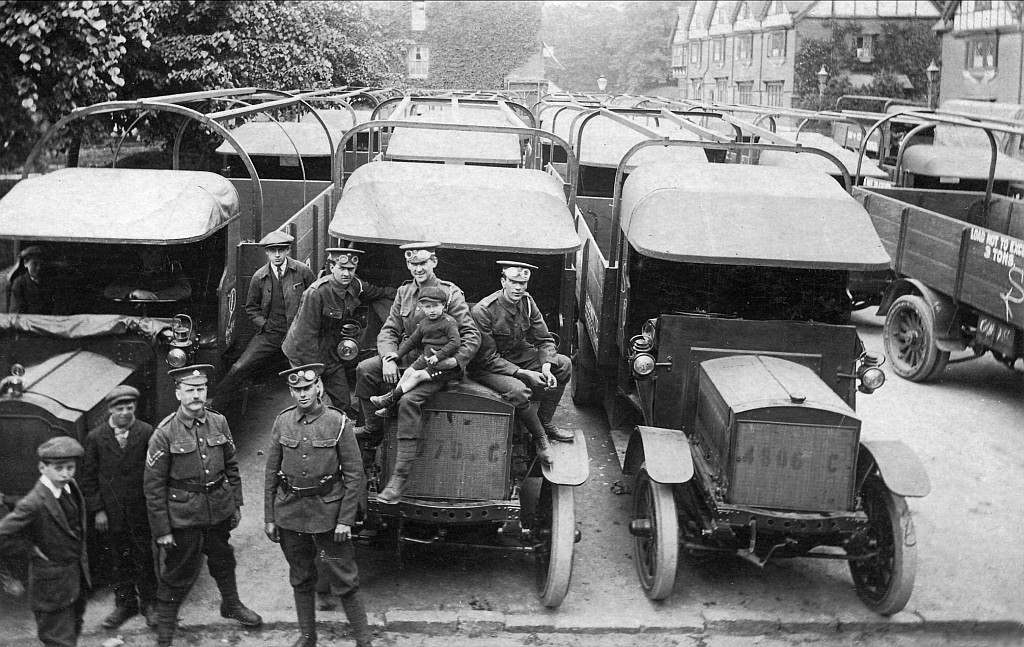
Army lorries in Church Square, Tring.
Sent from 63 Akeman St. on 5 Jul 1915, this postcard
carries the massage that “I'm the one next to the butcher’s boy. . . . extra
good billet, Will.”
|
CUTLER to HAYSTAFF
ERNEST CUTLER
Private, 7th Bn. Norfolk Regiment. Enlisted at Watford.
Service no. 41094
Born in Tring. Son of Corporal A. E. Cutler A.S.C. of 46
King-street, Tring.
Killed in action on the 22nd August 1918.
Buried in Meaulte Military Cemetery, France, grave ref. B. 40.
Ernest Cutler joined the Army in February 1917. He was
attached to the Bedfordshire Regiment and went to France at the
beginning of 1918. Subsequently, he transferred to the Norfolk
Regiment. As a lad, he was a keen member of the YMCA and took part
in their gymnastic displays. |
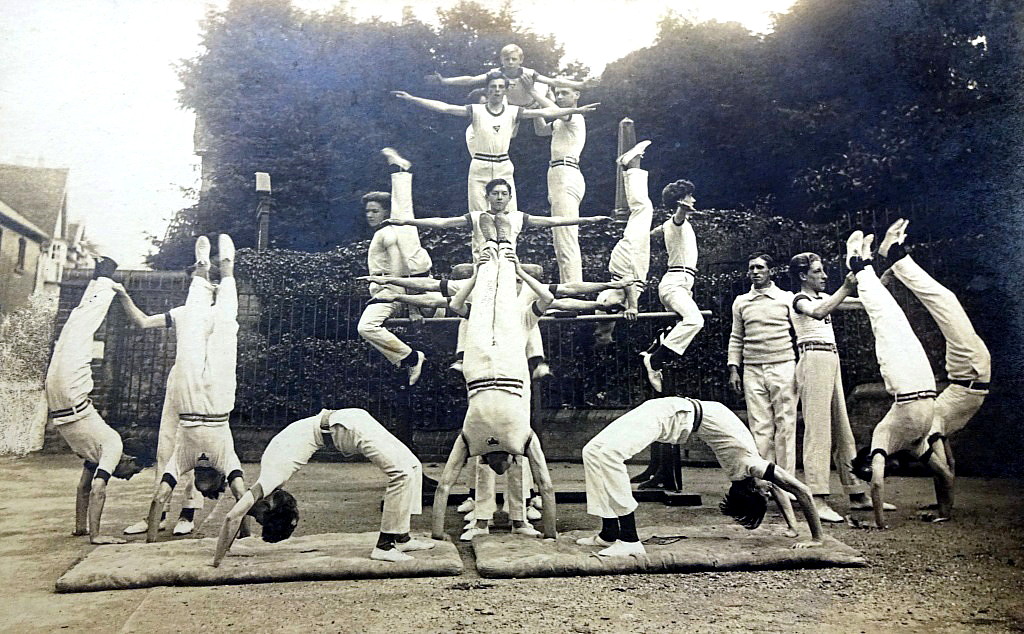
Tring Y.M.C.A. gymnastics display team.
|
The 7th (Service) [Note] Battalion,
Norfolk Regiment was raised in August 1914 from men volunteering for
Kitchener’s New Armies. [Note] The
Battalion landed at Boulogne as part of the 35th Brigade in the
12th (Eastern) Division [Note]
in May 1915 for service on the Western Front. [Note]
In 1918, the Battalion was engaged in
the Battles of the Somme (not to be confused with the infamous
battle fought in 1916). Two Battles of the Somme were fought
in 1918, the Second (21st August–2nd September) being part of a
series of successful counter-offensives in response to the German
Spring Offensive. [Note] The
most significant feature of the two was that while the first battle
halted what had begun as an overwhelming German advance, the second
revered the tide, forming the central part of the Allies’ advance
that ended with the Armistice of the 11th November.
On the 22nd August, the British Third and Fourth Armies commenced
offensive operations on the same ground over which the 1916 Battle
of the Somme was fought. The first of this series of
offensives was the Battle of Albert (21st–23rd August) – the third
battle by that name fought during World War I. The 12th
(Eastern) Division attacked on the 22nd August, pushing right
across the wilderness of the old Somme battlefield, capturing
Meaulte, Mametz, Carnoy, Hardecourt and Faviere Wood, which was
reached after a week’s continuous fighting. Judging from
the date of his death and the location of the 7th Battalion, it is
likely that Private Cutler was killed in this action.
On the 19th August, the 7th Norfolks were at Ville-sur-Ancre, a
commune in the Somme department, Picardy region, of northern France,
some 10 miles from Amiens. This from the Battalion War
Diary:
1918
VILLE SUR ANCRE
19th Aug: a quiet day, the Battalion resting and
bathing in the Ancre.
20th Aug: the Battalion rested as much as possible.
21st Aug: the Battalion on the lft and the 1/1 Cambs
on the right relieved the 9th Essex Regt. in the line tonight.
‘C’ is left front Coy, ‘D’ right front Coy, ‘A’ Support Coy.
The Battalion moved off in this order at 10pm. Batt HQ is at
the old Right Coy. HQ dugout. Our wire is being cut and a tape
laid ready for an attack to be made in the morning.
22nd Aug: Companies moved into assemble position early
this morning the outposts being withdrawn. The enemy is evidently
expecting as attack as his harassing fire including gas has been
considerable. Lewis gun [Note]
fire has been kelp up to allow the approach of tanks being unheard.
The 35th Inf. Bde. is to attack at 4.50 am with the 36th Inf. Bde.
on our left and the 47th Division on our right. The 1st
objective is to be taken by ourselves with the 1/1 Cambs on our
right. The 9th Essex and 6th Buff (attached to 35th Bde.) are
to take the second objective. ‘A’ Coy is to take the trench in
E29C while ‘C’ and ‘D’ Coys will push on to our final objective.
They will then move forward after the Essex and Buffs and
consolidate the second objective.
The attack was successfully launched, assisted by an intense
barrage, [Note]
but the tanks were late going over. O.C. ‘A’ Coy. having taken
the trench at E29C and believing there to be some limitation
[???] in front moved his company
forward. The position remained obscure for some considerable
time, but it appeared that our objective had been taken, but the
Essex and Cambs had not entirely taken theirs. Some confusion
existed and the Commanding Officer reconnoitred the position and was
successful in reorganising the Battalion on its correct line.
The Corps [Note]
Cavalry pushed forward but were unable to make much headway and
eventually withdrew at about 9am. Battalion HQ then moved forward to
K6a. Lieut. Peyton has been killed and 2/Lts. King,
Cuthbertson, Palmer, Irwell [???],
and Prattley wounded. C. Sgt [???]
Jackson has been badly wounded and about 100 OR casualties.
R.E.s and a Company of Northants Pioneers [Note]
have moved up to assist in consolidation and R.E.s are also attached
for testing safety of dugouts.
We are in touch with unit on our left, but apparently the 47th
Division were not entirely successful and our right flank is rather
uncertain.
23rd Aug: the enemy has
counterattacked the Division on our right and two battalions appears
to have fallen back. It has therefore been necessary to form a
defensive flank. This has been done by the Buffs holding the
Brigade front facing North and the Essex and ourselves forming a
line facing East. The Australians have counterattacked on our
right and partly restored the situation. We have advanced our line
facing East.
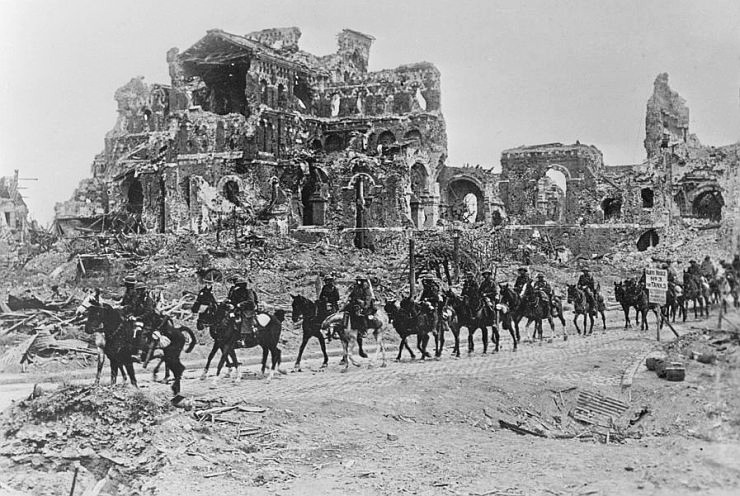
British Cavalry passing the remains of
Albert Cathedral, after the 2nd Battle of the Somme,
22nd August 1918.
From the Bucks Herald, 12th October 1918:
“ROLL OF HONOUR.−
Pte. Ernest Cutler (Norfolk Regt.) was reported killed in France on
Aug. 22, his parents, Corpl. A. E. Cutler, A.S.C.
[Army
Service Corps] and Mrs Cutler,
46, King-street, being officially notified of the fact last week.
Pte. Cutler joined the Army in February of last year, on attaining
the age of 18 years. He went to France at the beginning of the
present year, and had taken part in much heavy fighting. He
was well-known in Tring and highly esteemed. He was a member
of the Y.M.C.A. gymnastic team, and took part in many of the
displays given by them. He was employed at the Empire Cinema
as assistant operator. Much sympathy is felt for Corpl. and Mrs
Cutler in the loss of this their only son.”

Meaulte Military Cemetery.
Meaulte was held by Commonwealth forces (and inhabited by three
quarters of its civilian population) from 1915 to 26th March 1918,
when it was evacuated after a rearguard fight by the 9th (Scottish)
Division. It was recaptured by the 12th (Eastern) Division and
tanks on 22nd August 1918.
The military cemetery, where Private Cutler is buried, was begun in
December 1915 and used until February 1917. Further burials
were made after the recapture of the village and after the Armistice
when graves, mainly of 1918, were brought in from the neighbouring
battlefields and other burial grounds.
――――♦――――
HENRY ARTHUR DAVEY
Private, 6th Bedfordshire Regiment, service no. 12254.
Son of Mrs. Elizabeth Davey, a widow residing at Council-cottages,
Brook-street.
Died of wounds (sustained on the 15th July 1916, Battle of Poizeres) in London on 16th
March 1917.
Buried in Tring Cemetery, grave ref F.30.
In August 1914, the 6th Bn. of the Bedfordshire Regiment was raised
for the duration of the war as part of Lord Kitchener’s first appeal
for 100,000 men to fight for their country. In 1916 they were
engaged in The Battles of The Somme, [Note] specifically at the Battle of Bazentin Ridge (where they lost heavily during their 15th July
assault against Pozières), the Battle of Pozières Ridge in August
and at The Battle of the Ancre in November.
Pozières was a small, straggling village on the main Albert-Bapaume
road. It is situated on high ground that gives the occupier
observation southwards along the road towards Ovillers, La Boisselle,
Albert and beyond; to the east across to High Wood, Delville Wood
and beyond; and westwards to Thiepval. Possession of Pozières
was key to making possible any further advances towards Bapaume, [Note] the
capture of the Thiepval ridge and the breaking of resistance at High
and Delville Woods.
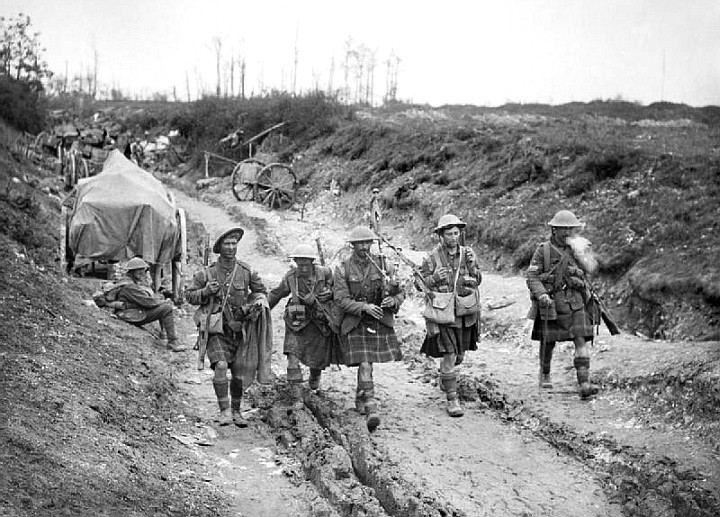
|
Survivors of the 9th
Scottish Division returning from the fight for Longueval
and Delville Wood. The Battle of Bazentin Ridge,
14th July 1916. |
Much fighting was to take place around Pozières. On the 14th
July, the British attacked the German Second Line between the
notorious Delville Wood and Bazentin le Petit Wood. Following
a day of heavy fighting the offensive was renewed on the following
day. Along the main battle lines, infamous places like High
Wood, Delville Wood, Trônes Wood and Longeuval saw ferocious
fighting, with the 112th Brigade (including the 6th Bedfordshires)
being engaged in a flank assault in support of the main battle.
By the end of the day’s fighting, the casualty list was extremely
long, the 6th Bedfordshire alone having lost 330 officers and men.
It seems likely that Private Davey sustained his ultimately fatal
injuries during the 15th July assault on Pozières. The
fighting around Pozières continued into early September. It
was costly, but ended with the British in possession of the plateau
north and east of the village in a position to menace the German
bastion of Thiepval from the rear. The Australian official
historian Charles Bean wrote that Pozières ridge “is more densely
sown with Australian sacrifice than any other place on earth.”
This from the 6th Bedfordshire Regiment War Diary:
15th Jul 1916: Attack on POZIERES by
112th Bde. from trenches S. of CONTALMAISON. Bde. held up by
hostile machine guns, established itself about 100 yds from the
lisiere [on the ‘edge’ of something]
& dug in. Casualties: 3 Offs Killed, 32 O.R. Killed, 25
Missing, 9 Offrs. Wounded, 174 O.R. Wounded.
Formerly employed on the Tring Park estate as a gardener, Private
Davey enlisted at Bedford on the 20th August 1914, aged 20.
From the Bucks Herald, 29th July 1916.
“WOUNDED.− It was
reported in the town on Wednesday that Lieut C J Hartert of the
Machine Gun Section had been wounded. Lieut Hartert is the
only son of Mr E Hartert, curator of Lord Rothschild’s Zoological
Museum, and at the commencement of the war took a commission in the
East Yorks Regiment. Several local names appear in the
recent casualty list of the wounded and slightly wounded.
Private E Gates, Bucks and Oxford Light Infantry, brother of Drummer
Gates, whose death we announced last week, is reported slightly
wounded. Private Arthur Davey’s (Bedfordshire) name is
among the list of wounded.”
According to Army records, Private Davey received a gunshot wound to
the spine on the 15th July 1916, resulting in paraplegia. A
medical board later judged him permanently unfit for both War and
Home Service.
From the Bucks Herald, 17th March 1917:
“DEATH OF PTE.
H. A. DAVEY.− With profound regret the
residents of Tring have heard the announcement of the death in
hospital of Pte. Henry A. Davey, Bedfordshire Regiment, son of Mrs.
Elizabeth Davey, a widow residing at Council-cottages, Brook-street.
The deepest sympathy is felt for the bereaved mother, which is the
deeper because this is the second son that has fallen in the war, an
older one, William, being killed in the Battle of the Somme
[Note] on July
11 last year. Arthur Davey was one of the first to answer his
country’s call, and joined the Bedfords a few days after the
commencement of the war. He proceeded to France and took part
in the battle of Poizeres, on July 16, when he was severely wounded,
a bullet passing almost through his body, fracturing several ribs
and seriously injuring vital organs, the result being almost entire
paralysis of the body and lower limbs. Brought to England, he
lay for eight months in King George’s Hospital, Waterloo, and
succumbed to his terrible injuries on Saturday last, March 10.
As a lad he was an enthusiastic member of the Church Lads’ Brigade,
and for five and a half years he was in the employ of the Rev. H.
Francis (vicar), later being employed on the Tring Park Estate.
He was held in the highest esteem and respect by all with whom he
came in contact. As a member of the local bell-ringers he
rendered good service, and his comrades showed their sympathy by
ringing a muffled peal on the Church bells after the funeral, which
took place on Thursday afternoon, the hospital authorities having
sent the body home for interment in his native town.”
From the Parish Magazine, April 1917:
“Arthur Henry Davey was one of the first to
get into Khaki, and do his bit for King and Country. There is
nothing surprising in this, for, since leaving school, he has been a
keen member of our Church Lads Brigade. In each of the three
occasions when the cup was brought to Tring he was one of the
victorious company. At the Brigade Annual Display, he was
always prominent in the Drill Squad.
In the 6th Bn. of the Bedfordshire Regt, he was a drummer and a very
smart soldier. Very early in the big push on the Somme,
[Note] he was
terribly wounded, and brought to England. He was a patient in
King Georges Hospital in Waterloo Road for some eight months.
It was found impossible to remove a piece of shrapnel from his spine
and he became hopelessly paralysed. He died peacefully on 16th
March 1917. General Bush, readily granted a Military funeral
and Colonel Orlebar, in command of the Bedfords at Halton Camp, gave
instructions for a guard of honour, a Bugler and firing party from
the Bedfords to attend a muffled peal was rung by his old comrades
of the belfry, when his body was borne into the church.”
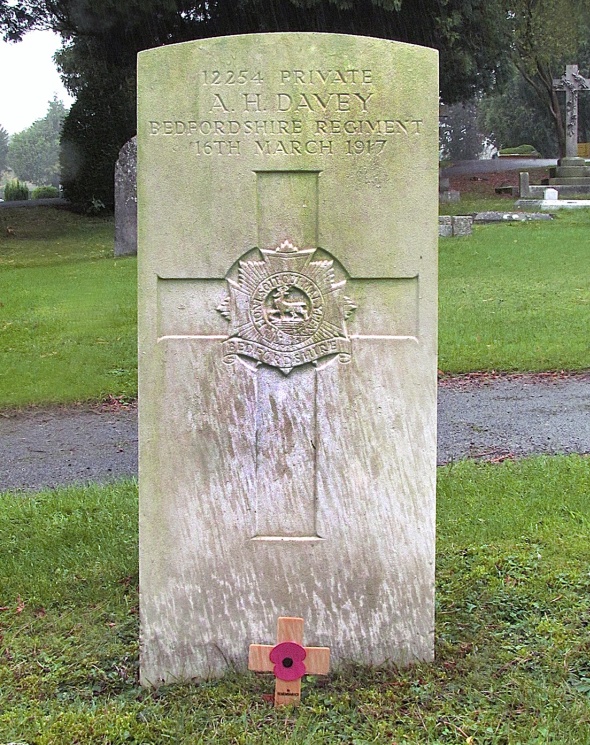
Tring Cemetery, where Private Davey is buried, is managed by Dacorum
Borough Council. It was opened in 1894 on land donated by Lord
Rothschild. The
Cemetery holds a number of war graves from both world wards,
and also one from the recent Afghanistan conflict.
――――♦――――
WILLIAM DAVEY
Private, 2nd Bedfordshire Regiment. Enlisted at Bedford.
Service no. 7288.
Son of Mrs. Elizabeth Davey, a widow residing at Council-cottages,
Brook-street.
Killed in action at the Somme on the 11th July 1916 aged 32.
Buried in Quarry Cemetery, Montauban, France, grave ref. I. G. 4.
William Davey was born in Tring on 10th May 1884. He married
Elizabeth Dealey at Tring Parish Church on the 23rd June 1909, their
ages being 24 and 22 years respectively. Both were then living
at 34 Frogmore Street. The 1911 Census records William, a
labourer, living at 3 Alma Place, Frogmore Street, with his wife
Elizabeth and their three children. Earlier in his life Davey
had served with the Army in India. In August 1914 he left with
the B.E.F [Note] for France. He was later invalided home, but soon after
recovery returned to France.
During 1916, the 2nd Bn. Bedfordshires were engaged in several
phases of The Battle of the Somme,
[Note] namely the Battle of Albert
(including the opening day – 1st July – when their division broke the
German lines), the assault on Trônes Wood (8th-14th July)
and the Battle of Delville Wood (15th July–3rd September), as well as the Battle of Le Transloy
(1st–18th October).
Private William Davey was wounded on the 11th July during one of the
series of actions
at Trônes Wood. It appears that he was making his way back to
a dressing station when he was killed by shellfire.
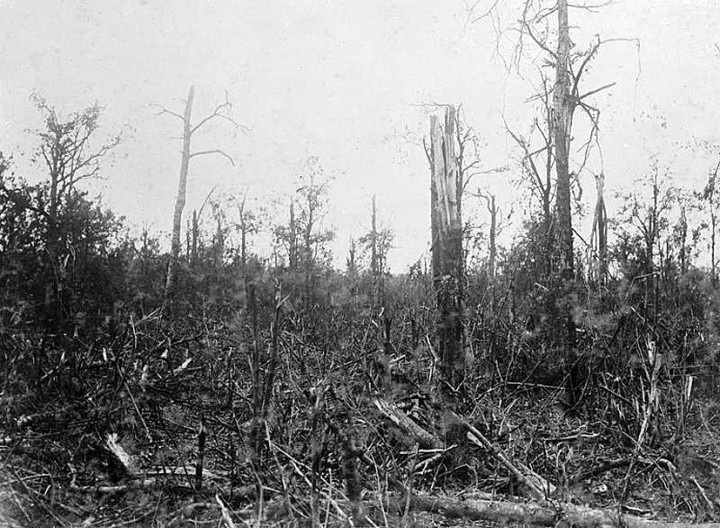
Trônes Wood
The Capture of Trônes Wood was an action fought
during the Battle of the Somme. The Wood lay on the northern
slope of Montauban ridge, between Bernafay Wood and Guillemont. The
British attacks were part of preliminary operations to reach ground
from which to begin the second general attack (14th July) of the
Battle of the Somme against the German second position from Longueval to Bazentin le Petit. The Wood’s dense undergrowth
retarded movement and made it difficult to keep direction.
During the battle the trees brought down by shell-fire became
entangled with barbed-wire and strewn with German and British dead.
The German defenders fought according to a policy of unyielding
defence and immediate counter-attack to regain lost ground.
The following extract if from the War Diary [Note] of the
2nd Bedfordshire Regiment on the day of
Private Davey’s death (11th July, 1916):
“10 July: Battalion in Z.1
trenches. Captain H. A. W. Pearce sprained his ankle and had to go
back to the Transport Lines. Lieut H. A. Chamen then took over
command of ‘B’ Company. At 5 p.m. Orders were received that
the Battalion were to attack TRONES WOOD at 3.27 a.m. on 11th July
and if possible entrench the Eastern side of the wood. The
information handed over by the 90th Brigade was that the wood was
only lightly held by the enemy. Two Battalions had each
previously made two separate attacks on the wood, but had suffered
severely and had been unable to establish a footing in the wood.
On the night of 10th July the Battalion occupied our old Front Line
Trenches of Z.1 Subsector and at 11 p.m. moved up the BRIQUETERIE
ROAD to the SUNKEN ROAD just East of the BRIQUETERIE, which was the
position of deployment for the attack.
11 July: Trones Wood. The Battalion were in position
by 1.30 a.m. formed up in lines of 1/2 Companies with an interval of
five paces between the men, and a distance of 150 yards between
platoons, in the following order: – ‘A’ Company commanded by Captain
C. G. Tyler, ‘B’ Company commanded by Lieutenant Chamen, ‘C’ Company
commanded by Captain L. F. Beal, ‘D’ Company commanded by Captain R.
O. Wynne. Orders had been received that the Battalion was to
enter the wood at 3.27 a.m., so the leading line commenced to
advance at 3.10 a.m. towards the South eastern edge of TRONES WOOD.
It being almost dark, the advance was not observed until the leading
line was 400 yards from the wood, when enemy Machine Guns opened
fire from Points Z and R marked on Sketch (Appendix ‘B’).
The enemy quickly got their artillery to work and the Battalion
suffered many casualties entering the WOOD, but by 3.45 a.m. the
whole Battalion had gained the inside of the WOOD, but owing to
Machine Gun and shell fire, had entered rather too much at the
SOUTHERN END. Owing to the denseness of the undergrowth, it
was not possible to see more than 4 yards in front of you, so the
Companies had great difficulty in keeping touch. Lieut. R. B.
Gibson was killed entering the wood and 2nd Lieut. F. E. Plummer
wounded and it was found that the WOOD was strongly held and full of
Trenches and Dug-outs.
After much fighting inside the wood, part of ‘A’ & ‘B’ Companies,
reached the S.E. edge of the wood and dug themselves in as shown on
Sketch (Appendix ‘B’). ‘C’ and part of ‘D’ Company dug in
along the S.W. edge of the Wood. At 4.20 a.m. 11th July
Captain L. F. Beal with about 27 men of ‘D’ Company and 13 men under
Lieut H. A. Chamen of ‘B’ Company reached the N.E. edge of the Wood
and commenced to dig in. As no British Troops were holding the
Northern end of the wood, this party became isolated and the enemy
were seen advancing from the direction of LONGUEVAL. Captain
Beal finding himself isolated and nearly surrounded withdrew into
LONGUEVAL ALLEY about 9 a.m. After several messages had been
sent to Capt Beal, without success, due to the enemy’s barrage, [Note]
a message eventually got to him with orders to bring his party back
via BERNAFAY WOOD and join up with Capt. Wynne (‘C’ Company) which
was entrenched in the S.E. corner of the WOOD. This was done
at 5 p.m. 11th July.
Great difficulty was experienced organising in the wood owing to
heavy casualties and the denseness of the undergrowth but the
Battalion managed to hold its own, and by 7 p.m. on evening of July
11th ‘A’ & ‘B’ Companies and ‘C’ and 1/2 ‘D’ Companys had dug
themselves in on the S.E. side and S.W. side of the wood (all
Companies much reduced by Casualties).
Whilst the men were digging in, strong patrols worked the interior
of the wood collecting stragglers and bombing the enemy in their
Trenches and Dug-outs, and accounted for a great number. ‘A’ &
‘B’ Companies were leading Companies in the Advance at 3.10 a.m. and
were particularly unfortunate in losing many N.C.O’s on entering the
wood, including the C.S.M. of ‘A’ Company (C.S.M. GALE). 2nd Lieut.
F. E. Plummer was wounded just outside the wood. Both
Companies much reduced by Casualties, worked their way across to the
S.E. corner of the Wood and commenced to dig in.
At about 6 a.m. 11th July Captain C. G. Tyler discovered he was too
far SOUTH of his allotted position, so they moved up the Wood
further North. At 8 a.m. 11th July 2nd Lieut L. H. Fox left
the patrol and went on ahead, but did not return, it is presumed he
was taken prisoner. At 11.30 a.m. 11th July Captain C. G.
Tyler, 2nd Lieut L. H. Walker and 2nd Lieut. D. P. Cross and a
strong patrol of about 40 men endeavoured to work their way
Northwards up the Eastern edge of the wood, but they encountered
strong opposition from a ‘Strong Point’ marked ‘P’ on (Appendix ‘B’)
where the GUILLEMONT Road enters the wood. Captain C. G. Tyler
was severely wounded and ordered the party to withdraw to their
Trench which they did. Captain C. G. Tyler could unfortunately
not be brought in. This trench was held against several
counter attacks, but at 10 p.m., the enemy surrounded and bombed the
trench from three sides, so 2nd Lieut L. H. Walker who was in
command ordered the remainder of ‘A’ & ‘B’ Company to withdraw by
Southern end of TRONES WOOD and make their way back to the
BRIQUETERIE along the Sunken Road. This was done successfully
the party rejoining Headquarters at about 11 p.m., 11th July.
‘C’ Company under Captain R. O. Wynne were the last Company to cross
during the advance. They were to entrench on the Western Side
of the Wood, just North and South of the Tram Line running through
the wood. The Company entered the wood by TRONES ALLEY and
established itself there, one platoon working up towards the
tramline. This Platoon was held up by the enemy near Point ‘H’
as shown on Map (Appendix ‘B’) and forced to withdraw. Three
more attempts were made during the morning, but without success, so
Capt. Wynne decided to entrench where he was. He endeavoured
to get touch will all Companies on the Eastern edge of the wood but
could only get touch with ‘A’ Company.
Other patrols got held up by a ‘Strong Point’ at ‘K’ as shown on
Sketch. At about 6 p.m. 11th July Capt. L.F. Beal with his
party of ‘B’ & ‘D’ Companies joined ‘C’ Company. At about 6.30
p.m., one Company of the 19th Bn. Kings Liverpool Regiment arrived
to clear the southern part of the Wood, but they lost touch and got
badly handled by the Strong Points at ‘K’ and ‘P’. At about 10
p.m. ‘A’ & ‘B’ Coys were forced to withdraw, but ‘C’ & ‘D’ Coys held
Utah against all Counter Attacks. Lieutenant J. W. Hurrell
admitted to Hospital sick.
12th July: Lieutenant W. White and 2nd Lieut L. A. L.
Fink joined Battalion from Reserve of Officers at Transport Lines.
Lieutenant W. White takes over command of ‘A’ Company. At
about 1 a.m. 2 Companies of the 17th Bn. Kings Liverpool Regiment
were ordered to occupy the Southern edge of wood and join up with
‘C’ & ‘D’ Coys. This was successfully done and the Southern
part of the wood was successfully held until relieved by the 7th Bn.
ROYAL WEST KENT REGIMENT (55th Brigade) on the morning on the 13th
at about 1 a.m. in spite of many hostile bombing attacks.
The casualties for this engagement were: – Lieutenant R. B.
Gibson Killed. Captain C. G. Tyler Wounded and Missing.
2nd Lieut L. H. Fox Missing. 2nd Lieut. F. E. Plummer Wounded.
2nd Lieut. H. J. BRICKNELL Wounded. 239 OTHER RANKS.”
From the Bucks Herald, 19th August 1916:
“Private William Davey of the Bedfordshires,
was a married man with a young family, and was serving ‘somewhere in
France.’ His friends received an official intimation that he
was wounded on July 11, and further particulars were promised later.
No further official news has come to hand, but another Tring man
belonging to the same regiment writing to his friends, refers to
Davey’s casualty, and adds that as he was being removed to the
dressing station, Davey was struck by a shell and killed. As
nothing has been heard from Private Davey for six weeks, his family
naturally fear the worst, especially as he was a most regular
correspondent. A younger brother, Arthur Davey, is also
serving with the Bedfordshires, and was badly wounded on the same
day as William. Though the two brothers have been near each
other in France for some time, they have never met out there.
Whenever the one’s company was in the trenches, the other’s was
resting.”

Montauban village was taken by the 30th and 18th Divisions on 1st
July 1916 and it remained in Commonwealth hands until the end of
March 1918. It was retaken on 25th August 1918 by the 7th
Buffs and the 11th Royal Fusiliers of the 18th Division.
Quarry Cemetery was begun as an advanced dressing station in July
1916, and used until February 1917. The Germans buried a few
of their dead in Plot V in April and May 1918. At the
Armistice it consisted of 152 graves in the present Plots V and VI.
It was then increased when graves (almost all of July-December 1916)
were brought in from the battlefields surrounding Montauban and
small burial grounds.
――――♦――――
SIDNEY CHARLES DAWE, M.C.
Captain, 5th Bn. Lincolnshire Regiment.
Son of Arthur Henry and Elizabeth Annie of ‘Thornhill’, 12 Boxwell
Road, Berkhamsted.
Accidentally killed on 13th February 1918 aged 20.
Buried in Fins New British Cemetery, France, grave ref. IV. B. 10.
From page 289 of The History of the Lincolnshire Regiment 1914-18
by Major-General C. R. Simpson C.B.:
On the 31st [March 1917]
the Croisilles-Henin road was finally cleared of the enemy.
This was not done without some difficulty, for, though on the left
the line of the road was gained without opposition, on the right the
enemy sniped for a considerable time and then attempted to drive the
Lincolnshire out by a bombing attack. This attack met with a
certain measure of local success till it was checked chiefly owing
to the gallantry of Lieutenant Dawe. This officer, though
wounded in the wrist, remained for two and a half hours at the
forward post, and by the energetic use of his Lewis gun [Note]
drove off the Germans, who had a machine-gun with them. The
1st Lincolnshire had two officers and fourteen other ranks wounded
in this affair.
From the Bucks Herald, 2nd June 1917:
“MILITARY CROSS.
− Second Lieut. Sidney Charles Dawe, Lincs. Regiment, son of Mr. and
Mrs. A. H. Dawe, High-street, has been awarded the Military Cross
for gallantry in action. General Haig,
[Note] in his dispatches,
states of this young officer: ‘He led his platoon in the most
gallant manner, and inflicted heavy casualties on the enemy. Later,
although wounded, he remained at his post until the position was
consolidated.’
Lieut. Sidney Dawe is the youngest of three sons serving, all of
whom hold commissions. He is only 19 years of age, and
obtained his commission from the Officer Training Corps, Berkhamsted
School, where he received his education at St John’s House. A
number of congratulatory letters have been received by Mr. and Mrs.
Dawe, among them being one from Mr. H. B. Herbert, one of the
masters at the school, expressing the pride felt by the ‘old boys.’
Lieut. Dawe was wounded in the left wrist, and is at present in
hospital in England making a good recovery.”
From the Parish Magazine, March 1918:
“Captain Sydney Charles Dawe M.C., 5th BN
Lincolnshire Regt, was accidentally killed on 13th February in
France. He joined the Artists Rifles in May of 1915, when he was 17
years of age. He was commissioned into the Lincolnshire Reg as
a 2nd Lieut in the 1st Bn in October 1915. He went to France
in November, but returned for further training in November 1916.
He returned to the front. He was wounded in the left wrist in
April of 1917 and was awarded the Military Cross for Gallantry
during this action. The citation reads:
‘He led his platoon in the most gallant manner, and inflicted heavy
casualties on the enemy. Later, although wounded, he remained at his
post until the position was consolidated.’
His Colonel writing to his parents said:
‘I have only recently known your son, but in that short time, I have
formed a high opinion of his abilities, his reputation in the
battalion, as an Officer, stood high, and I was told that the Award
of his Military Cross was one of the finest ever won in the
Battalion. I think you will understand what that means.
Your son was very popular with everyone, and was a most capable
officer, extremely gallant, and absolutely, dependable.
Personally, I know that I have lost one of my best company
commanders, and, on behalf of myself and the whole battalion, I want
you to accept this expression of our deepest regret. You have
the consolation of knowing in what regard he was held by his brother
officers, how well he did his duty, and how splendidly he maintained
the traditions of the regiment. We buried him, this afternoon
with full military honours in a cemetery about three miles from
here. All officers and men of the battalion, who were not on
duty, attended the funeral.’”
The circumstances of Captain Dawe’s
accidental death are referred to on page 289 of The History
of the Lincolnshire Regiment 1914-18 by Major-General C. R.
Simpson C.B.:
“Only one officer casualty is recorded for
the month: Captain S. C. Dawe was found dead on the rifle range on
the 14th. It was presumed he met his death by accident.”
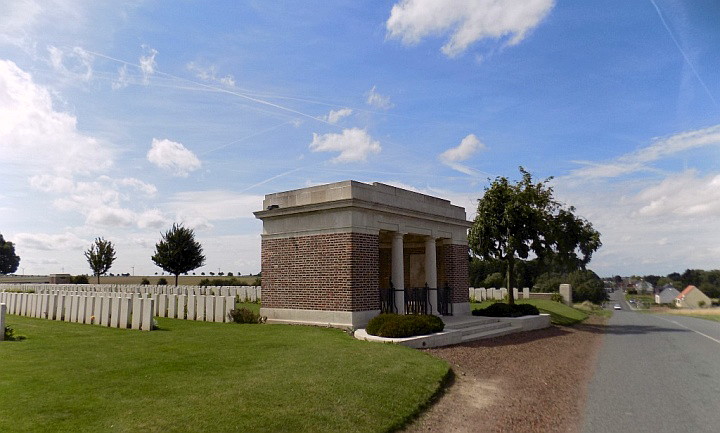
Fins and Sorel were occupied at the beginning of April 1917, in the
German Retreat to the Hindenburg Line. They were lost on the
23rd March 1918, after a stubborn defence of Sorel by the 6th
K.O.S.B. and the staff of the South African Brigade; and they were
regained in the following September.
The first British burials at Fins were carried out in the Churchyard
and the Churchyard Extension, and the New British Cemetery was not
begun until July 1917. It was used by fighting units
(especially the 40th, 61st (South Midland) and 9th (Scottish)
Divisions) and Field Ambulances until March, 1918, when it comprised
about 590 graves in Plots I to IV. It was then used by the
Germans, who added 255 burials, including 26 British, in Plots IV,
V, and VI. In September and October 1918, about 73 British
soldiers were buried by the 33rd and other Divisions, partly in
Plots I and II, but mainly in Plots V and VI. Lastly, Plots
VII and VIII were made, and other Plots completed, by the
concentration of 591 graves after Armistice from the surrounding
battlefields and from other smaller cemeteries.
――――♦――――
WILLIAM CLEMENT DELL
Rifleman, 12th Bn. King’s Royal Rifle Corps, formerly with the
Cambridge Regiment.
Enlisted at Watford, service no. A/200570.
Married man living in Duckmore Lane, Tring.
Killed in action on the 23rd September 1917.
No known grave. Commemorated on the Tyne Cot Memorial,
Belgium,
panels 115 to 119 and 162A and 163A.
The 12th (Service) Battalion, King’s Royal Rifle Corps, was raised
at Winchester on the 21st of September 1914 as part of Kitchener’s
Second New Army. During 1917, the battalion were in action in
‘The German retreat to the Hindenburg Line’, The Battle of
Langemarck, The Battle of the Menin Road Ridge, The
Battle of Polygon Wood and The Cambrai Operations.
In the absence of specific information on his fate, one is left to
conjecture using Rifleman Dell’s date of death and battalion
details. On this basis it appears likely that he was killed
during the Battle of the Menin Road Ridge, part of the Third Battle of
Ypres (Passchendaele), which took place between the 20th and 25th September,
1917.
During the pause in British and French general attacks between late
August and the 20th September, the British changed some infantry
tactics, adopting the leap-frog method of advance, where waves of
infantry stopped once they reached their objective and consolidated
the ground − the “bite and hold” strategy − while other waves passed
through the objective to attack the next one, and the earlier waves
became the tactical reserve. [Note]
In early September, optimism among German commanders that the
British offensive in Flanders had run out of steam caused them to
transfer resources elsewhere. Drier weather and extensive road
repairs made it much easier for the British to move supplies forward
from the original front line. Visibility increased except for
frequent ground fog around dawn, which helped conceal British
infantry during the attack, before clearing to expose German troop
movements to British observation and attack.
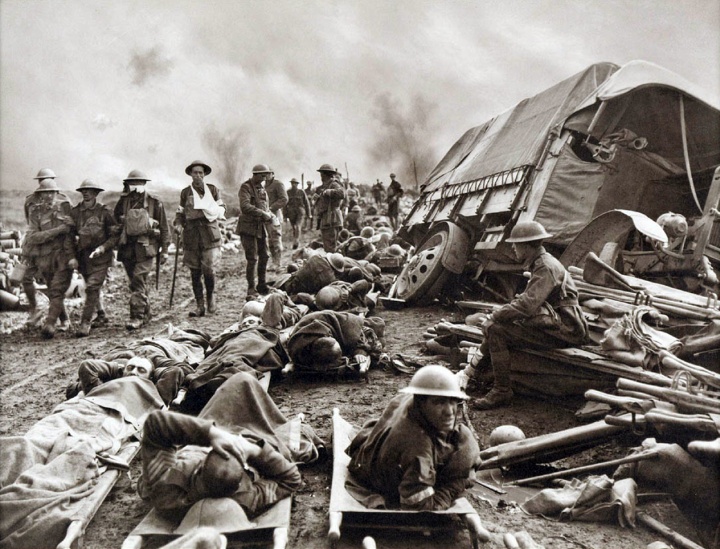
Battle of Menin Road − part of the Third
Battle of Ypres − wounded at the roadside.
Having hit small sectors of the German front line with heavy
bombardment, the British attacked in strength, stopping their
advance and consolidating once they had penetrated beyond the German
front line. The outcome was that the infantry succeeded in
capturing most of their objectives and then holding them against
German counter-attacks, inflicting many casualties on the local
defenders and divisions sent to reinforce them. Given the
right preparation, the Battle of Menin Road proved the value of bite
and hold tactics.
During this action, the 12th King’s Royal Rifle Corps was
engaged in the attack on Eagle Trench, a strongly fortified position
near Langemarck held by the Germans. The task of driving them
out initially fell to the 11th Rifle Brigade, 12th Rifle Brigade,
and 6th Oxfordshire and Buckinghamshire Light Infantry.
The 12th Rifles and the Light Infantry took Eagle Farm and moved on
to seize the southern end of Eagle Trench, the 11th Rifles losing
two-thirds of their men before securing a section of the trench.
For three days Eagle Trench was divided between the Germans and the
British. On the 23rd September the 10th Rifle Brigade and
12th King’s Royal Rifle Corps assaulted the German section
capturing the remainder of the trench. This from the Battalion
War Diary: |
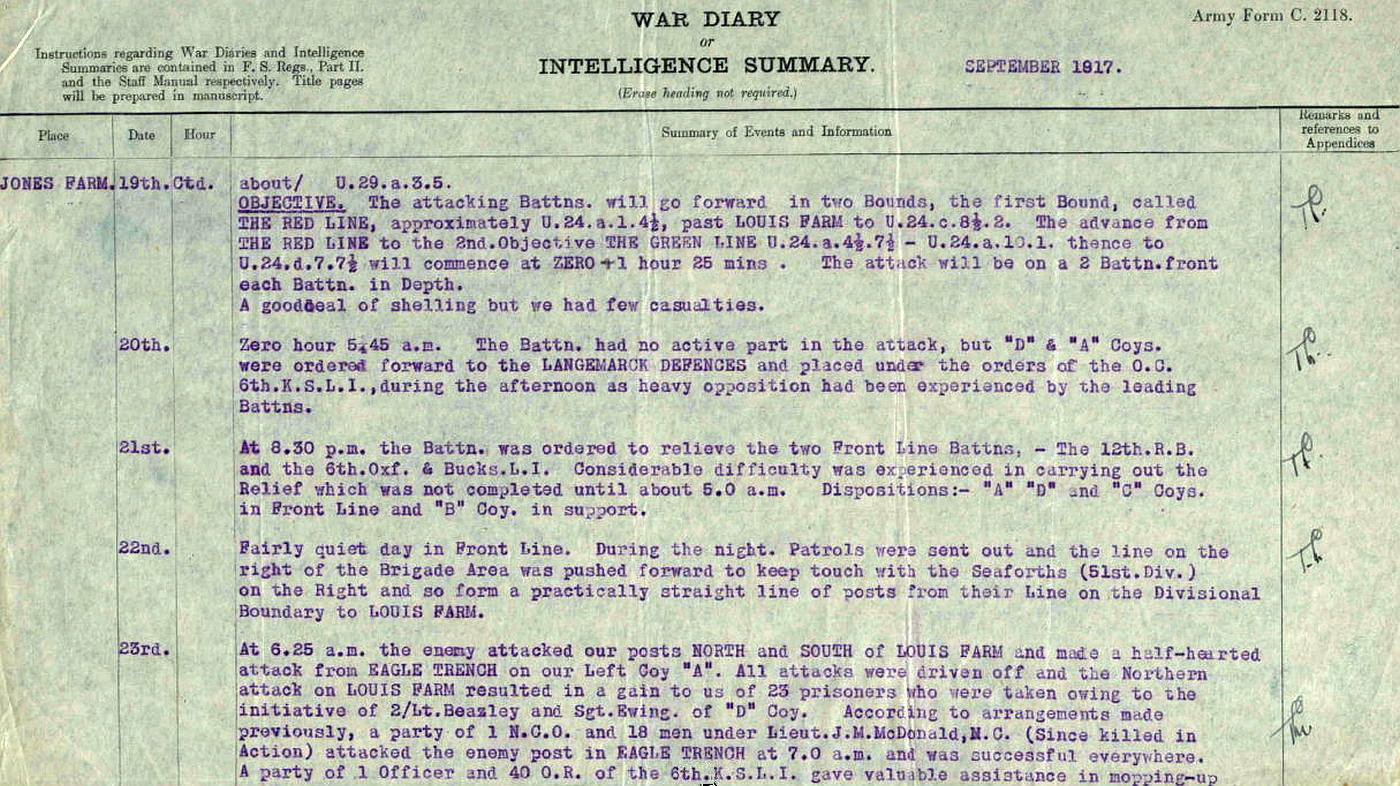
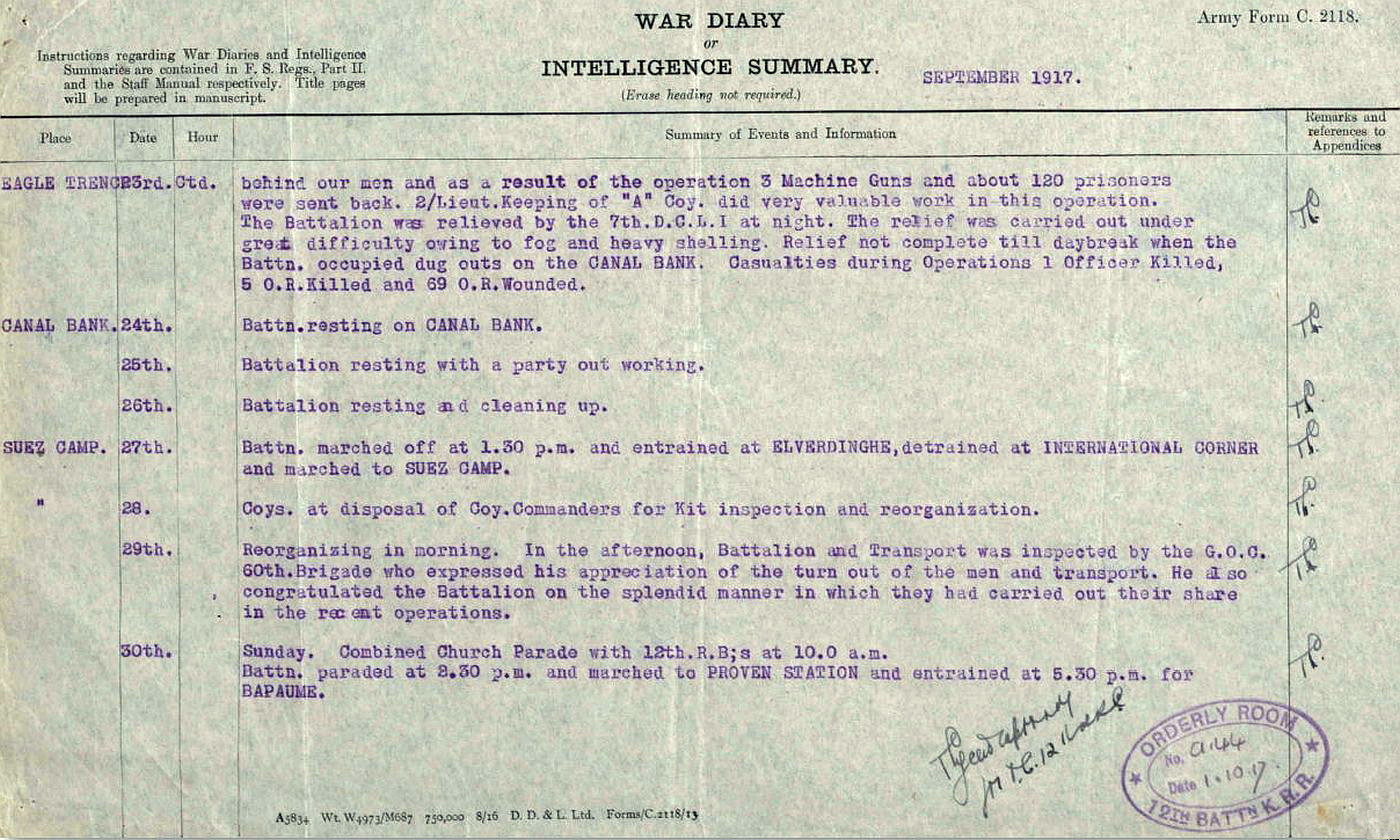
|
From the Bucks Herald, 20th October 1917:
“ROLL OF HONOUR.−
We have this week to announce with deep regret the loss of . . . .
Rifleman Dell, King’s Royal Rifles, of Duckmore-lane, who was killed
on Sept. 23, leaves a wife and four young children. Before
enlisting he was employed at the Home Farm, Tring Park.”
Unattributed and undated information, perhaps from the Tring Church
Magazine:
“William Clement Dell 12th Bn. K.R.R.C. was
killed in action in France, 23rd September 1917. He enlisted
in June of 1916 and went to France in September of that year.
A friend, writing to his wife, says, ‘He was killed instantly by a
Shell burst. His body was buried behind the line.’ It
would appear that the position of the grave was lost, and he is
commemorated on the Tyne Cot Memorial.”

Commemorative plaques on the Tyne Cot
Memorial to the Missing.
The name “Tyne Cot” is said to come from the Northumberland
Fusiliers seeing a resemblance between the many German concrete pill
boxes on this site and typical Tyneside workers’ cottages (Tyne
cots). The stone wall surrounding the cemetery makes-up the
Tyne Cot Memorial to the Missing. Upon completion of the Menin
Gate Memorial to the missing in Ypres, its builders discovered it
was not large enough to contain all the names as originally planned,
so they selected an arbitrary cut-off date of the 15th August 1917
and the names of the U.K. missing after this date were inscribed on
the Tyne Cot Memorial instead.
――――♦――――
STANLEY DUNTON
Enlisted at Harrow. Private, 3rd Bn. Middlesex Regiment.
Service no. G/7623.
Born in Tring. Son of Frederick and Elizabeth Dunton, 17 Henry
Street, Tring.
Killed in action on 30th September 1915 aged 19.
No known grave. Commemorated on Loos Memorial, France, panel 99 to
101.
The 3rd Battalion, The Middlesex Regiment (Duke of Cambridge’s Own) was in
Cawnpore, India, when war broke out in August 1914. As soon as
a territorial unit arrived to take over the garrison they returned
to England, arriving in December and joining the 85th Brigade in
the 28th
Division, who were assembling near Winchester. They then
proceeded to France, landing at Le Havre on the 19th
of January 1915. The Division concentrated in the area between Bailleul and Hazebrouck, being joined by additional Territorial
units.
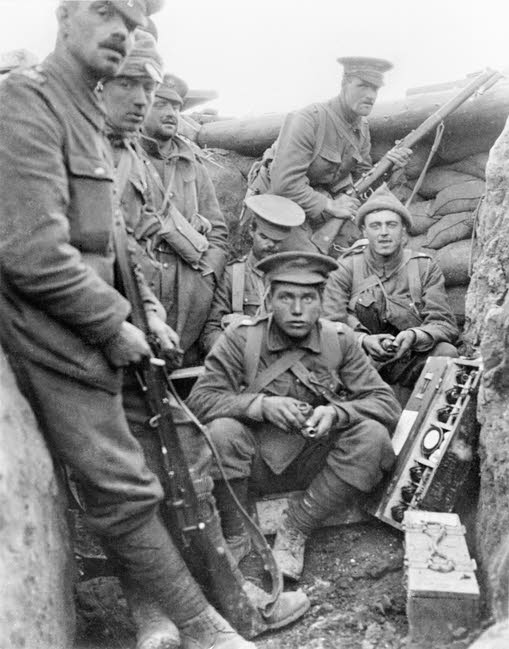
British soldiers in the trenches, Battle
of Loos, September 1915.
Steel helmets were not introduced into
the British Army until April 1916.
Between the 29th September and 1st October 1915 the 3rd Middlesex were
in action at the Battle of Loos. The biggest British attack of
1915, it took place between the 25th September and the 13th October
and was the first mass engagement of Kitchener’s New Army units. [Note]
It attempted to break through the German defences in Artois and
Champagne and restore a war of movement, but despite improved
methods, more ammunition and better equipment, the attacks were
almost entirely contained with British casualties being about twice
as high as those of the Germans. Summing up the first day’s
action in a letter to Lord Stamfordham (King George V’s
private secretary), the IV Corps [Note] commander, Lieutenant-General Sir
Henry Rawlinson, reported progress thus:
“Some of the divisions did actually reach
the enemy’s trenches, for their bodies can now be seen on the barbed
wire.”
In the first four hours of the battle the twelve attacking
battalions suffered 8,000 casualties out of 10,000 men.
During the battle, the 3rd Middlesex was involved in heavy fighting
at the Hohenzollern Redoubt, a defensive strongpoint of the German
6th Army. When relieved on the 1st October the Battalion
had lost 6 officers killed, 2 wounded and 24 other ranks killed, 189
wounded and 88 missing. It must be assumed that Private Dunton
was among the fatalities. This from the Bucks Herald, 21st October 1916:
“Our Roll Of Honour. Stanley Dunton
who joined the 9th Middlesex at the commencement of the war and was
transferred to the 3rd Middlesex, has been missing since 30th
September 1915 and the War Office now definitely report him as dead.
He was 19 years of age and had been in France about five months.
He was at one time a choirboy at the Parish Church and a member of
the Church Lads’ Brigade.”
From the Parish Magazine, November 1916:
“Stanley Dunton has been missing since
September 30th 1915 and nothing has been heard of him since. He is
now supposed by the War Office to have been killed about that date.
Early in the war he heard the call of King and Country and joined
the 9th Middlesex, being later transferred to the 3rd Btn. Middx.
It does not seem long ago that he was singing as a boy in our Parish
Church choir, and taking part in the musical drills at the Church
Lads’ Brigade winter Entertainments. May he rest in peace.”
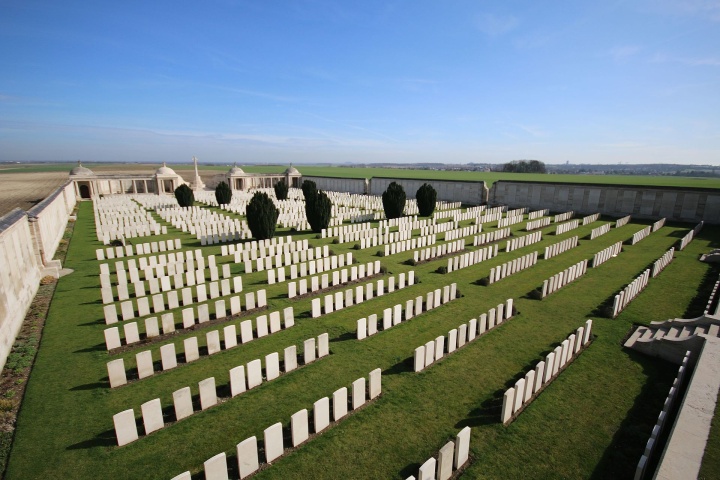
The Loos Memorial is formed by the side and rear walls of the Dud
Corner Cemetery located in the Pas-de-Calais. The memorial
lists the names of 20,610 British and Commonwealth soldiers with no
known grave who were killed in the area during and after the Battle
of Loos.
――――♦――――
STANLEY RUMBALL EGGLETON
Staff Sergeant, 7th Field Ambulance Australian Army Medical Corps.
service no. 3623.
Died of wounds on 8th October 1917.
Buried in Poperinge New Military Cemetery, Belgium, grave ref. II. J. 21.
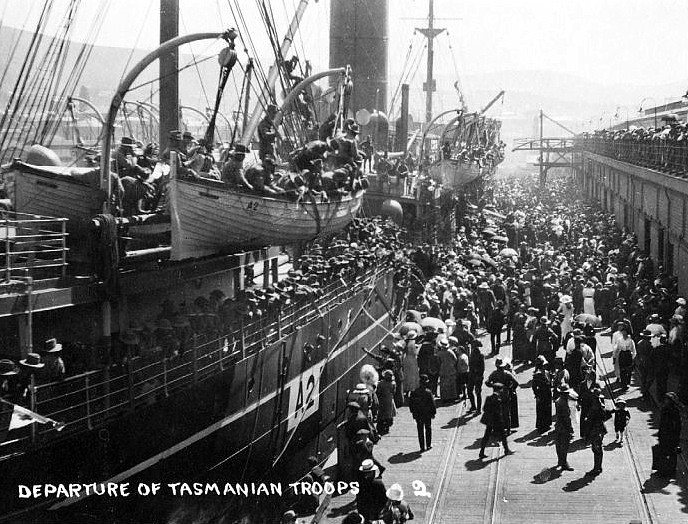
The first Tasmanian contingent of troops
prepare for the departure of
HMAT A2 Geelong, 20th October 1914.
The Geelong − the ship in which Staff Sergeant Eggleton left
Australia for the ill-fated Gallipoli campaign − was owned
originally by the Blue Anchor Line, then after 1910 by P&O.
During World War I it was leased to the Australian Government to
transport the Australian Imperial Force to the Middle East and to
Europe. As a troopship she was designated HMAT A2 Geelong.
On her second outbound trooping voyage, the Geelong left
Adelaide on 31st May 1915 with 1,264 soldiers of the 27th Infantry
Battalion and the 7th Field Ambulance unit on board.
A Field Ambulance was a mobile front line medical unit manned by
troops of, in this case, the Australian Army Medical Corps.
Most Field Ambulances came under the command of a Division, and each
had special responsibility for the care of casualties of one of the
Division’s Brigades. The theoretical capacity of a Field
Ambulance was 150 casualties, but in battle many often needed to
deal with far greater numbers. The 7th Australian Field
Ambulance − to which Staff Sergeant Eggleton was attached − formed
part of the Australian 2nd Division. The Division fought at
Gallipoli during the latter stages of the campaign following which
it was posted to the Western Front [Note] in France where it was the last
Australian division to see combat.
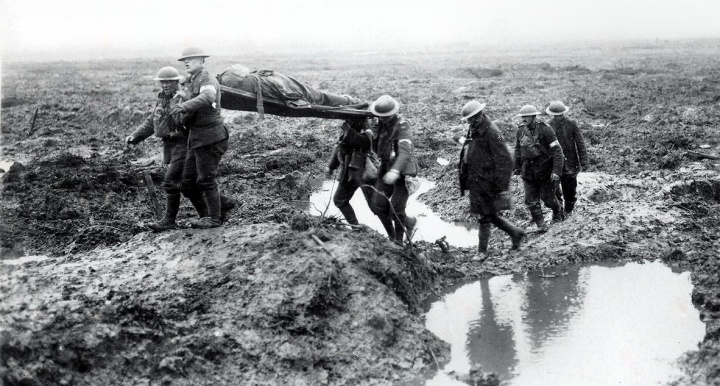
Wounded soldiers on their way to an
aid-post during the 2nd Battle of Passchendaele.
There are no details of the action in which Staff Sergeant Eggleton
was killed, but conjecture suggests it was during the Third Battle
of Ypres (Passchendaele) in which Australian involvement is well
chronicled. During Third Ypres, the Australian 2nd Division
sustained casualties at the Battle of Menin Road (20th-25th
September), the Battle of Polygon Wood (26th-28th September), the
Battle of Broodseinde (4th October), the Battle of Poelcapelle (9th
October), and the Second Battle of Passchendaele (26th October–10th
November).
Staff Sergeant Eggleton’s death is recorded in the 7th Field
Ambulance War Diary, which merely states that on the 8th
October “S/Sgt. Eggleton died of wounds. 3 ORs wounded” (it
also records that from the 3rd to the 5th October 4 ORs were
wounded). It states that he died at Waratah Rest Station, but
gives no indication of how he received his wounds. However,
another member of the Australian forces, Lance Corporal William
Dalton Lycett of the 4th Field Ambulance, kept a personal diary that
has survived. He too was at Waratah on the 8th October 1917,
and this is what he records in his diary:
“Monday 8th October, 1917.
Fritz put over few shells not far from here during night. Up
at 7 a.m. and at work as usual. Looked like nice day at first,
but turned out rotten, rained hard. Fritz put some heavy
shells near here during day, some fell in Waratah hospital camp
killing and wounding patients, a doctor killed also. After
tea wrote a letter home and did some odd jobs, raining very hard
tonight. Fritz balloon brought down today. In bed 9
p.m.”
In the absence of firmer evidence it would appear that Staff
Sergeant Eggleton was killed as a result of German shelling.
This from the Bucks Herald, 27th October 1917:
“ROLL OF HONOUR.−
We regret to hear that news has been received of the death from
wounds of Sgt.-Maj. Stanley Eggleton, of the Australian Medical
Corps. Before proceeding to Australia in 1912, Eggleton was employed
at the establishment of Mr. E. K. Fulks, draper and outfitter, and
resided with his parents at Crouch’s Farm”
[Crouch’s Farm is the present day Miswell
Farm].
From the Parish Magazine, November 1917:
“Stanley Eggleton S/Sgt Australian RAMC
died o wounds, which he received, whilst caring for the wounded, on
October 8th 1917. As a youngster, he sang in the choir at St
Martha’s and for over five years was a member of the Church Lads’
Brigade. He was confirmed at Wiggington in the spring of 1905
and made his first communion at our parish church on Easter Day of
the same year. He has been a faithful communicant in different
parts of the world. For some time he was a member of the amen
court guild at St Pauls Cathedral and a server at the Altar of the
church in the parish where he was living.
Owing to lung trouble, he emigrated to Australia, and found his
health once again in the Southern Hemisphere. Early in the
war, he heard the call to service. He was in one of the early
Anzac Soldiers who landed in Egypt and afterwards moved to
Gallipoli. One of his Australian chums, in writing to his
mother says ‘what a terrible gap his death has made in our ranks, he
was always so cheerful and bright, he had a smile for everyone.’
Mr Howard Williams, his former employer in London, writes of him ‘he
will leave a choice possession in the hearts of all his friends
here, and we shall think of him as a bright happy fellow, a general
favourite, who feared God and was always true and loyal. No
hero ever left a fairer, clearer record behind him than your Boy.
R.I.P.’
A further letter received by the family from his medical unit, says:
‘He had the longest service of any of the sergeants in the field
ambulance and yet he was the best loved and respected of all.
He knew his men, and those who worked under him would testify to his
marked ability and to the fact that it was indeed a pleasure to work
for him. The patient never forgot his kindly manner and
cheerful disposition. He had an amazing memory for dates and
places, he never forgot a face. He extolled an atmosphere of
brightness and humour, during the many hours of irksome tasks
undertaken by all in our unit. We assure you that he will be
greatly missed, and it was with heavy hears that we stood at his
graveside while Chaplain Muschamp C.E. committed his body to the
grave. We are erecting a cross truly sacred to the memory of
Stanley Eggleton.’”
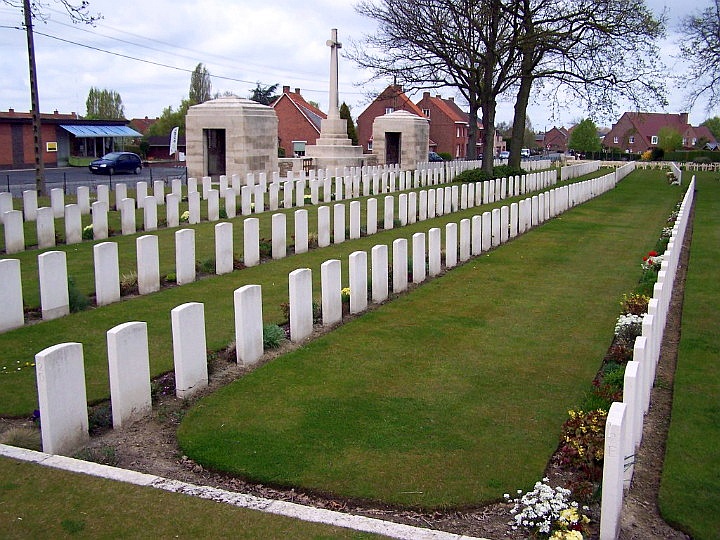
The town of Poperinghe (now Poperinge) was of great importance
during the First World War because, although occasionally bombed or
bombarded at long range, it was the nearest place to Ypres, which
was considerable in size and reasonably safe. It was at first
a centre for Casualty Clearing Stations, but by 1916 it became
necessary to move these units further back and field ambulances took
their places.
The earliest Commonwealth graves in the town are in the communal
cemetery. The Old Military Cemetery was made in the course of
the First Battle of Ypres and was closed, so far as Commonwealth
burials are concerned, at the beginning of May 1915. The New
Military Cemetery was established in June 1915.
――――♦――――
JOHN FENEMORE, M.M.
Sergeant, 64th Machine Gun Corps, service no. 8764.
Son of Thomas and Mary Fenemore. Born at New Mill, Tring.
Enlisted at Watford, formerly with the Bedfordshire Regiment.
Killed in action on 15th July 1916, aged 22.
Buried in Caterpillar Valley Cemetery, France, grave ref. X. F. 34.
John Fenemore was the third eldest of Thomas Fenemore’s five
children (there was also an adopted daughter). The 1911 Census
lists his father’s occupation as “Tree falling [sic] on
estate,” and that of John, then aged 16, as “Cowman on farm.”
At the time the family lived at 11 Langdon Street, Tring.
John’s mother is not listed as an occupant at the address, although
his father describes his own status as “married.”
Thomas’s eldest daughter Elizabeth (aged 21) gives her occupation of
“house keeping.”
The Machine Gun Corps (MGC) [Note] of the British Army, to which
Sergeant Fenemore was attached, was formed in October 1915 in
response to the need for more effective use of machine guns on the
Western Front. [Note] After its
formation at Grantham, the 64th Machine Gun Company moved to France
and, on the 4th March 1916, joined the 64th Brigade in the 21st Division at Armentieres.
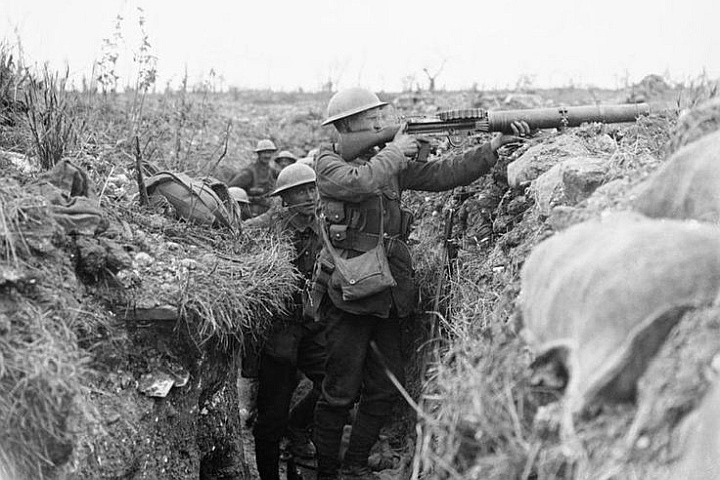
A Lewis gunner
[Note].
The 21st Division had been established in September 1914 as part of
Kitchener’s Third New Army. [Note] Initially, it concentrated in the
Tring area, spending some time in camp at Halton Park before winter
necessitated a move into billets in Tring and the local area before
returning to Halton Park in May 1915. In September, the
Division moved to France. Soon after landing, lengthy forced
marches brought the Division into the reserve for the British
assault at Loos, before it was sent into action on 26th September to
suffer over 3,800 casualties for very little gain.
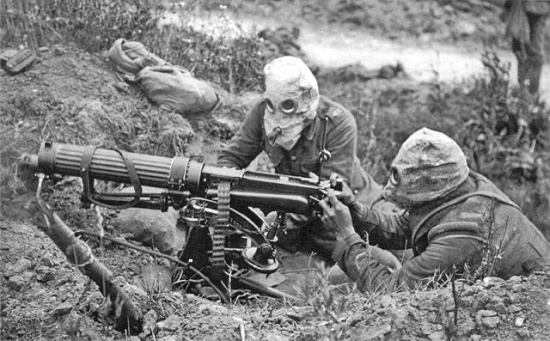
|
A Vickers machine gun crew.
The British Army Vickers
water-cooled .303 machine gun typically required a six
to eight-man team to operate: one fired, one fed the
ammunition, the rest helped to carry the weapon, its
ammunition and spare parts. Its rate of fire was 450 to
500 rounds/min and its effective range 2,187 yds.
The gun remained in service with the British Army until
1968. |
During the Battles of The Somme, [Note] the 21st was in action in (among
other battles) the Battle of Bazentin Ridge (14th–17th July);
judging from its dates and that of his death, this was possibly the
action in which Sergeant Fenemore was killed.
The objectives of this British attack were the villages of Bazentin
le Petit, Bazentin le Grand and Longueval. At 3:25 a.m., after
an intense five-minute artillery bombardment, four divisions
attacked on a front of 6,000 yd. Field artillery [Note] fired a
creeping barrage [Note] which the attacking waves followed close behind in
no man’s land, leaving them only a short distance to cross when the
barrage lifted from the German front trench. The German
defenders, surprised by the shortness of the bombardment and
proximity of the attacking waves, gave way and leading British
battalions quickly reached the front line, pressing on beyond.
Most of the attack’s objectives were captured putting the German
defence south of the Albert–Bapaume under great strain, but the
attack was not followed up due to British communication failures,
casualties and disorganisation. In the action, 21st Division
suffered 2,894 casualties.
From the Bucks Herald, 19th August 1916:
“Sergeant John Fenemore, of the Machine Gun
Corps, son of Mr. and Mrs. J. Fenemore, of Gamnel-terrace, is
reported to have been killed in action on July 15. No
particulars are jet to hand.
Fenemore joined the East Surrey Regiment at the outbreak of was, and
rapidly rose to the rank of sergeant. He was transferred to
the Machine Gun Corps, and sent to the Hythe School of Musketry for
a course of instruction. He passed through the course with
distinction, and was sent to Grantham as musketry instructor.
In February last he was drafted to France. ‘Jack’ Fenemore was
a bright boy, and is well remembered in Tring; he was long a keen
and enthusiastic member of the Church Lads’ Brigade.”

The Military Medal.
From the Parish Magazine September 1916:
“Sergeant John Fenemore joined the East
Surrey Regiment at the commence of the war, and from the first, as
he said, felt the benefit of his training in the Church Lads’
Brigade, for he rapidly rose to the rank of Sergeant. He was
keen to join the machine gunners and was passed in training with
distinction and became a musketry instructor at Gratham. In
the February of 1916, he as posted to France. It was on the
14th/15th July that he was killed having previously been in action
earlier in July at the commencement of the Somme offensive.
In a letter to his parents a friend of John Fennimore wrote: ‘it was
the second time in the great push. His death was
instantaneous, Jack was awarded the Military Medal for very good
work at this time. How nice it would have been for him to have
received the honour personally. He has been with me ever since
we joined the machine gun corps and I will miss him as will all his
comrades in the Corps. He was a thoroughly reliable officer
and a great influence to those of our unit.’”
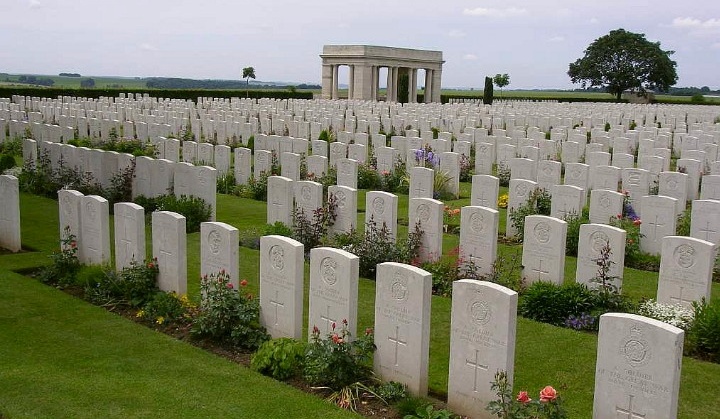
The ground of Caterpillar Valley Cemetery was captured, after very
fierce fighting, in the latter part of July 1916. It was lost in the
German advance of March 1918 and recovered by the 38th (Welsh)
Division on 28th August 1918, when a little cemetery was made
containing 25 graves of the 38th Division and the 6th Dragoon
Guards. After the Armistice, this cemetery was hugely increased when
the graves of more than 5,500 officers and men were brought in from
other small cemeteries, and the battlefields of the Somme. The great
majority of these soldiers died in the autumn of 1916 and almost all
the rest in August or September 1918.
――――♦――――
LAWRENCE HENRY FENNER
Private, 5th Bn. Canadian Infantry, service no. 1018606.
Son of Henry and Alice of Pendley Lodge.
Badly gassed in France, November 1917. Died on 12th October
1918, aged 29.
Buried in Bramshott (St Mary) Churchyard, Hampshire, grave ref. III.
C. 12.
The 5th Battalion was authorized on 10th August 1914 and embarked
for the U.K. on 29th September 1915. It entered the theatre of
operations in France on 14th February 1915, where it fought as part
of the 2nd Infantry Brigade, 1st Canadian Division, in France and
Flanders until the end of the war.
Extracted from the Report on operations of the 5th Canadian Infantry
Bn., from the 4th to the 12th November, 1917:
“On account of the miry conditions of the
ground the work of evacuating wounded was very slow and even the
numerous large parties were unable to clear them all until 48 hours
after the attack had been launched. The Regimental Aid Posts
in pill boxes were heavily shelled . . . .
Each man carried 48 hours rations besides his Iron Rations and one
trench cooker. Two filled bottles of water. 100 tins of
water were brought up on pack mules to WATERLOO FARM and then
distributed evenly to the companies . . . . The 48 hours rations
which the men carried became sodden and unfit to east owing to mud
and rain, while a lot was lost by being buried as the bag containing
them, if laid on the soft mud, would often sink out of sight . . . .

Troops wearing small box respirators,
Ypres, 1917.
The enemy used quite a number of gas shells around Meetcherie,
and one Company, in whose area the worst concentration was, suffered
a number of casualties even though wearing their Small Box
Respirator, [Note] probably owing to the fact that they had become wet by
the rain and mud or were buried in the mud. There were also a large
number of irritated skins and infected sores.”
Ref. the War Diary of the 5th
Canadian Infantry Bn., 1914-1919.
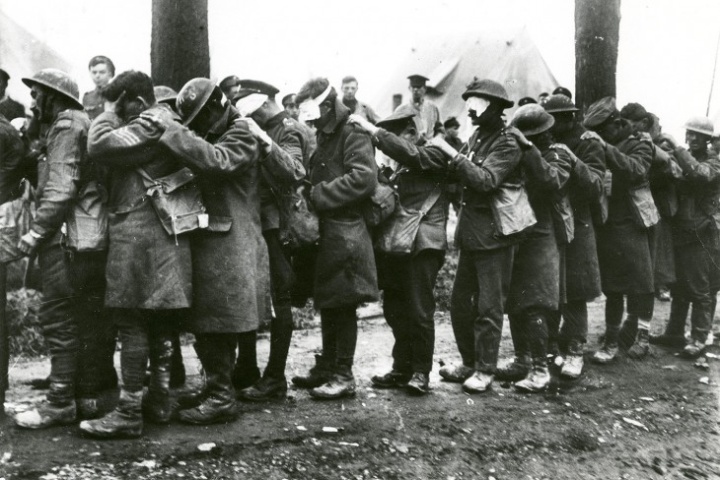
Soldiers blinded by gas at a first-aid
post near Béthune, 10th April 1918.
The War Diary [Note] extract refers to gas arriving in artillery shells,
which might account for Private Fenner’s gassing at this time.
Delivery of poison gas in artillery shells overcame many of the
risks of dealing with gas in cylinders. Gas shells were
independent of the wind and increased the effective range of gas,
making anywhere within reach of the guns vulnerable. Gas
shells could be delivered without warning, especially the clear,
nearly odourless phosgene — there are numerous accounts of gas
shells landing with a ‘plop’, rather than exploding, being initially
dismissed as dud high explosive or shrapnel shells. This gave
the gas time to work before the soldiers were realised its presence
and took precautions.
The main flaw associated with delivering gas via artillery was the
difficulty of achieving a killing concentration. Each shell
had a small gas payload and an area would have to be subjected to a
saturation bombardment to produce a cloud to match cylinder
delivery. Mustard gas, however, did not need to form a
concentrated cloud and hence artillery was the ideal vehicle for
delivery of this battlefield pollutant.
From the Bucks Herald, 19th October 1918:
“ROLL OF HONOUR.−
It is our sad duty to chronicle the death of the only son of Mr. and
Mrs. Henry Fenner, of Pendley Lodge, who died in Bramshott Hospital
on October 12 from pneumonia following an attack of influenza.
Pte. Lawrence Henry Fenner, who was 29 years of age, emigrated to
Canada some ten years ago. Early in 1916 he joined the Saskatchewan
Regiment, and after training proceeded to France, where in the great
battle of Passchendaele in November last year he was badly gassed.
He was sent to England, where for a long time he suffered from the
effects of the gas. Being attached to the Bramshot Depot (Canadian)
for orderly room duties, he there earned the highest esteem of all,
both officers and men. Seized with illness he was taken to hospital,
and passed away on Saturday, his father and mother being with him.
He was buried on Monday in the Canadian section of the Bramshott
Churchyard with full military honours, the mourners including his
father and mother, Miss Moore (aunt), and Miss Jacklin (Tring).
There were a number of beautiful floral tributes, including a wreath
from Mr. and Mrs. J. G. Williams. The expressions of sympathy with
the bereaved parents have been very numerous.”
Unattributed extract, possibly from the Tring Church Magazine:
“Laurence Henry Fenner, 5th Bn Canadian
Infantry popularly known as the fighting fifth, died from pneumonia
following influenza at the Canadian Hospital at Bramshott. He
left England to settle in Canada some eleven years ago. He
joined the Canadian forces at the end of 1915. His regiment
arrived in England in May of 1917, and crossed to France the
following month. His battalion was involved in the fighting on
the Ypres Salient at Passchendaele in November 1917.
Private Fenner was badly gassed during this action and was evacuated
to England. He never fully recovered his health and could have
been returned to Canada for discharge. He, however, asked to
remain in England and was employed in the orderly room at the
Canadian depot at Bramshott. He was buried with full military
honours in Bramshott Churchyard, in a section reserved for Canadian
soldiers.”
Judging by the date of Private Fenner’s death and its primary cause,
it is likely that he fell victim to the 1918 Spanish Influenza
pandemic (January 1918–December 1920), his body already being
debilitated by the effects of gassing. [Note]
It is estimated that Spanish flu resulted in between 50 and 100 million deaths,
making it one of the deadliest natural disasters in human history.
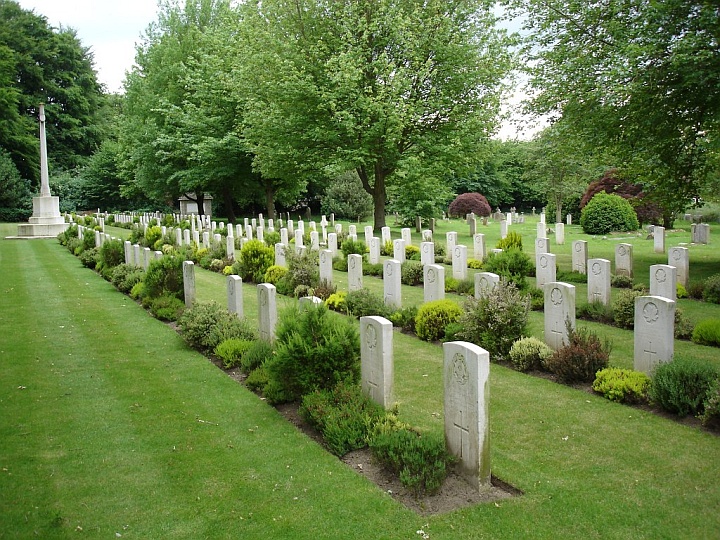
From the autumn of 1915 to October 1919, a Canadian Training Centre
was placed in the open country on both sides of the Portsmouth road,
between the turnings to Grayshott and to Bramshott. The
soldiers who died in No. 12 Canadian General Hospital, which served
the camp, were buried in Bramshott Churchyard or, in the case of the
Roman Catholic soldiers, in the Churchyard of St. Joseph’s Church,
at the West end of Grayshott.
――――♦――――
HERBERT EDWARD FOSKETT
Second Lieutenant, 5th Bedfordshire Regiment, attached to 6th Bn.
Son of Mary and the late Herbert Foskett of Western Road, Tring.
Enlisted September 1914. Killed in action on the 28th April
1917, aged 24.
No known grave. Commemorated on the Arras Memorial, France, Bay 5.
Lieut. Foskett enlisted in September 1914, becoming Private 2810 in
the Hertfordshire Regiment. Following training, in April 1915
he joined the 1st/1st Hertfordshires on the Western Front [Note] and by the
time the Territorial soldiers [Note] were renumbered early in 1917, he was
serving as Acting Sergeant 265678. After being commissioned
Second Lieut. on 24th January 1917, he trained with the 5th
Battalion. However, he arrived in France with the 6th Bedfords
on 16th April 1917 together with three other officers, all of whom
were killed or wounded within twelve days.
The 6th Bn. Bedfordshire Regiment served entirely on the Western
Front until disbanded in May 1918. During its service in
France and Flanders, it formed one of the four battalions of the
112th Brigade, part of the 37th Division. During the war, the
37th Division suffered some 30,000 casualties, of which the 6th
Bedfords lost over 650 killed in action, with over 2,700 more of
their number being wounded.
During April 1917, the 6th Bedfords were engaged in the Battles
of Arras, specifically at the First and Second Battles of the
Scarpe, and the Battle of Arleux. Later that year they
were engaged in the Battles of Ypres (also referred to as the Third
Battle of Ypres, or Passchendaele), namely in the Battles of the
Menin Road, of Polygon Wood, of Broodseinde and of Poelcapelle.
In the 38 days of fighting around Arras, some 300,000 servicemen on
both sides were wounded, missing or killed. The British Army
suffered an average of 4,000 wounded and killed every day, the
highest average daily casualty rate of any British offensive on the
Western Front.
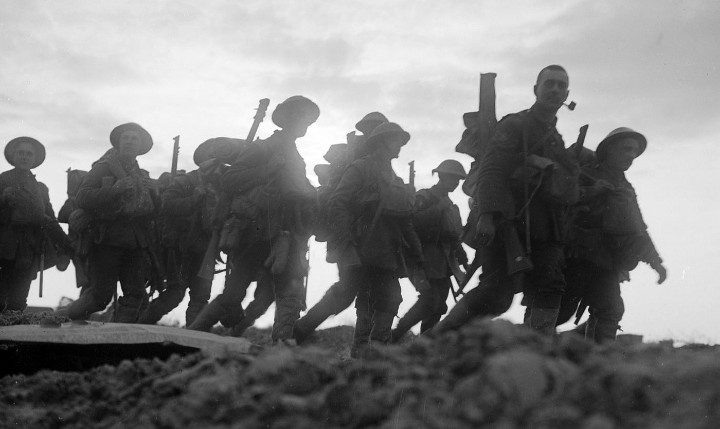
British troops moving to the front near
Arras, 29th April 1917.
The principal objective of what has been named the Battle of
Arleux was the need to sustain a supporting action tying down
German reserves to assist the French offensive against the plateau
north of the Aisne. At 04:25 on 28th April, British and
Canadian troops launched the main attack on a front of about 8 miles
north of Monchy-le-Preux. The battle continued for most of
28th and 29th April, with the Germans delivering determined
counter-attacks. The British positions at Gavrelle were
attacked seven times with strong forces and on each occasion the
German thrust was repulsed with great loss by the 63rd Division.
The village of Arleux-en-Gohelle was captured by the 1st Canadian
Division after hand-to-hand fighting and the 2nd Division made
further progress in the neighbourhood of Oppy, Greenland Hill (37th
Division) and between Monchy-le-Preux and the Scarpe (12th
Division).
On the 28th April, during the Battle of Arleux, the 6th
Bedfords attacked Greenland Hill for the second time in a few days.
Only 58 men survived the carnage of this attack, Lieut. Foskett
being among the long list of killed, wounded or missing. The
following is extracted from the 6th Battalion Bedfordshire Regiment
War Diary for April 1917:
2 Apr: Estree-Wamin. In billets. In
training. Bde. Efficiency competition won by the Battn.
5 Apr: Hauteville. Marched to HAUTEVILLE.
7 Apr: Wanquetin. Marched to WANQUETIN.
8 Apr: Warlus. Marched to WARLUS.
9 Apr: Feuchy. Marched to ARRAS & drew Lighting
Equipment. Advanced to road running N–S thro’ FEUCHY CHAPELLE
& dug in.
[The Battle of Arras - The First Battle of the Scarpe]
10 Apr: La Bergere. Captured LA FOLIE FERME & LA
BERGERE in conjunction with attack of 111th Bde. on MONCHY-LE-PREUX.
Lt. Shaw killed. Battn entrenched on line LA BERGERE
cross-roads–GUEMAPPE. Lts. Iredale, Hedges, Pattison,
Davidson, Foreman wounded.
11 Apr: La Bergere. Remained in the above line.
Lt. Thompson killed. Relieved at night by 12th Divn.
12 Apr: Wanquetin. Marched to wet trenches in
TILLOY. Several men suffered from exposure. After
daylight marched to ARRAS, thence by busses to WANQUETIN.
14 Apr: Givenchy-le-Noble. Marched to
GIVENCHY-LE-NOBLE to billets.
16 Apr: Lts. Rose, Love, Foskett & Nokes arrived.
17 Apr: Lewis Gun [Note]
carts [Note]
finally given up.
19 Apr: Lattre-Saint-Quentin. Marched to LATTRE-ST-QUENTIN.
21 Apr: St-Nicholas. Marched to St NICHOLAS &
bivouaced.
23 Apr: Roeux-Gavrelle Road. Assembled in EFFIE
TRENCH for attack on GREENLAND HILL position. At 4.25 am Battn
was ordered to support the 63rd Bde. & finally dug in E of road
between ROEUX & GAVRELLE.
[The Battle of Arras - the Second Battle of the Scarpe]
24 Apr: Capts. Blake & Williams, Lts. Wilkins,
Stables, Parsons, Nokes wounded. Lt. Colchester killed.
25 Apr: Battn remained in trench it had dug.
26 Apr: Battn remained in trench it had dug.
27 Apr: Battn remained in trench it had dug.
[The Battle of Arras - The Battle of Arleux]
28 Apr: Berlencourt. Battn assembled for attack
(at dawn) on GREENLAND HILL. Objective almost gained.
Parties dug in where they could. Suffered from enfilade fire
[Note]
from CHEMICAL WORKS where 34th Div were held up. Lt. Love & a
party missing after relief by 26th Bde. Marched to ARRAS after
relief & proceeded by busses to BERLENCOURT.
Only 58 men
actually came out of the attack. Lts. Rose & Foskett killed.
Lts. Nathan & Smith wounded. Capt. Williams again wounded.
From
the Bucks Herald, 12th May 1917:
“Death of Lieut. Foskett.− News was
received on Sunday morning that yet another brave resident of the
town had fallen in action at the Front, and the deepest sympathy is
felt for Mr and Mrs Herbert Foskett in their terrible loss.
One of the first to answer his country’s call, Lieut. H E Foskett
joined the Herts. Regiment in September 1914, and it was not long
before he went with it to the Front. He was wounded in the
battle of Festbert, and was brought to England where he made a fair
recovery, and was sent to Halton Camp. Here his abilities soon
gained him promotion, and for some time he carried out duties on the
Headquarters’ Staff at East Camp, in which capacity he won the
esteem and respect of all, officers and men alike. Quite a
gloom pervaded the camp on Sunday when the sad news became known.
Staff-Sergt. Foskett was recommended for a commission early in the
year, and this he accepted and on April 7th preceded to France to
join the Bedfordshire Regiment. On Sunday morning his parents
received a notification that their son was killed in action on April
28th.
Lieut. Foskett was the only son of Mr and
Mrs Herbert Foskett, of High Street: he was 24 years of age, and,
before joining up, he occupied an important position in the District
Superintendent’s staff at Euston. Expressions of sympathy have
reached the parents from all quarters, his former Commanding Officer
being one of the first to send a note of condolence.”
From the Parish Magazine:
“Second Lieutenant Herbert Edward Foskett
joined the Hertfordshire Regt in September 1914, and soon afterwards
went to the front. He was wounded at the Battle of Festubert
and was returned to England after he recovered from his wounds.
He was posted to Halton Camp, where he soon gained promotion and was
for a considerable time on the headquarters staff at East Camp.
Early in the year Staff Sergeant Foskett was recommended for a
commission and at the beginning of April left England for France
with a large draft of other officers. He had barely been at
the front three weeks when news was received that he had been
killed. His Commanding Colonel at Halton Camp wrote to his
mother:
‘He was a son of whom you might well be
proud he was in every respect a most promising and reliable
officer.’ Another officer wrote: ‘He was such a good and able
officer in every way and I am sure he would have done extremely well
had he been spared.’ Lieutenant Foskett’s Lance
Corporal supplied the following particulars of his death:
‘On the night before the advance Mr Foskett
came round
‘Cheer up lads’ he said, ‘we go over in the morning.’
Just before dawn we moved in to our jumping off trench. Mr
Foskett came along and said:
‘Now lads you cannot lose your direction, as soon as the barrage
starts follow me and advance full in the face of the rising sun.’
We did and I think we lost hardly a man, and then we started to dig
in. I had hardly got down above a foot when something hit me
in the back. I went down like a log. Mr Foskett said:
‘All right lad, wait a minute, I will get a stretcher bearer.’
They came and dressed my wounds and put me in a shell hole.
After that everything went black. When I came to it was dark so I
decided to get back. I started crawling and I remembered his
words ‘Advance into the sun,’ so I thought if I crawled back towards
the moon, I should strike our people. I crawled for it seemed
hours and heard voices but they were Germans. I thought oh,
here is a nice predicament to be in No. 10572, you had best nip
back, so I went back. I dropped into a half dug trench and
someone lay there. I saw that he was dead, but could not
recognise who he was. As he lay between Fritz’s line and ours
I thought it best to search him. I took his papers and then
when I saw his field glasses I thought he must be an officer.
As well as I could I slung him over and covered him as best I could
and put a rifle to mark the grave. I then crawled away into
another trench. When it got lighter I looked at the pocket
diary and discovered it belonged to Mr Foskett. I could not do
more, because I was between the two lines and being sniped at by
fritz and our own men. With the help of Mr Foskett’s glasses I
found out which way our lines were and decided to crawl back there
when it got dark. When it was dark I tied a piece of paper to
the rifle marking the grave on which I had written the words 2nd /
LT H. Foskett. 6th Bedfords 4 company. If this was found he
would in all probability get a cross put up there, but more than
that I cannot say.
Although I only knew him for such a short time, he was an
exceptionally good officer, who was respected and liked by all in
his company. Please accept my deepest sympathy.’”

The Arras Memorial commemorates almost 35,000 servicemen from the
United Kingdom, South Africa and New Zealand who died in the Arras
sector between the spring of 1916 and 7th August 1918 (the eve of
the Advance to Victory) and have no known grave. The most
conspicuous events of this period were the Arras offensive of
April-May 1917, and the German attack in the spring of 1918.
――――♦――――
STANLEY FRANCIS FOSTER
Private, 6th Bn. Bedfordshire Regiment, service no. 33276.
Born in Tring. Husband of Alice Maud of 45 King Street.
Enlisted at Bedford. Killed in action by a shell on 6th August
1917 aged 30.
Buried in Derry House Cemetery, Belgium, grave ref. I. D. 2.
The 6th Bn. Bedfordshire Regiment was formed at Bedford in August 1914
as part of Lord Kitchener’s first volunteer Army (a.k.a. the
New Army) of 100,000 men, a force raised
specifically for the duration of the war. The 6th Bn. was at
first attached to the 9th (Scottish) Division at Aldershot whilst
training, but when the 37th Division was formed in March 1915 (2nd
Army) the
6th Bedfords joined them as part of the 112th Brigade. [Note]

37th Division Memorial, Monchy-le-Preux,
Pas-de-Calais.
The Great War cost 37th Division 29,969
men killed, wounded or missing.
The battalion landed at Havre in July 1915. They appear
to have first engaged in action during 1916 in the Battles of The Somme
[Note] followed, in 1917, by the battles of Arras and Third Ypres (a.k.a. Passchendaele).
The Third Battle of Ypres (31st July-10th November) began with
encouraging gains but soon became bogged down by prolonged wet
weather. By August the offensive was clearly failing in its
objectives and had descended into attritional fighting at enormous
cost in casualties to both sides. The British eventually
reached Passchendaele Ridge, while the objective of diverting German
forces from the French further south (while they recovered from the
Nivelle Offensive in April) also succeeded, but the objective of
breaking through to capture the German U-boat pens at Zeebrugge and
Ostend on the Belgian coast did not.
It is difficult to pin down the action in which Private Foster was
killed. Although the 6th Bn. was engaged in the Third Battle
of Ypres, the major actions in August in which they took
part came after Private Foster’s death. The 6th Bn. War
Diary [Note] for the period of his death gives no clue:
2nd August 1917 − Battalion moved to camp
on Kemmel Hill relieving 8th Lincoln Regt.
3th-4th August 1917 − Battalion in camp at Kemmel. Weather
still very bad indeed. Large working parties in the front
line.
5th August 1917 − Major F. G. Mackenzie to hospital sick. Capt. A.
T. Hitch took over the duties of 2nd in command. 2/Lt C.E.Kirk
[Charles Edmund Kirk] & 4 other ranks killed, & 4 other ranks
wounded on a working party.
6th August 1917 − Battalion moved to support area at
Rossignol Wood.
. . . . so one must conclude that he was killed in the intermittent
shelling to which British front line trenches were subjected.
From the Bucks Herald, 1st September 1917:
“Frank Foster, of the Bedfordshire
Regiment, son of Mr. William Foster of New Mill, is reported killed.
He was a married man, and previous to joining was in the employ of
Messrs. John Gower and Son, contractors.”
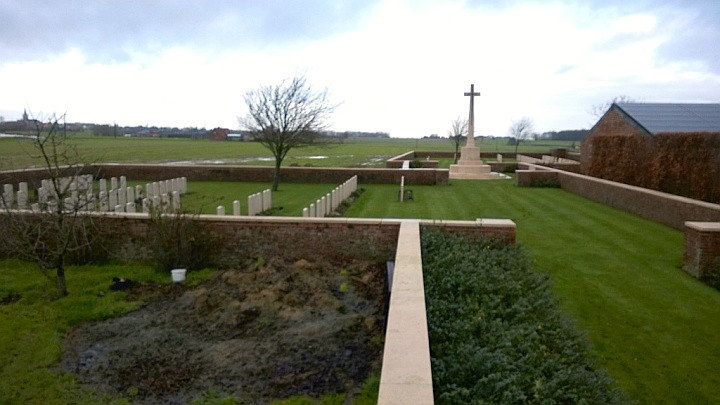
Wytschaete (now Wijtschate) was taken by the Germans early in
November 1914. It was recovered by commonwealth forces during the
Battle of Messines on 7th June 1917 but fell into German hands once
more on 16th April 1918. The village was recovered for the last time
on 28th September 1918. Derry House Cemetery was named after a farm which had been nicknamed “Derry House” by
soldiers of the Royal Irish Rifles. It was begun among the ruins of
the farm in June 1917 by a field ambulance unit of the 11th division
(32nd brigade) it was used as a front line cemetery until December
1917 and again in October 1918 by the 2nd Bn. London Scottish. The
cemetery contains 163 First World War burials and the remains of a
concrete command post built by engineers of the 37th Division in
July 1917.
――――♦――――
SIDNEY THOMAS FOUNTAIN
Private, 1st Cambridgeshire Regiment, formerly with the Northants
Regiment. Service no. 201746.
Born in Eaton Bray, Beds. Son of Mrs. Frederick Fountain of 14
Charles Street, Tring.
Husband of Mrs. Sarah Eliza Fountain of 44 Charles Street, Tring.
Enlisted at Bedford. Killed in action on 28th August 1918 aged
29.
Buried in Peronne Road Cemetery, France, grave ref. IV. F. 26.
Sidney married Sarah Eliza Poulton at Tring Parish Church on the
27th May 1911. He was then living at 2 West Passage, his
wife at 2 Stratton Place, and both were 22 years of age.
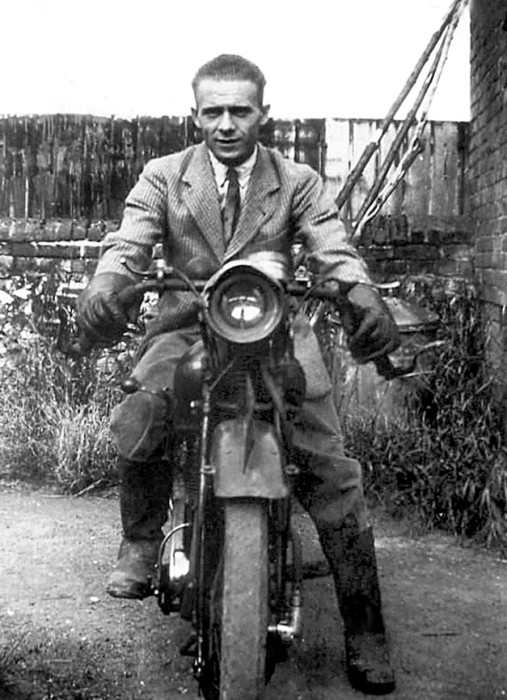
Sidney Fountain in happy times.
Private Fountain enlisted in the Northampton Regiment in August,
1916. He went to France in June of the following year, where
he was transferred to the 1st Cambridgeshire Regiment. He was
killed in action on the 28th August 1918. On the basis of his
date of death and the location of the 1st Cambs. at the time, it is
likely that he was killed in the fighting around Bapaume. [Note]
The 1st Bn. Cambridgeshire Regiment was raised in August
1914. They proceeded to France on the 15th of February 1915,
landing at Le Havre where they joined 82nd Brigade, 27th Division,
with whom they saw action at St Eloi and The Second Battle of Ypres.
On the 29th of February 1916, they joined the 118th
Brigade, 39th Division. They saw action in the Battle of the
Somme in 1916, [Note] the Third Battles of Ypres in 1917, and on the Somme and
at the Battles of the Lys in 1918 (where 39th Division suffered
heavily). On the 9th of May 1918 the 1st Cambs
transferred to 35th Brigade, 12th Division, and absorbed more than
400 men from 7th Suffolk Regiment to bring them back to full
strength. In the battles of the Hundred Days Offensive,
[Note] they saw heavy fighting at
Bapume,
Amiens and Nurlu.
By early 1918 the Germans had realised that their remaining chance
of victory was to defeat the Allies before the overwhelming
resources of the United States could be fully deployed. With
the additional troops freed (nearly 50 divisions) following the
Russian surrender in the East they mounted a series of attacks along
the Western Front [Note] that became known as the “Spring Offensive”
(a.k.a. the “Ludendorff Offensive”). The Offensive
began on the 21st March and quickly achieved deep advances into
Allied held territory. However, due to its rapidity, the
Germans were unable to move supplies and reinforcements to the front
quickly enough to sustain the fast-moving stormtroopers leading the
Offensive, and it ran out of steam. By late April the danger
of a complete German breakthrough had passed.
In July the Allies struck back, landing a series of blows at the
Second Battle of the Marne (18th July-9th August) and the Battle of
Amiens (8th-11th August). On the 21st August, the British
Third Army broke through the German line north of Amiens and drove
toward Bapaume, where heavy fighting took place between the
21st August and the 3rd September. [Note] This British and Dominion
attack formed part of the Allies’ Hundred Days Offensive.
On the 22nd August the Cambridgeshire Regiment were ordered to
attack the area around Bapaume. The attack began badly
owing to lack of promised tank support, while enemy machine gun
positions and accurate artillery fire caused many casualties among
the assaulting companies (losses for the day were 37 men killed and
around 100 wounded). The fighting around Bapaume
continued, the offensive slowly grinding down the German positions.
In torrential rain the assault continued on the German lines and the
Cambs held their positions from fierce counter-attacks. By
early September, the British First, Third and Fourth armies had
pushed the German forces on the Somme back to the Hindenburg Line –
the point from where they had launched their Spring Offensive.
Sidney’s descendants have retained the letter sent by his Company
Commander to Sarah telling of her husband’s death (alas, part is
illegible):
31st August 1918
”Dear Mrs. Fountain.
I regret that I have to inform you of the death in action of your
husband on the evening of the 27th inst. The Company went
forward again that day and occupied a position and we were getting
dug in when we were shelled fairly heavily. Your husband’s
platoon were just behind mine when several shells fell almost on top
of us in front and behind our trenches. Your husband was on
duty with his section and his sergeant and three of his pals ###### by the same shell
that killed your husband. He suffered no pain at all and was
buried on the spot – which we may be able to tell you of when the
heat of battle passes further away.
Believe me when I say that we all regret his loss. I cannot
say that I knew him personally, for all the Company officers have
been casualties and I have only recently joined here. As a
married man I can deeply sympathise with you. All the future
will seem dark now that your husband is gone from you. I trust
you will be given the strength to bear up in this great loss and
feel some comfort in that he met his death fighting bravely for the
cause of Right.
His Battalion has done great things and each man of it has great
reason to be proud of it. We are out resting and making
efforts at reorganisation: it is now that we miss our old tried and
trusted
soldiers.
Let me assure you of the heartfelt sympathy of all his comrades with
you in your bereavement: we do miss our pals when they’re taken -
and so swiftly removed from our midst.”
|
Believe me, Yours sincerely
F. E. Bauyard, (????) Lieut.
B Coy 1st Cambridge |
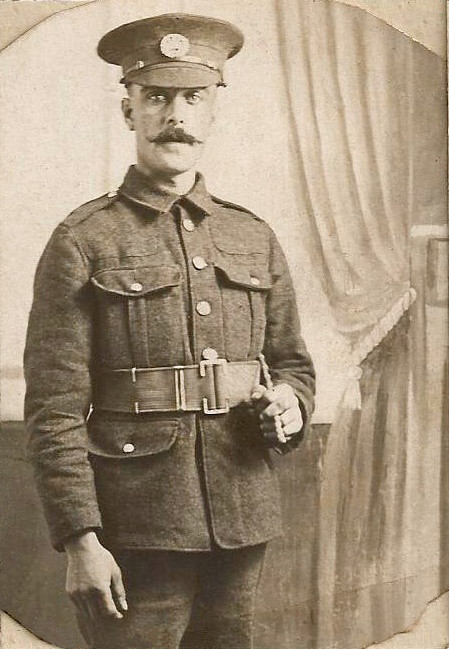
Private Sidney Fountain.
From the Bucks Herald, 7th September 1918:
“PRIVATE SIDNEY
FOUNTAIN: on Tuesday evening Mrs.
Fountain of Charles-street, Tring, received a communication from the
officer commanding, that her husband, Pte. Sidney Fountain, Cambs.
Regiment, had been killed in action in France on August 27 last.
Much sympathy is felt for the bereaved wife, who is left with two
little children. Before joining the Army some two years ago Fountain
was employed as carman by the Tring Co-operative Society, and had
been in France nearly the whole of that period. He was 30 years of
age, and was held in high esteem by his employers.”
The following letter was written on Y.M.C.A. stationery, year not
stated:
“Jan. 7th.
Dear Dad & Mother. Just a few lines hoping to find you quite well as
I am myself. I received the parcel alright & was very pleased
with it. Pleased to find you enjoyed yourself at Xmas. I
spent my Xmas night and boxing day in the trenches, but we are right
back now [presumably out of the lines].
We had out New Years super last night. Plenty to eat and drink
& with your parcel I had quite a good time. Pleased to hear
Jack is coming home. Hope he is quite well. I should
like to be at home to see him but I hope we shall some day. We
live in hopes. I hope to have my next Xmas feed at home.
I don’t think much to France, just about like being round Swan
Bottom so you can guess it is lively. Tell Dad to remember me
at the Castle. They dish the beer out in pails out here.
I have got 2 more parcels to come Sarah tells me so I shall be
alright. They are a long time coming sometimes. I
received yours on the 6th. I think this is about all this
time. Wishing you a happy new year. Hoping to see you
all again some day. From Sid.”
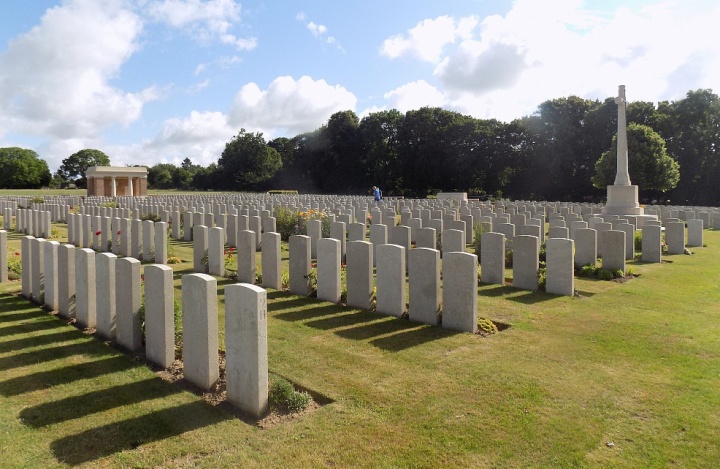
Private Fountain is buried in Peronne Road Cemetery, Maricourt.
Maricourt was, at the beginning of the Battles of the Somme 1916,
[Note]
the point of junction of the British and French forces, and within a
very short distance of the front line; it was lost in the German
advance of March 1918, and recaptured at the end of the following
August.
The Cemetery − originally known as Maricourt Military Cemetery No.3
− was begun by fighting units and Field Ambulances in the Battles of
the Somme 1916 and used until August 1917; a few graves were added
later in the War, and at the Armistice it consisted of 175 graves
which now form almost the whole of Plot I. It was completed after
the Armistice by the concentration of graves from the battlefields
in the immediate neighbourhood and from certain smaller burial
grounds.
――――♦――――
ARTHUR FREDERICK FRENCH
Private, 6th East Yorkshire Regiment, service no. 9521.
Born in Tring.
Enlisted at Berkhamsted. Killed in action on the 17th July
(???) 1917.
Buried in No Man’s Cot Cemetery, Belgium, grave ref. B 24.
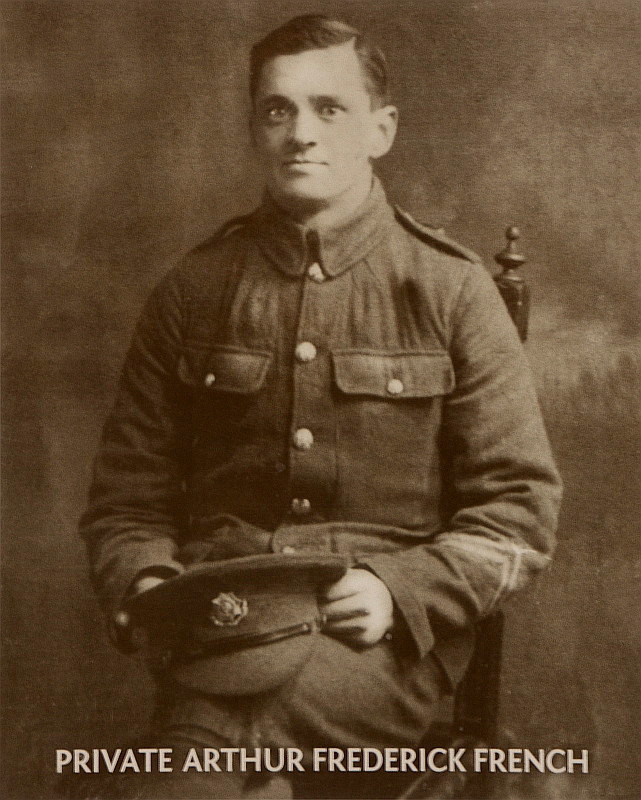
Other than this brief obituary from the Parish Magazine,
nothing is known about:
“Arthur Frederick French, Private East Yorks
Regt, was killed by a shell ‘somewhere in France’ on September 17th,
1917. He was buried behind the lines. He joined the Army
as far back as 1910 and was in India for four years. At the
outbreak of war he was sent to Egypt and fought in Gallipoli.
He finally went to France in May 1915.”
Private Arthur French appears to have had an eventful military
career. Other than his pre-war service referred to, the 6th
Bn. East Yorkshire Regiment saw service at Gallipoli (Suvla Bay) and
in Egypt before being transferred to Egypt (Suez canal defences)
before landing in France (Marseilles) in July 1916. The
Battalion then took part in many of the major battles in France and
Flanders, finally being near Havay in Belgium at the Armistice. |
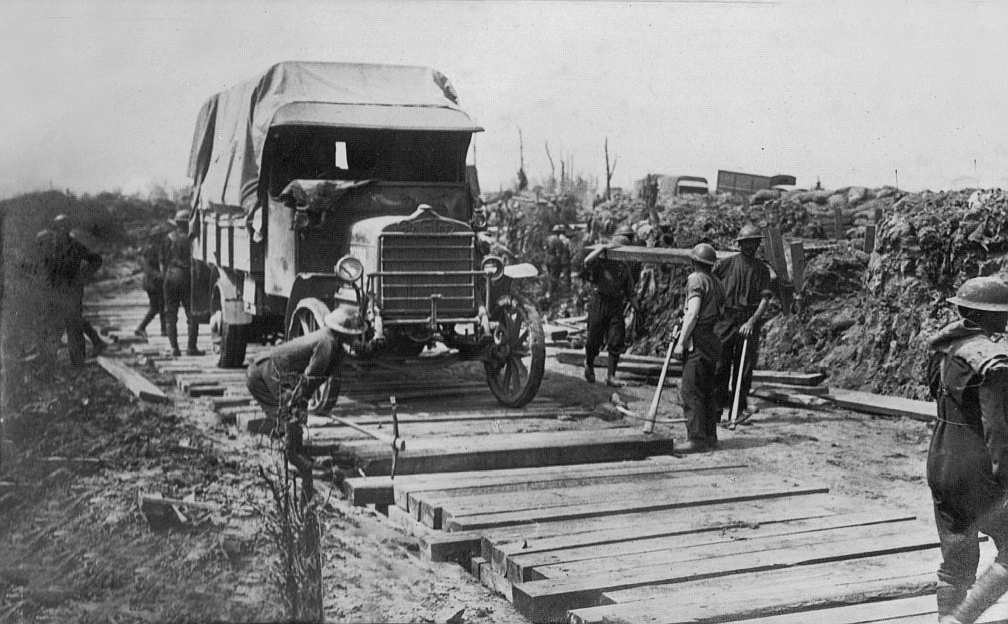
A pioneer battalion laying a temporary road.
|
In December 1914 the 6th East Yorks became the “Pioneer” Battalion
to the 11th Division. Such battalions were intended to meet
the vast demand for labour within fighting units, each infantry
Division being assigned a pioneer battalion that would be trained
and capable of fighting as infantry, but would normally be engaged
in labouring work. Pioneers differed from normal infantry in
that they were composed of men who were experienced with picks and
shovels (i.e. miners, road men, etc) and some who had skilled
trades (smiths, carpenters, joiners, bricklayers, masons, tinsmiths,
engine drivers and fitters), and each would carry a range of
technical stores not carried by the infantry.
There is some conflict on the date of Private French’s death.
The cemetery records of the Commonwealth War Graves Commission −
besides entering his initial as ‘P’ rather than ‘A. F.’ − give a
date of death of the 7th July 1917. Their burial record form
(below) states date of death as the 8th August, whilst the Tring
Parish Magazine reports the 17th September, presumably using a
notification sent by the Battalion.
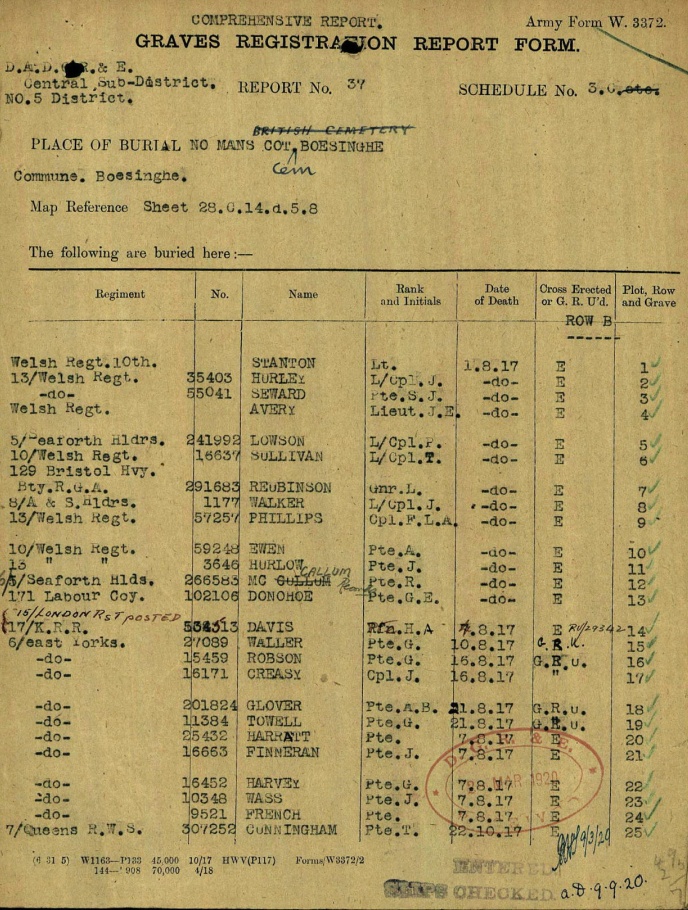
However, the battalion was not involved in any significant battles
on each of those three dates. As regards to his initials, I
have taken the Christian names published in the Buck Herald
on the 5th of April 1919, when the names to be entered on the War
Memorial were listed together with the notice “that the
Vicar would be glad, therefore, to be informed as soon as possible
of any mistakes or omissions that have been noticed.”
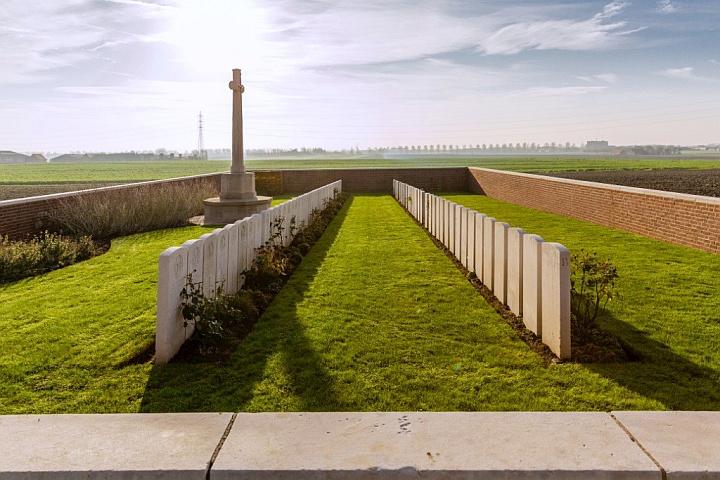
The No Man’s Cot cemetery is located at the village of Boesinghe
to the North-East of Ypres, Belgium. For most of the First
World War, the east side of Boesinghe (now Boezinge) faced the
German front line. The cemetery was used from the end of
July 1917 to March 1918.
――――♦――――
FRANK JOHN GATES
Rifleman, 8th Post Office Rifles, London Regiment, service no.
371624.
Second eldest of the four sons of Frederick and Emma Gates of 27
High Street, Tring.
Enlisted in London. Died of wounds at Delville Wood on the
26th July 1918, aged 27.
Buried in Delville Wood Cemetery, France, grave ref. XXVII. R. 5.
Frank Gates is listed in the 1911 Census, aged 20, and living with his parents
Frederick (aged 53, hay and straw binder) and Emma (aged 53) at 12
Akeman Street. He was employed as a draper’s assistant. At the same address where his brothers Walter
(aged 22, journeyman baker), Arthur (aged 17, hairdresser’s
assistant) and Herbert James (aged 15, grocer’s apprentice).
Walter and Herbert also enlisted in the army and lost their lives during the war.

Recruitment to the 8th Battalion City of London Regiment, as they
were officially known, was almost exclusively from men of the
British Post Office. After months of training at home, the
battalion left for France in March 1915, the 1/8th forming part of
the 47th Division; its second line counterpart, the 2/8th, which
formed part of the 58th Division, arrived in France in January 1917.
In February 1918, the reduction in the number of battalions in a
brigade from 12 to 9 resulted in both battalions amalgamating to
form the 8th Battalion of the 174th Brigade in the 58th Division.
[Note]

Delville Wood, where Rifleman gates was wounded, was a tract of woodland
some 1 kilometre square,
the western edge of which touched the village of Longueval in the
Somme. On the 14th July 1916 the greater part of Longueval
village was taken by the 9th (Scottish) Division. Then, on the 15th,
the South African Brigade of that Division captured most of Delville
Wood − at great cost. By the 25th August the Wood had
finally been cleared of German resistance and it was then held until
the 24th March 1918 when, following the launch of the German Spring
Offensive, [Note] the 47th Division received orders to retire with the rest
of V Corps after German troops broke through the junction of V Corps
and VII Corps. The Wood was recaptured by the Allies at the
end of August 1918.
From the Parish Magazine, 1919:
“Frank John Gates, who has been missing for
some time, is now reported to have died whilst a prisoner of war at
Limburg in Germany on the 26th July 1918. His death it is said
was due to the result of wounds received in action.
It was in June of 1915 that he joined the Army and was attached to
the Post Office London Rifles. For sometime he was a gymnasium
instructor in England, but went to France in January of last year.
He was formerly a member of our Church Lads’ Brigade and favourite
with those that knew him. May god accept the sacrifice which
he has made. R.I.P.”
Judging from the Parish Magazine notice and the date of the
Germans’ recapture of Delville Wood (March 1918) during their Spring
Offensive, it appears likely that Rifleman Gates received the wounds
from which he eventually died during that action.
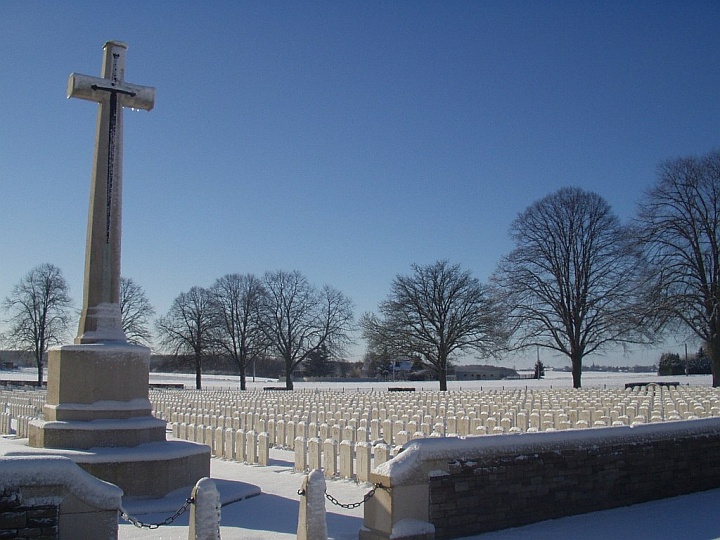
DELVILLE WOOD CEMETERY was made after the Armistice, when graves
were brought in from a few small cemeteries and isolated sites, and
from the battlefields. Almost all of the burials date from July,
August and September 1916. There are now 5,523 burials and
commemorations of the First World War in this cemetery; 3,593 of the
burials are unidentified, but there are special memorials to 27
casualties known or believed to be buried among them. Other special
memorials record the names of three soldiers buried in Courcelette
Communal Cemetery German Extension, whose graves were destroyed by
shell fire.
――――♦――――
HERBERT JAMES GATES
Lance Corporal, 2nd Oxfordshire and Bucks Light Infantry, service
number 266022.
Youngest of the four sons of Frederick and Emma Gates of 27
High Street, Tring.
Enlisted at Aylesbury. Killed in action in France on the 2nd
November 1918 aged 22.
Buried in Maresches Communal Cemetery, France, grave ref. South-East end.
Herbert Gates is listed in the 1911 Census – aged 15 and employed as
a grocer’s apprentice – living with his parents
Frederick (aged 53, hay and straw binder) and Emma (aged 53) at 12
Akeman Street. Living at the same address where his brothers Walter
(aged 22, journeyman baker), Frank (aged 20, draper’s assistant) and
Arthur (aged 17, hairdresser’s assistant). Walter and Frank
also enlisted in the army, both losing their lives during the war.
The 2/4th battalion of the Oxfordshire and Bucks Light Infantry was
formed at Oxford in September 1914 as a second line unit. In
January 1915 it moved to Northampton where it attached to 184th
Brigade in 61st (2nd South Midland) Division. [Note] In May 1916 the
battalion landed at Havre, and from there on engaged in various
actions on the Western Front. [Note] During the war, 5,878 officers
and men of the various battalions of the Oxfordshire and
Buckinghamshire Light Infantry lost their lives.
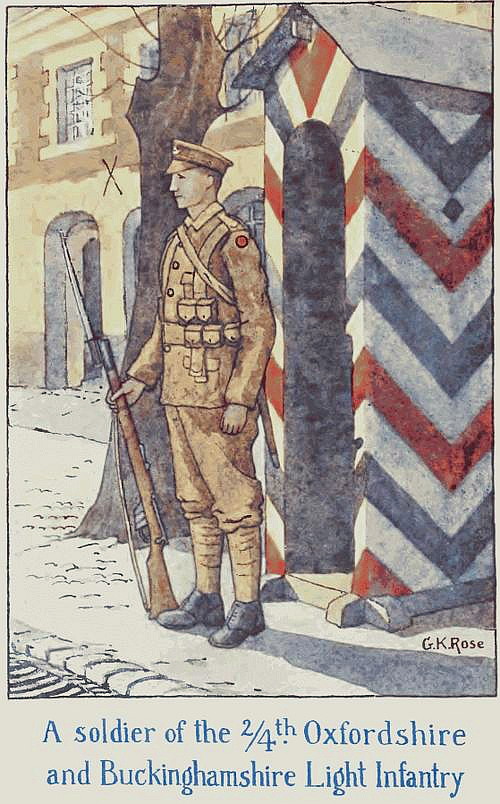
Lance Corporal Gates was killed in action during
The Hundred Days Offensive. [Note] Beginning with the Battle of Amiens on the 8th August,
the Allies launched a series of offensives which pushed the Germans
out of France, forcing them to retreat beyond the Hindenburg Line. [Note]
This was followed by the Armistice on the 11th November 1918, which
ended the war.
At the Armistice, the 2nd Oxfordshire and Bucks Light Infantry was at St. Pol, near Maresches.
Judging from the date of Lance Corporal Gates’ death (2nd November) and his burial
at Maresches, it appears likely that he was killed during the
fighting – indeed, the battalion’s last action of the war – that
Captain G. K. Rose M.C. describes in The Story of the 2/4th Oxfordshire & Buckinghamshire Light
Infantry (1920):
“The Battalion joined the XVII Corps half
way through October, 1918, and was soon put into important fighting.
The enemy, who had lost Lille, Douai, and St. Quentin early in the
month, was now in full retreat between Verdun and the sea. To
preserve his centre from being pierced and his flanks rolled up,
rear-guards eastward of Cambrai were offering the maximum
resistance. Most villages, though they passed into our hands
nearly intact and in some cases full of civilians, had to be fought
for. The German machine-gunners rarely belied their character
of fighting to the end. In an attack on October 24 from Haussy,
the Battalion, advancing rapidly in artillery formation, captured
the high ground east of Bermerain; and the next day B and D
Companies (the latter now commanded by Cupper) again attacked, and
captured the railway south-east of Sepmeries. For these
operations the weather was fine, the ground dry, and the leadership
excellent. A period followed in reserve at Vendegies and
afterwards at Bermerain [about 3 kms S.E. of Maresches,
where Gates is buried], villages which were
liberally bombarded by the German long-range guns. Moving up again
on November 2, the Battalion made its last attack of the war.
A fine success resulted. The objectives — St. Hubert and the
ridge east of it — were captured, together with 700 prisoners, 40
machine-guns, and 4 tanks, recently used by the enemy in a
counter-attack. The fruits of this victory were well deserved
by the Battalion, the more because so often in the course of the war
it had been set to fight against odds in secondary operations.
It was a good wind-up.”
This from the Bucks Herald, 16th November 1918:
“We regret to have to chronicle several
deaths of soldiers, and that grief has been brought to several homes
in the town in these days of rejoicing at the practical termination
of the Great war. − Lance Corpl. Herbert James Gates, 2/4 O. and B.
L.I., was one of four sons of Mr. and Mrs. Gates, High-street, who
have several in the war and it is regrettable that two have been
killed and one is missing. Lance Corpl. Gates was the youngest
son, and had served for two years. News was received at the
end of last week that he had been instantaneously killed by a
shell.”
The following is from the Parish Magazine:
“Herbert James Gates, L/CPL Ox and Bucks Light Infantry, was killed
in action on November 2nd. He joined up in March of 1915 and was
later sent to France. His Lieutenant, writing to his parents,
says:
‘It is with great regret that I have to inform you of the death of
your son who was killed in action by a shell on November 2nd after a
successful attack on some German positions during the early hours of
the morning. Our company had reached our objectives and had
taken several hundred prisoners, when the Germans started shelling
us, one of the shells killing your son. All the men, including
your son, behaved most gallantly during the attack. Not only
in action, but out of the line, your son proved himself to be a good
and smart soldier and did his work willingly. He was quiet and
un-assuming and was well liked by his comrades in the company.
He did his work out here as a Lewis gunner,
[Note] and I know he did his
best. Infantry soldiers work is a hard and trying one, and I
think no praise is too great for them.’
This is the second
[third?] son Mr and Mrs Gates has lost. Another has been lost since
August.“

Lance Corporal Gate is buried in the 4th
war grave from the left.
Maresches is a small village some 4½ miles south-south-east of Valenciennes. There
are 9 U.K. First World War burials in the cemetery.
――――♦――――
WALTER THOMAS GATES
Private, 7th East Kent Regiment, service no. G/2204.
Born in Aston Clinton. Son of Frederick and Emma of 27 High
Street, Tring.
Enlisted in London. Died of wounds in France on the 12th July
1916 aged 27.
Buried in St Sever Cemetery, France, grave ref. A.28.4.
On the 5th August 1914, the Minister for War, Field Marshal Lord
Kitchener, issued orders for the expansion of the army. “Your
King and Country need you: a call to arms” was published on the
11th August 1914. The poster explained the new terms of
service and called for the first 100,000 men to enlist, a figure
that was achieved within two weeks. Six new Divisions were
created from units formed of these volunteers, which were
collectively called Kitchener’s Army, or K1. [Note] Two weeks later
Kitchener asked for another 100,000 men to volunteer, from which
were formed a further six Divisions referred to as K2.

The 7th (Service) [Note] Battalion of the East Kent Regiment was formed at
Canterbury in September 1914 as part of Kitchener’s Second New Army,
K2. It then moved to Purfleet where it joined the 55th Brigade
of the 18th Division. [Note] Following training, in July 1915 the
battalion mobilised for war, landing at Boulogne. Thereafter it
engaged in many major actions on the Western Front:
1916: The Battle of Albert, The Battle of Bazentin Ridge,
The Battle of Delville Wood, The Battle of Thiepval Ridge, The
Battle of the Ancre Heights, The Battle of the Ancre.
1917: Operations on the Ancre, The German retreat to the Hindenburg
Line, The Third Battle of the Scarpe, The Battle of Pilkem Ridge,
The Battle of Langemarck, First and Secong Battles of Passchendaele.
1918: The Battle of St Quentin, The Battle of the Avre, The actions
of Villers-Brettoneux, The Battle of Amiens, The Battle of Albert,
The Second Battle of Bapaume, [Note] The Battle of Epehy, The Battle of the
St Quentin Canal, The Battle of the Selle, The Battle of the Sambre,
ending the war at Pommereuil east of Le Cateau, France.
Walter Gates is listed in the 1911 Census aged 22 and employed as
a journeyman baker. He was then living with his parents
Frederick (aged 53, hay and straw binder) and Emma (aged 53) at 12
Akeman Street. At the same address where his brothers Frank (aged 20, draper’s assistant),
Arthur (aged 17, hairdresser’s assistant) and Herbert (aged 15,
grocer’s apprentice). Frank
and Herbert also enlisted in the army, both losing their lives during the war
(in Herbert’s case a few days short of the Armistice) – see previous
two entries.
The Battle of Albert (1st–13th July 1916), comprised
the first two weeks of Anglo-French offensive operations in the
Battle of the Somme, [Note] and both the 6th and 7th battalions of the East
Kent Regiment took Part. Although the loss of some 60,000
British casualties on the first day of the Somme was not repeated,
the British did lose a further 25,000 men in the fighting from 2nd–13th July. Judging from the date of Private Gates’ death and
the location of his battalion at the time, it is likely that he was
wounded during the Battle of Albert – from the correspondence below
it is clear that he was wounded on or before the 5th July. This from the Bucks Herald 15th July 1916:
“TRING MAN
WOUNDED. – On Wednesday in last week
Mr. and Mrs. Gates (High-street) received a telegram informing them
that their son, Drummer T. Walter Gates, East Kent (Buffs) Regiment,
was wounded on July 1st. Later a kind and sympathetic letter
came from the Matron at the Base Hospital saying that Drummer gates
was severely wounded, and she could hold out little hopes of his
recovery. On Sunday morning his parents were greatly cheered
by the receipt of a letter from the Chaplain, who said he saw their
son on the 5th. He had been wounded in the arm by a shell, so
was unable to write, but was cheerful and doing as well as could be
expected. His brother went over to France at the beginning of
the week, and found Drummer Gates getting on well and quite
cheerful, though he had lost his left arm and three fingers off his
right hand, and had been badly wounded in the side and the back of
the neck. Walter Gates, who before enlistment worked for Mr. Waldock, is well-known in the town, and greatly liked for his
courteous and cheerful bearing.”
This from the Parish Magazine for August 1916:
“Drummer Walter Thomas Gates 7th East Kents,
The Buffs, who was severely wounded very near the place where
Lieut. Brown was killed.
He was well enough to be moved to the 6th General Hospital in
France, and great hopes were, at one time, entertained of his
ultimate recovery. Suddenly, however he became rapidly worse and on
July 12th passed away. The matron writes: ‘As bravely as he
lived.’ The chaplain was with him shortly before he died and
ministered to him. He was buried in the beautiful cemetery at
St Sever outside Rowen. A number of letters of condolence were
received by the parents. Among these his mates wrote: ‘Walter
was such a good fellow, a real good friend and comrade, I shall
never have a better friend.’ Another writes: ‘He was a jolly
good Christian lad and helped me a lot. He went into action on
the 1st of July and I can tell you we got it pretty hot, but during
the morning I had to go on a message to Battalion Headquarters and
previous to his, had an experience which had rather unnerved me and
I was feeling pretty bad. Whilst on this message, I came
across Wally and he was as cool and calm as anything and he cheered
me up no end. We gained our objective alright and dug
ourselves in and then settled down to hold it. At midnight
Wally came again and talked with me for about an hour. Then I
had to go on an errand and when I came back he had gone. He
must have gone straight from where I was and been hit, for I never
saw him again.’ From what his parents heard afterwards he had
volunteered to go with an important message, in place of another man
who was suffering from sore feet. It was while he was
delivering this message that he received his terrible wounds.
The chaplain wrote: ‘Truly he died in a great cause, and he did the
best a man can do.’”
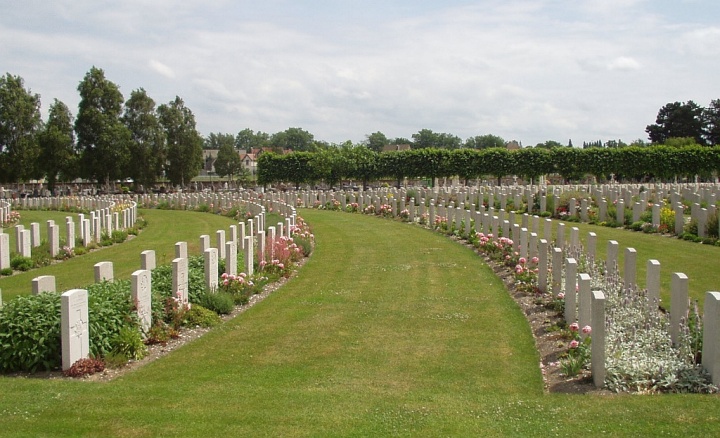
During the First World War, Commonwealth camps and hospitals were
stationed on the southern outskirts of Rouen. A base supply depot
and the 3rd Echelon of General Headquarters were also established in
the city.
Almost all of the hospitals at Rouen remained there for practically
the whole of the war. They included eight general, five stationary,
one British Red Cross, one labour hospital, and No. 2 Convalescent
Depot. A number of the dead from these hospitals were buried in
other cemeteries, but the great majority were taken to the city
cemetery of St. Sever, and in September 1916 it was found necessary to
bbuild an extension.
St. Sever Cemetery contains 3,082 Commonwealth burials of the First
World War.
――――♦――――
FREDERICK JOHN GREGORY
Private, 4th Bedfordshire Regiment, service no. 18621.
Son of John (deceased) and Martha Gregory of 48 Wingrave Road, Tring
(1911 Census).
Enlisted at Bedford. Killed in action on the 13th November
1916, aged 29.
No known grave. Commemorated on the Thiepval Memorial, France,
pier
and face 2 C.
The 1911 Census lists Frederick living at 48 Wingrave Road, Tring,
with his mother Martha, aged 62, and his brother James, a general
labourer aged 28. Frederick, then aged 27, married Elizabeth
née Barlow (aged 20, of Wigginton) at Tring Parish Church on the
28th January 1915. The wedding certificate gives Frederick’s
occupation as Private, 4th Bedfordshire Regiment, and that of his
father (deceased) as labourer. At the time of his death
Frederick and Elizabeth had a 1-year old son, their home being at
New Mill, Tring.
The 1911 Census lists Elizabeth (aged 15) living at Fox Road,
Wigginton, with her father Joseph (aged 42, Domestic Gardener),
mother Emily (aged 40), two brothers (Joseph, 12, and Ernest 6) and
two sisters (Rose, 9, and Beatrice, 4). The family appear to
have originated in West Ilsley, Berkshire, Elizabeth being born at
Littleworth.
The 4th (Special Reserve) [Note]
Battalion, Bedfordshire Regiment, was based at Bedford when war
broke out on the 4th August 1914, following which the battalion was
moved to Felixstowe to provide home defence around Harwich.
However, following the disaster on the Somme (July 1916),
[Note] together
with the equivalent units from other regiments the battalion
mobilised and sent to the Western Front. [Note] It landed in France
on the 25th July 1916, where it joined the 190th Brigade of the 63rd
(Royal Naval) Division, in which it remained throughout hostilities.
Although the 4th Battalion’s front line service during the war was
relatively short, 855 of its officers and men were killed in action
with a further 3,600 being wounded.
According to its War Diary [Note] for the 13th November 1916, the 4th
Battalion was engaged in the Battle of Ancre. This action
commenced on the 13th of November (the date of Private Gregory’s
death) and continued until the 18th.
The Battle of Ancre was the final large British attack during the
Battle of the Somme. Its objectives – the capture of Beaumont
Hamel and Serre – were intended to go some way to redeeming the
disaster of the first day of the Somme (1st July), at the same time
taking ground on which the British would gain a tactical advantage.
The attack was the largest in the British sector since September.
It commenced with a 7-day bombardment – twice as heavy as that of
the 1st July – following which British forces captured Beaumont
Hamel, St. Pierre Divion and Beaucourt. The Germans were taken
by surprise and were well beaten, with four of their divisions
having to be relieved due to the number of casualties they suffered.
Over 7,000 German troops were taken prisoner.
Between the 13th and the 15th November, the 63rd Division, in which
Private Gregory served, lost approximately 3,500 casualties.

Battle of the Ancre. An Army
Chaplain helping along a wounded German prisoner
taken on the 13th of November 1916.
This from the 4th Battalion War Diary:
“Operations on the North Bank of the ANCRE
- Nov 13th 1916. The Battalion advanced with the remainder of
the Brigade at 6.45 am and sustained heavy casualties among Officers
and NCOs in and near the enemy front line from a strongpoint
established between enemy front line and second line which had been
passed over by the leading Brigades. Battalion advanced to
enemy second line and from there parties pushed forward to Station
Road and beyond.
Casualties: Officers Killed: Captain
F. G. C. Ashmead-Bartlett, Lieut. B. L. S. Frere, Lieut. R. H. Boys,
Lieut. W. A. Turnbull, 2nd Lieut. J. Brodie, 2nd Lieut. H. B.
Hudson, 2nd Lieut. S. H. Agate, 2nd Lieut. T. H. Hill. Died of
Wounds: 2nd Lieut. L. S. Wilkinson. Wounded: 2nd Lieut.
A. R. Fraser, 2nd Lieut. L. BROOKS, 2nd Lieut. W. R. Bridges, 2nd
Lieut. R. J. Thomas, Lieut. G. Arthur RAMC. Other Ranks
Killed: 48, Died of Wounds 9, Wounded 108,
Missing 16.
In the evening all available men were
withdrawn and taken down to HAMEL, refitted and moved into position
in Station Road, close to BEAUCOURT Road.”
This from the Parish Magazine for December 1916:
“Just as we go to press comes the news that
Frederick John Gregory, Bedfordshire Regiment, was killed on
November 14th as he left the trenches.
He joined the Army two years ago and has been at the front for the
past six months. He is another of our Church Lads Brigade boys
to lay down his life in this war. The writer of this letter
which brought news of his death says: ‘He died a hero and never at
any time feared the result.’ May God receive him.”

The
Thiepval Memorial to the Missing of
the Somme, by Sir Edwin Lutyens.
British was graves on the left, French on the right.
The Thiepval Memorial, the Memorial to the Missing of the Somme,
bears the names of more than 72,000 officers and men of the United
Kingdom and South African forces who died in the Somme sector before
20 March 1918 and have no known grave. Over 90% of those
commemorated died between July and November 1916. The
memorial also serves as an Anglo-French Battle Memorial in
recognition of the joint nature of the 1916 offensive and a small
cemetery containing equal numbers of Commonwealth and French graves
lies at the foot of the memorial.
The memorial, designed by Sir Edwin Lutyens, was built between 1928
and 1932 and unveiled by the Prince of Wales, in the presence of the
President of France, on 1 August 1932.
――――♦――――
LEONARD WILLIAM GRISTWOOD
Lance Corporal, 55th Company Machine Gun Corps, service no. 4176.
Born in Chorleywood. Son of Charles and the late Mary Gristwood.
Enlisted at Watford, formerly with the Bedfordshire Regiment.
Killed in action on the 3rd May 1917, aged 21.
No known grave. Commemorated on Arras Memorial, France, Bay 10.
Leonard Gristwood enlisted in the Bedfordshire Regiment at Watford, date
unknown, but at some stage in his military career was transferred to
the 55th Machine Gun Corps, [Note] a
Company that on the 13th of February 1916 became part of the 18th
(Eastern) Division.
During 1916 the 55th Company Machine Gun Corps was in action (on The Somme
[Note]) in The Battle
of Albert, The Battle of Bazentin Ridge, The Battle of Delville
Wood, The Battle of Thiepval Ridge, The Battle of the Ancre Heights
and The Battle of the Ancre. In the following year they were
in action in the Operations on the Ancre, The German retreat to the
Hindenburg Line [Note] and in The Third Battle of the Scarpe, before
moving to Flanders. In these latter actions the 18th
(Eastern) Division formed part of VII Corps, 3rd Army,
[Note] under Lieut. General Allenby. [Note]
The battles around Arras in April and May 1917 (the first, second
and third Battles of the Scarpe, the Battle for Vimy Ridge, and the
first and second Battles of Bullecourt) were fought in order to
support the French offensive at the Aisne River further south.
The battles were generally successful in reaching their immediate
and small-scale objectives, although Bullecourt was a costly failure
while the Third Battle of the Scarpe has been considered a day on
which many who witnessed it considered it to be the blackest of the
war.

Lewis machine gunners [Note] during the Battle
of Arras, 1917.
The Scarpe is a river in the Nord-Pas-de-Calais region of France and
is a left tributary of the Scheldt. During the First World War the
river and its valley were important battlegrounds. Roeux in
the Scarpe Valley (4½ miles east of Arras) was one of the fortified
villages that formed part of the German defences behind their front
line. The ground before Roeux posed many difficulties for the
British, two of which were the Arras-Douai railway line, which ran
north-east to south-west in cutting and on embankment, and the River
Scarpe with its surrounding marshland.
Despite earlier attacks being only partly successful, the 3rd May
attack in the Scarpe (the Third Battle) began as planned. The
18th (Eastern) Division mounted an attack on Chérisy, a small village
about six miles south-east of Arras. The attack started at
3.45am in pitch darkness, which caused a great confusion due to it
being impossible to distinguish between friend and foe, which became
mixed. The attack proved an unmitigated disaster for the
British Army, which suffered nearly 6,000 men killed for little
material gain. In the Official History, Military Operations
France and Belgium 1917, Captain Cyril Falls explained why the
attack on the VII Corps front failed:
“The confusion caused by the darkness; the
speed with which the German artillery opened fire; the manner in
which it concentrated upon the British infantry, almost neglecting
the artillery; the intensity of its fire, the heaviest that many an
experienced soldier had ever witnessed, seemingly unchecked by
British counter-battery fire and lasting almost without slackening
for fifteen hours; the readiness with which the German infantry
yielded to the first assault and the energy of its counter-attack;
and, it must be added, the bewilderment of the British infantry on
finding itself in the open and its inability to withstand any
resolute counter-attack.”
This paragraph illustrates starkly the nature of the fighting in
which Lance Corporal Gristwood probably lost his life – nightmarish,
terrifying and bloody.
This from the Parish Magazine:
“Leonard Gristwood, a Corporal in the
Machine Gun Corps was reported as missing on May 3rd, is now thought
to have been killed on this day.
His Officer has written to his friends saying ‘Corporal Gristwood
was always regarded as one of our best and smartest soldiers.
He was ever brave in the face of danger and in every way a reliable
and cheerful soldier in every kind of hardship. A lad to be
proud of. We, his comrades, deplore his loss and tender our
sincere sympathy. He will be sadly missed.’”
Mary Ann Pickthorn married Charles Gristwood on the 30th January
1888. Their son Leonard was baptised at Chorleywood in 1895,
although the 1901 Census records Leonard’s year of birth as 1896.
It also records that he was domiciled at Little Tring with his
maternal grandparents, William Pickthorn (aged 60, agricultural
labourer), grandmother Elizabeth (aged 62) and May Lilian Gristwood
(aged 12), described as a grand child and presumably Leonard’s
sister. Ten years later Leonard (but not his sister) remained
with his grand parents. The Census of that year describes him
as a “boarder” and gives his occupation as “farm labourer, feeds
cattle” (his grand father’s occupation is given as “farm labourer,
horseman”).

The Arras Memorial commemorates almost 35,000 servicemen from the
United Kingdom, South Africa and New Zealand who died in the Arras
sector between the spring of 1916 and the 7th August 1918 (the eve
of the Advance to Victory), and have no known grave. The most
conspicuous events of this period were the Arras offensive of
April-May 1917, and the German attack in the spring of 1918.
Canadian and Australian servicemen killed in these operations are
commemorated by memorials at Vimy and Villers-Bretonneux.
The Arras Memorial was designed by Sir Edwin Lutyens, with sculpture
by Sir William Reid Dick. It was unveiled by Lord Trenchard,
Marshal of the Royal Air Force, on the 31st July 1932.
――――♦――――
GEORGE GUNN
Private, 11th Royal Sussex Regiment, service no. G/18702.
Enlisted at Watford. Killed in action on the 28th February
1918, aged 19.
Son of Mr. B. and Mrs. S. A. Gunn of New Road, New Mill, Tring.
Buried in Gouzeaucourt New British Cemetery, France, grave ref. II.E.5.
The 11th (Service) Battalion (1st South Downs) was formed at Bexhill
on the 7th September 1914. In October 1915 it was placed under
the command of 116th Brigade in 39th Division, and in March of the
following year landed at Le Havre, together with the 12th and 13th
battalions.
All three battalions took part in the Battle of the Boar’s Head
[Note] in June 1916. After a
bombardment of the German trenches the 12th and 13th Battalions went
over the top (most for the first time) and, under heavy fire,
attacked the enemy trenches, bombing and bayoneting their way in.
The 11th Battalion supplied carrying parties. [Note]
They succeeded in taking the German front line trench, holding it
for some four hours, and even briefly took the second line trench
for about half an hour, beating off repeated counterattacks, and
only withdrew from the shortage of ammunition and mounting
casualties.
During 1917, the Battalion took part in the Third Battle of Ypres
(generally known as Passchendaele), during which it was engaged in
the battles of Pilckem Ridge (31st July–2nd August), Langemarck
(16th-18th August), Menin Road (20th-25th September), Polygon Wood
(26th–27th September), and 2nd Passchendaele (26th October–10th
November).
At the time of Private Gunn’s death on the 28th February 1918, the
Battalion does not appear to have been involved in any significant
action. They were at Revlon Farm at Allaines in the Somme, in
the Picardy region of Northern France. This from the 11th
Battalion War Diary [Note] for
the 28th February 1918:
“Weather changeable – Enemy aircraft fairly
active – Shelling by our and enemy artillery – Capt. P. F. Drew M.C.
proceeded on leave – Lieut. R. G. K. Limbery-Buse proceeded to U.K.
for 6 months rest. Casualties 2 O.R.s killed 2 O.R.s
wounded. 2nd Lieut. Haddon was wounded by a fragment of our A.A. shells.”
War diaries generally name officer casualties individually, while
giving totals for “other ranks”. Presumably Private Gunn was
one of the “2 O.R.s” killed on that day.
This from the Bucks Herald, 19th March 1918:
“ROLL OF HONOUR.
– News has been received of the death in action of Pte. George Gunn,
Royal Sussex Regiment, son of Mr. and Mrs. Benjamin Gunn, New Mill,
with whom the deepest sympathy is felt in their bereavement.
A
letter from the Captain of his Company informs the parents at Pte.
Gunn was killed in action on Feb. 28, in the front line, with a
carrying party. He was hit by a shell and killed
instantaneously, and was buried in a little cemetery behind the
line. Over the grave a cross will be erected. The
Company Commander tendered the sympathies of the officers and men to
the bereaved parents. Pte. Gunn was 19 years of age, and
joined the Army in February of last year on attaining 18 years of
age. He proceeded overseas about the middle of last month, and
was only some 10 days in France when he made the great sacrifice.
Before joining up he was employed at Apsley Paper Mills, where he
was held in high esteem.”
From the Parish Magazine, April 1918:
“George Gunn, was a Private in 11th Bn.
Royal Sussex Regiment. His Captain writes, ‘Killed in action,
to our great regret, on February 28th 1918. He was employed in
the front line trench as part of a carrying party. He was
killed by a shell burst and died instantaneously. He was
buried this morning in a little cemetery near here. I am
having a cross erected to mark his grave. I write on behalf of
the commanding officer, the officers and men of the battalion, to
offer you our sympathy in your great loss.’”
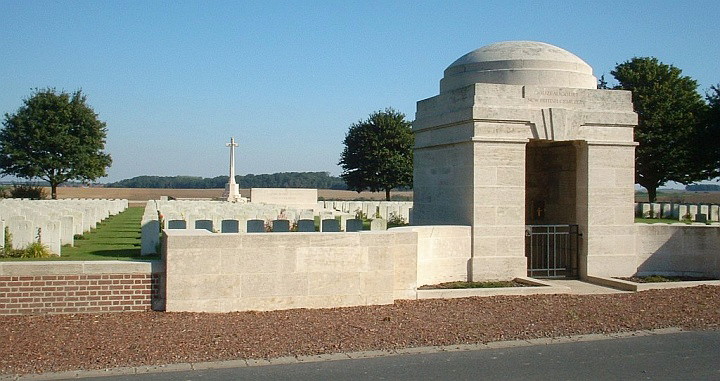
Gouzeaucourt village was captured by the 8th Division on the night
of 12-13 April 1917. It was lost on 30 November 1917 in the German
counterattack at the end of the Battle of Cambrai, and recaptured
the same day by the 1st Irish Guards. It was lost again on 22 March
1918, attacked by the 38th (Welsh) Division on the following 18
September, and finally retaken by the 21st Division on 8 October.
The cemetery now contains 1,295 burials and commemorations of the
First World War. 381 of the burials are unidentified but there are
special memorials to 34 casualties known or believed to be buried
among them. Another special memorial records the name of a soldier
buried in Gouzeaucourt Communal Cemetery in May 1917 whose grave was
destroyed by shell fire.
――――♦――――
ARCHIBALD HALSEY
Private, 1st Hertfordshire Regiment, service no. 4719.
Born in Tring. Son of James and Ellen of 38 Albert Street,
Tring.
Killed in action in France on the 21st September 1916, aged 19.
Buried in Knightsbridge Cemetery, Mesnil-Martinsart, France, grave ref. E.
45.
When war broke out in August 1914, the Regular Army was called
upon to form the British Expeditionary Force (BEF) [Note] along with a
small number of Territorial units [Note]
including the 1st Herts. It was the only one of the four
Hertfordshire Regiment battalions to serve abroad, the others
fulfilling recruit training and home-defence functions. |
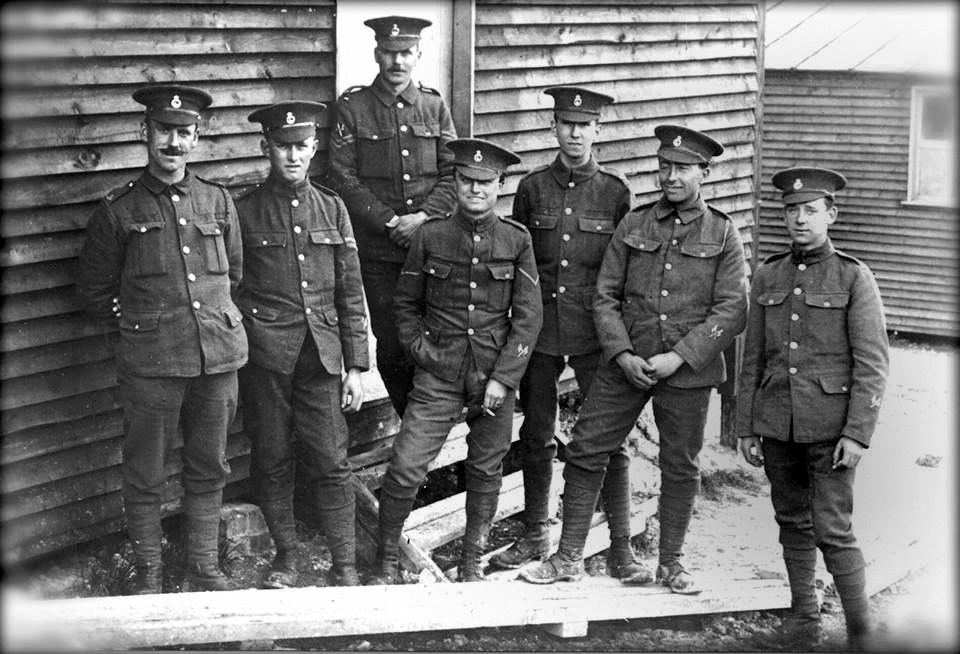
A photograph taken at Halton Park showing
signallers of 1st Bn. Hertfordshire Regiment,
part of the Battalion Headquarters, possibly taken
around January 1916.
Private Halsey is known to be in the picture,
but the narrative doesn’t identify him.
He was a corporal at the time, and there are two soldiers of that rank in the picture.
|
On the 6th November the 1st Herts landed in France, serving in
the trenches during the closing stages of the First Battle of
Ypres. In February 1916 the battalion became part of the
118th Brigade in the 39th Division, [Note] and as such was involved later in
the year in the Battle of the Somme (1st July–18th November). [Note]
Judging from the date of Private Halsey’s death and the
involvement of his battalion, it appears reasonable to assume
that he was killed during that Offensive, although the Battalion
War Diary entry for the 21st September 1916 (the day of
his death) makes no mention of any casualties or the shellfire
incident referred to in the press clipping below. |
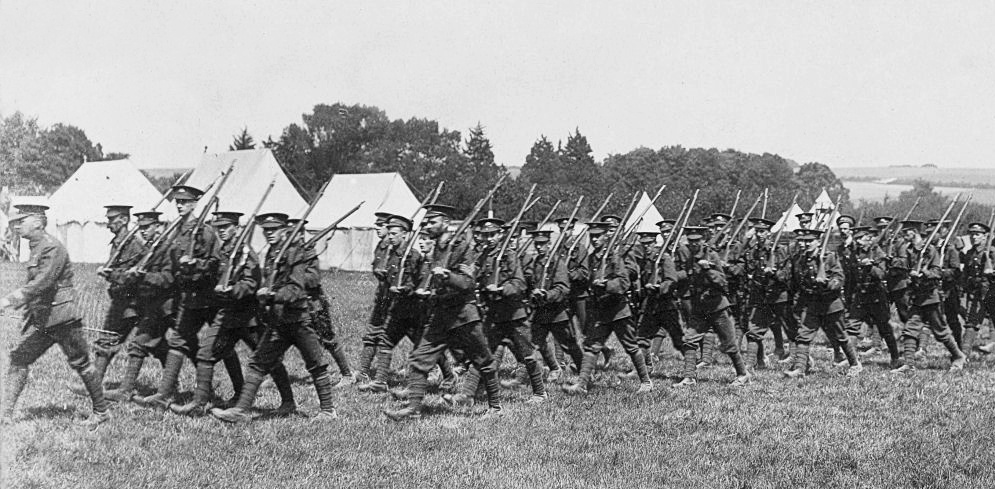
Soldiers of the 1st Herts Territorial Regiment
at a pre-war training camp.
|
From the Bucks Herald, 7th October 1916:
“PRIVATE ARCHIE
HALSEY: not yet 20, a lad of attractive
disposition and sterling character, Archie Halsey has willingly and
cheerfully laid down his life at the call of duty. A son of
Mr. and Mrs. James Halsey, Archie was a choirboy at the Parish
Church, and one of the first to join the local troop of Boy Scouts,
of which he remained an enthusiastic member until he joined His
Majesty’s Forces. A quiet, unassuming lad who, when once he
saw his duty clear, performed it cheerfully and unflinchingly.
Archie Halsey was looked up to as being absolutely trustworthy, not
only in Scout circles, but beyond. Now the promising young
life is ended, and for his bereaved parents and friends the greatest
sympathy is felt. This has found expression in numberless
letters which have been received from the members of the Company
with which Archie served, and from others.
As far as can be gathered from the letters to hand, Archie was one
of the party who were left as caretakers of a trench on September
21, and was in a dugout with several other men, when a shell
dropped in the doorway, a piece of it going through his heart.
Death was instantaneous. He was buried in a little cemetery
behind the lines where many another heroes rests.
Archie Halsey joined the Herts Territorials early in 1915, and was
for about five months in training at Halton Park. He was at
first in the Signal Section, and was promoted corporal, but on going
to France he reverted to the ranks. He seems to have been
regarded with great respect and affection by his comrades.”
From the Tring Parish Magazine November 1916:
“Archibald Halsey one of the first members
of our troop of boy scouts and has been the first to give his life
for his country. We shall miss him, the quiet, consistent
patrol leader of the ‘wolves’, who led his patrol to the first place
in the yearly competition. He also led the Ambulance Squad in
the Tempest Hicks Cup competition, two and a half hears ago.
Every scout in the troop respected him. All of his examiners
commended him, when he won his badges. The ‘gone home’ sign
has been set to his track here and he is called to higher service
beyond. The first promise of the scout is: To do his duty to
god and king. Archie was trying to keep that promise when the
shell burst in the dugout on September 20th, somewhere in France.”
In the 1901 Census, Archie, then aged 4 years, was living at 10,
Langdon Street, Tring, with his father James (aged 31, Estate
Carpenter), mother Ellen (aged 30), brother Hubert (aged 8) and
sister Ella (aged 6). By 1911 the family had moved to 38 Albert St,
Tring. Brother Hubert was by then employed as a carpenter, and
Archibald had been joined by two more brothers, Arnold (aged 6) and
Kenneth (aged 2).
It is known that Archie was active in the Boy Scout movement, two
scraps of information about which survive:
“July 8th 1911: the King and the Scouts.
Two scouts from the First Tring Troop (St Peter and St Paul) took
part in the review of scouts by the King at Windsor Park on Tuesday.
They were Patrol Leader A. Halsey and Corpl C. Woodley.
June 1st 1912: Boy Scouts. 1st Tring Group (SS Peter and Paul). An
exam for the ambulance badge was conducted by Dr J. C. Baker of
Aylesbury during the first week in May. The following scouts
were awarded badges: Patrol leaders: A. Halsey: W. Batchelor: G.
Ayres.”
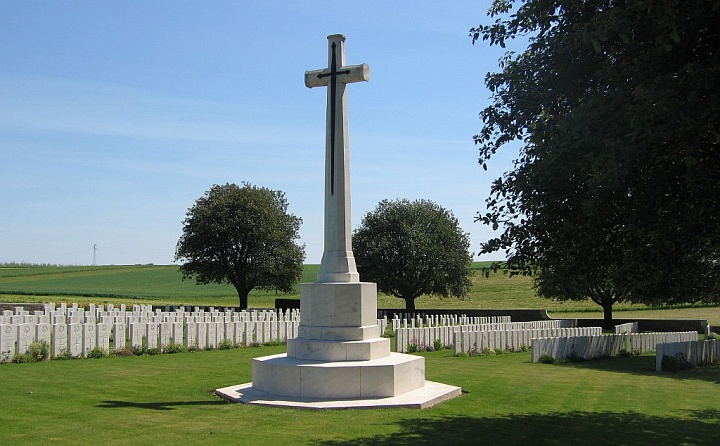
Knightsbridge Cemetery, which is named after a communication
trench, was begun at the outset of the Battle of the Somme in
1916. It was used by units fighting on that front until
the German withdrawal in February 1917 and was used again by
fighting units from the end of March to July 1918, when the
German advance brought the front line back to the Ancre.
The cemetery contains 548 First World War burials, 141 of them
unidentified.
――――♦――――
GEORGE JAMES HANCE
Private, 2nd Oxfordshire and Bucks Light Infantry, service no.
3281.
Son of Robert and Alice of 21 Park Road, Tring.
Enlisted at Aylesbury. Killed in action, 26th August 1916, aged 18.
Buried in Laventie Military Cemetery, France, grave ref. II. F. 7.
Originally the 1st and 2nd Battalions of the Oxfordshire Light
Infantry, the regiment’s title was changed to the Oxfordshire
and Buckinghamshire Light Infantry (commonly shortened to the ‘Ox
and Bucks’) in 1908 as part of the Haldane Reforms.
During the war, the regiment raised 12 battalions (making 17 in
all), six of which fought on the Western Front. [Note]
The 2nd Bn Ox and Bucks went to France as part of the British
Expeditionary Force [Note] (5th Infantry Brigade, 2nd Division, I
Corps) [Note] in 1914.
Throughout the Great War the battalion played an active role on
the Western Front, [Note] participating in many of the bloody campaigns
that typically resulted in heavy casualties for little strategic
gain, among which was the infamous Battle of Delville Wood (15th July–3rd
September 1916), a series of actions
that took place during the Somme offensive.
[Note]

Ration party of the 2nd Bn. Ox and
Bucks L. I. in a front line trench at Cuinchy, March 1915.
Unfortunately the Battalion War Diary [Note]
is one of the very sketchy examples of the type, and other than
mentioning the loss of some 3 O.R.s on the 26th August 1916,
gives no details or hint of the circumstances in which their
deaths occurred. On that day, the 2nd Ox & Bucks L. I. was in
the trenches at Bus-lès-Artois in the Somme, some 30 miles
northeast of Amiens:
25th Aug: 2/Lt. A. S. Holiday joined and posted to
A Coy. 2/Lt. H. Davis joined & posted to C Coy.
26th Aug: 2/Lt V. E. Fanning
[killed at
the Battle of Ancre, 14th Nov.] joined
and posted to B Coy. Casualties 3 killed C Coy.
27th Aug: 2/Lt. E. H. Vigan [???]
rejoined and posted to D Coy.
28th Aug: Quiet Day.
From the Bucks Herald, 9th September 1916:
“PRIVATE GEORGE
HANCE: another young life with all
its promise and possibilities has been willingly sacrificed in
the country’s cause. Private George Hance, second son of Mr. and
Mrs. Robert Hance, of Park-road, Tring, then about 17 years old
joined the colours at the end of 1914, enlisting in the 1st
Bucks Territorials. Later he was drafted into the Oxford and
Bucks Light Infantry. He went to France and took part in
the ‘big push,’ being wounded in the right arm on July 21.
He was soon back in the fighting, and on the night of August 26
was killed at his post of duty as sentry.
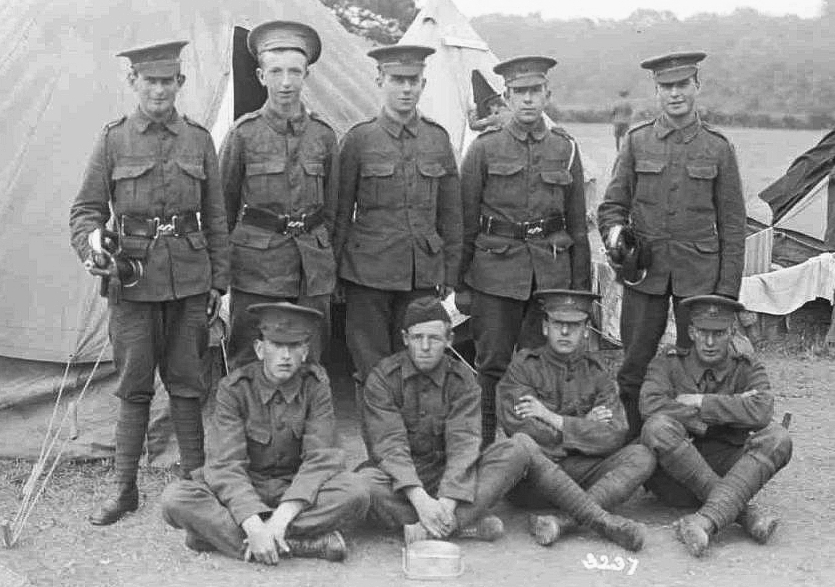
George Hance, back row second from
left.
The sad news was conveyed to his parents in letters from the
Captain of his Company, and from the Rev. J. R. Foster, Chaplain
to the Brigade. The commanding officer said that Private
Hance was shot through the head by a machine gun, and died in a
few minutes.
Though he had not been in the Company long, he had shown
himself, in the opinion of his officer, a man to be relied on.
The Chaplain in a sympathetic letter, informed the parents that
their son was buried two miles behind the trenches, and that an
officer and some men of the Company attended the funeral
service.

George Hance on the left.
On Sunday at High-street Church, the Rev. Charles Pearce, C.F.,
referred in sympathetic terms to the death of George Hance, who
was a scholar in the Sunday School. Mr. Clement played the ‘Dead
March’ at the close of the service.”
George Hance’s great
nephew contacted me to say:
“Like
a lot of young men of the time, he joined up under age.
Most of his relatives who I spoke to were born after long after
his death, so never knew him. My grandfather never
mentioned him that I can remember. The one story that I
was told concerning him, for what it’s
worth, is that on the day he died, his mother swore she heard
him calling to her in the middle of the night and made her
husband go and unlock the door and check if he was there.
They wouldn’t
have found out what had happened for a day or two after that, I
guess.”
George is buried in the same cemetery as Harry Prentice.
Both were 18 years of age.
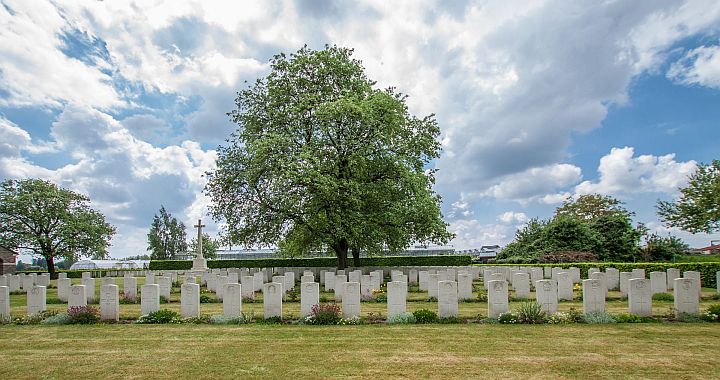
In the latter half of June 1916, men of the 61st (2nd South
Midland) Division began burying their fallen comrades at this
site, which became the Laventie Military Cemetery. Over 80
members of the Division who were killed or mortally wounded
during the Battle of Fromelles (19th July 1916) were laid to
rest here, and the cemetery was used by British units holding
this part of the line throughout 1916 and 1917. There are
now almost 550 war casualties buried or commemorated here.
――――♦――――
LESLIE GEORGE HARDY
Corporal, 1st Battalion Coldstream Guards, service no. 11268.
Born in Tamworth. Son of Samuel of Woodbrook Cottage, Forest
Road, Loughborough
and the late Susan Lavinia.
Enlisted at Stafford. Killed in action on the 8th October
1915, aged 20.
Buried in Quarry Cemetery, France, grave ref. A.1.
The Coldstream Guards is the oldest regiment in continuous active
service in the Regular Army. Its origin lies in the English
Civil War when Oliver Cromwell gave Colonel George Monck permission
to form his own regiment as part of the New Model Army. Monck
took men from the regiments of George Fenwick and Sir Arthur Haselrig, five companies each, and on the 23rd August 1650 formed
Monck’s Regiment of Foot. Less than two weeks later this
force took part in the Battle of Dunbar, at which the Roundheads
defeated the forces of Charles Stuart. In
1670 the regiment adopted
the name The Coldstream Regiment of Foot Guards. This was
changed to The 2nd Foot Guards in 1782 and to The Coldstream Guards
in 1855.
In August 1914 the three Coldstream Battalions deployed to France,
where they saw action at Mons, the Marne, and the Aisne before being
committed to the defence of Ypres where the 1st Battalion was almost
annihilated at the Battle of Gheluvelt (31st October 1914).
For the remainder of the war the Regiment maintained four Battalions on active
service on the Western Front, [Note] where they fought in the major battles
of Loos (1915), the Somme (1916)
[Note], Passchendaele and Cambrai (1917),
Arras and in the Great Advance (1918). [Note]
In September 1915 the French and British armies launched a major
offensive on the Western Front, intending to break through enemy
lines and strike a decisive blow against the German army.
While French forces attacked in Champagne and Artois, the British
First Army attacked along a ten-kilometre front between Loos and La
Bassée. This was the British army’s largest effort of the war
so far, with 75,000 men involved on the first day alone. It
became known at the time as “the Big Push”.
The Battle of Loos
(25th September–8th October, 1915), as it has since been named,
rather than being a big push was a big disaster. The
casualties – including some 8,500 dead – on the 25th September were the worst yet
suffered by the British army in a single day. In total, the battle resulted in casualties of over
50,000, of whom some 16,000 lost their lives. Sir John French,
[Note] Commander-in-Chief of the
British Expeditionary Force, [Note] was recalled shortly after to be
replaced by Sir Douglas Haig. [Note]
The 1st Bn. Coldstream Guards (2nd Guards Brigade), [Note]
in which Corporal Hardy served, was involved in the fighting. The following extract from The Guards
Magazine, Journal of the Household Division (edition Summer 2017)
recalls one heroic episode during the German counterattack on the
8th October:
“The Battle of Loos is one of those First
World War battles that seems to exemplify all the worst aspects of
that terrible war. Much was expected of this offensive, ‘The
Big Push’ as it was named at the time, but it was to be a costly and
futile endeavour that later provided a touchstone for many of the
harshest judgements of the war. The tragedy was that the
Allies were still struggling to come to terms with this new kind of
warfare. They had yet to grasp the basic mechanics of
attacking strong fixed defences, and yet ‘attack’ seemed the only
option . . . .
. . . . Sometime around 4pm on 8th October, the Germans launched an
attack along 2nd Guards Brigade’s [including 1st
Bn. Coldstream Guards] front-line,
with most of the attack concentrating just south of the Hohenzollern
Redoubt. [Note]
Two companies of the 3rd Grenadiers were attacked along a
communication trench running east and west of their positions, and
soon they had exhausted their supply of bombs. The turning
point of the engagement came with the action of Lance Sergeant
Oliver Brooks, [3rd Battn.]
Coldstream Guards, who organised a bombing party and
proceeded to drive the Germans back, bombing them out of their
trenches. By 7pm the line had been recovered and the
Grenadiers were able to consolidate their positions. For this
brave action, Sergeant Brooks was later awarded the Victoria Cross.” |
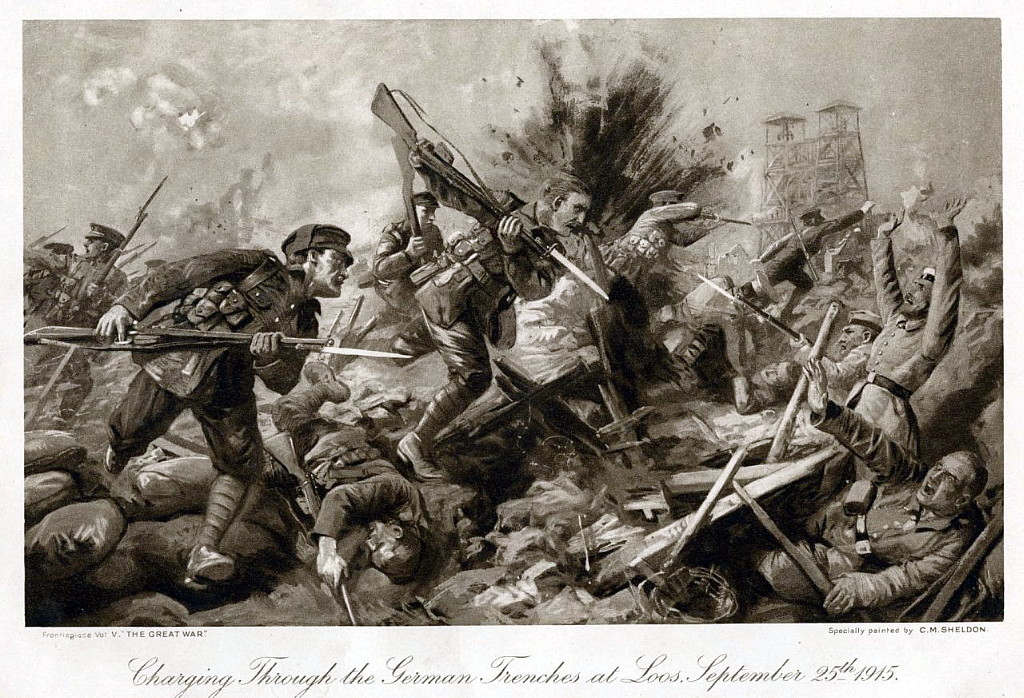
At noon on the 8th October, the German guns commenced a bombardment
along the entire front between Lens and the La Bassée Canal.
It lasted until 4pm and it is likely that Corporal Hardy was killed
in the shelling. This from the Bucks Herald, 30th October 1915:
“News has been received of the death of
Leslie George Hardy, Coldstream Guards, son of Mr. S. Hardy,
secretary of the Tring Co-operative Society.
Corporal hardy, when war broke out, was working as an electrical
engineer, but as once enlisted in the Coldstream Guards, and, after
about two months’ training, was sent to France, where he has been,
except for a short leave a few weeks ago, ever since. He was
all through the stiff struggle for the Brick Kiln, and the recent
heavy fighting around Loos. He was apparently killed
instantaneously by shrapnel in one of the reserve trenches, and
buried the same day. His friends all speak of him as a
particularly bright and good soldier.”
From the Parish Magazine November 1915:
“News has been received of the death of
Leslie George Hardy, Coldstream Guards. Corporal Hardy, when ware
broke out, was working as an electrical engineer. He at once
enlisted in the Coldstream Guards, after about two months training,
was sent to France, where he was been except for a short spell of
leave a few weeks ago.
He took part in the stiff struggle for ‘The Brick Kiln’ in the
recent heavy fighting around Loos.
He was apparently killed instantaneously by Shrapnel whilst in the
reserve trenches and was buried the same day. His friends
speak of him as a particularly bright and good soldier.
May he rest in peace.
Note: Leslie George Hardy was employed by The Rothschild Estate at
the [Electricity]
generating station at the Silk Mill, Brook Street, Tring.”
In the 1911 Census, George Hardy was listed living at 109
Corporation Street, Stafford, with his father Samuel (aged 54) and
sister Laura (aged 23, School Teacher).
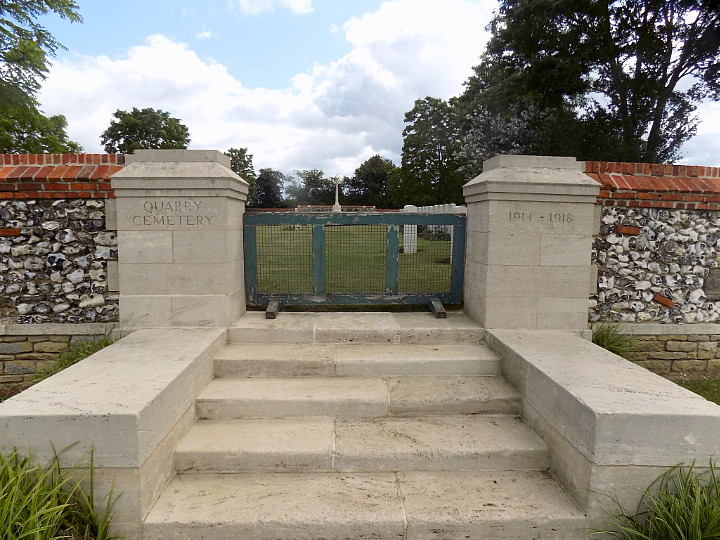
Some 500 metres to the east of Quarry
Cemetery was the formidable German strongpoint
known as the Hohenzollern Redoubt.
[Note]
Quarry Cemetery was begun at an advanced dressing station in July
1916, and used until February 1917. The Germans buried a few
of their dead in Plot V in April and May 1918. At the
Armistice it consisted of 152 graves in the present Plots V and VI.
It was then increased when graves (almost all of July-December 1916)
were brought in from the battlefields surrounding Montauban and
small burial grounds. The cemetery now contains 740
Commonwealth burials and commemorations of the First World War.
157 of the burials are unidentified but there are special memorials
to seven casualties known or believed to be buried among them.
――――♦――――
CHARLES HARROWELL
Private, 1st Bedfordshire Regiment, service no. 14280.
Born in Tring. Son of Eli and Elizabeth Harrowell of 17
Langdon Street, Tring.
Formerly employed as a clerk with the London and North Western
Railway.
Enlisted at Hertford. Killed in action on the 19th April 1915,
aged 19.
No known grave. Commemorated on Ypres (Menin Gate) Memorial,
Belgium, panel 31 and 33.
The original soldiers of the 1st and 2nd Battalions of the
Bedfordshire Regiment were amongst the ‘Old Contemptibles’ [Note],
the title proudly adopted by the men of the original British
Expeditionary Force (B.E.F.) [Note] who saw active service before 22nd
November 1914. On mobilisation the 1st Battalion formed
part of 15th Infantry Brigade in the 5th Division.
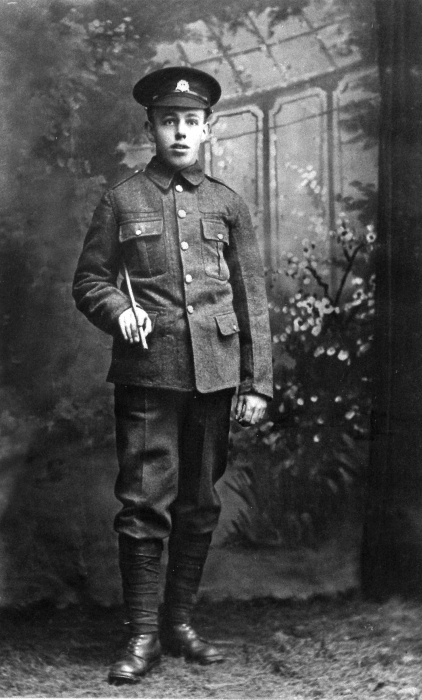
Private Charles Harrowell, 1st
Bedfordshire Regiment.
Private Harrowell is believed to have been killed during an
action south of Ypres, now known as the Battle of Hill 60 (17th
April–7th May 1915), which was fought to regain a prominent
piece of high ground that had been captured by the Germans
during the First Battle of Ypres. In the first British
operation of its kind the Royal Engineers employed experienced
miners from Northumberland and Wales to dig tunnels under Hill
60 in which were laid explosive charges.
The British attack began on the 17th April when the first pair
of mines were blown and the rest followed ten seconds later –
débris from the explosions was flung almost 300 feet into the
air and scattered for 300 yards in all directions. The
hill was captured quickly, most of the German platoon holding
their front line having been killed and the survivors
overwhelmed – the British suffered only seven casualties.
However, it was then found that the salient that had been
created made the occupation of Hill 60 very costly.
In attacks in early May – which included the use of gas shells – the Germans recovered the ground, which they then held until the
Battle of Messines in 1917 (when the British
detonated a much larger mine beneath it).
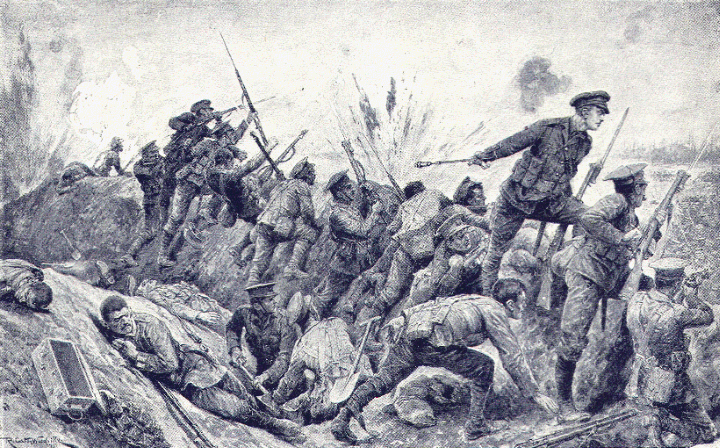
Artist’s impression of the British
defending Hill 60 (helmets came in April 1916).
This extract is from the 1st Bedfordshire Regiment War Diary [Note] for
April 1915:
[The Battle of Hill 60]
“17 Apr: Headquarters 13th Inf. Bde arrived & took over command of
sector. R. W. Kent Regt. & K. O. S. B. arrived & went into
dugouts & part of front trench. 2 companies of Bedfords
withdrawn into support to make room for 13th Bde. 7 pm.
precisely, 6 mines under Hill 60 exploded in 3 groups of two
each. [Note]
Heavy Artillery bombardment commenced, & Hill 60 rushed by
British (R.W.K)
18 Apr: Enemy counterattacked during early morning.
Casualties considerable. 2 Companies Bedfords recalled in
afternoon & counter attack on Hill 60 (part of which had been
lost by 13th Bde) commenced at 6 pm. Line re-established
on Hill 60. G.O.C. 13th Bde. handed over immediate control
of sector to Lt. Colonel Griffith D.S.O. (Bedf. Regt.) &
withdrew with staff to point about a mile in rear.
[Private Harrowell killed this day]
19 Apr: Front line occupied
in early morning by Bedfords & 1/East Surrey Regt. Work
carried out under difficulties to consolidate position on Hill
60. Considerable shelling and bombing by enemy.”
20 Apr: Enemy counter attacked: tremendous
bombardment carried out against Hill 60, & our trenches &
supports. Enemy’s heavy guns enfiladed [Note]
position, other guns firing from various directions: bombardment
all night.
21 Apr: Reningelst [approx 6 miles
south-west of Ypres]. Bombardment &
counter attacks continued during early morning & position
critical at times. Casualties very heavy. Enemy’s machine
guns partially enfiladed reverse of Hill 60, trench mortar
bombarded it, & field guns were brought up to within about 30
yards & fired point blank at parapet, blowing it to pieces &
mangling the defenders. Our artillery unable to compete
with enemy’s heavy guns, or to locate small guns which were too
close to Hill 60 to be easily shelled. Casualties of
Bedfords 4 officers killed, 8 wounded. Other ranks over
four hundred. Cameron Highlanders & 1 Devons arrived
during morning & relieved E.Surreys & Bedfords who went into
reserve at RENINGHELST for sleep & rest.
Lieut. John Boyer Webb and 2nd/Lieut. William Bernard Knight of
the 4th Battn. Prince Of Wales (attached to the Bedfords) were
two of those killed, as were Act/Capt. Charles Sidney Kirch and
2nd/Lieut. Esmond Lawrence Kellie. Major Walter Allason
was also wounded. Almost 100 Other Ranks were also killed
between the 18th and 21st April, with several hundred more
wounded. This from the Bucks Herald 8th May 1915:
“Another Tring lad has given his life
for King and country. Private Charles Harrowell, son of Mr. Eli
Harrowell, of Langdon-street, Tring, was drafted into the 1st
Bedfordshire Regiment, and went out with the Expeditionary Force
in February this year. He was in the fighting at La Bassee,
where he had a narrow escape. He was buried in the earth
by the explosion of a German shell, and had his to coat blown to
pieces. He, however, escaped uninjured. On April
19th he was killed in action, most probably in one of the
historic battles which ranged round Hill 60, though the official
intimation of his death which his parents have received gives no
information on this point. Private Harrowell was only 19,
and before joining the Army was engaged as a relief clerk on the
L. and N.-W. Railway, where his prospects of promotion were
excellent. A bright, cheerful young fellow, he was
extremely popular with all who knew him. Great sympathy is felt
for his parents. His mother is prostrated by the sad
news.”
The 1911 Census lists Charles living at 17 Langdon Street with
his parents, Eli (aged 48, a bricklayer) and Elizabeth (aged
48), and his siblings, Ellen (aged 22), Elizabeth
(aged 13) and Frank (aged 11). Other siblings that appear
on the 1901 census are George (born 1882), James (born 1885) and
Annie (born 1891). James, by them a married man, was
killed in action on the 22nd October 1917 (see next entry).
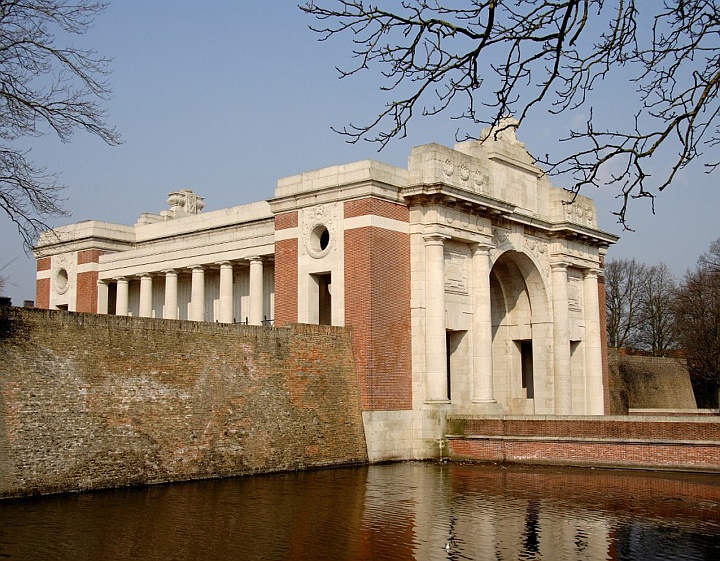
The Menin Gate is one of four memorials to the missing in
Belgian Flanders which cover the area known as the Ypres
Salient.
The site of the Menin Gate was chosen because of the hundreds of
thousands of men who passed through it on their way to the
battlefields. It commemorates casualties from the forces
of Australia, Canada, India, South Africa and United Kingdom who
died in the Salient. In the case of United Kingdom
casualties, only those prior the 16th August 1917 (with some
exceptions). United Kingdom and New Zealand servicemen who
died after that date are named on the memorial at Tyne Cot, a
site which marks the furthest point reached by Commonwealth
forces in Belgium until nearly the end of the war.
The Ypres (Menin Gate) Memorial now bears the names of more than
54,000 officers and men whose graves are not known, among which
is that of Private Charles Harrowell. The memorial,
designed by Sir Reginald Blomfield with sculpture by Sir William
Reid-Dick, was unveiled by Lord Plumer on the 24th July 1927.
――――♦――――
JAMES HARROWELL
Rifleman, 9th King’s Royal Rifle Corps, service no. R/24249.
Enlisted at Watford. Killed in action on the 22nd October 1917
aged 32.
Born in Tring. Son of Eli and Elizabeth Harrowell of 17
Langdon Street, Tring.
Husband of Caroline of 40 Wingrave Road, New Mill, Tring.
No known grave. Commemorated on Tyne Cot Memorial, Belgium,
panels 115
to 119 and 162A and 163A.
For more than 200 years the KRRC served throughout the British
Empire. During the First World War the regiment raised 22
battalions and saw action on the Western Front, [Note] in Macedonia and
in Italy – 12,840 men on its strength were killed and it won 60
battle honours including 7 Victoria Crosses.
The 9th (Service) Battalion was formed at Winchester in August
1914 as part of K1 [Note] coming
under the 42nd Brigade in the 14th (Light) Division. [Note]
On the 20th May 1915 the battalion landed at Boulogne. It
then took part in various actions on the Western Front
including, during 1915, The Action of Hooge and The Second
Attack on Bellewaarde; during 1916, The Battle of Delville Wood
and The Battle of Flers-Courcelette; during 1917, The German
retreat to the Hindenburg Line, The First and Third Battles of
the Scarpe, The Battle of Langemark and The First and Second
Battles of Passchendaele; and, in 1918, The Battle of St Quentin
and The Battle of the Avre.
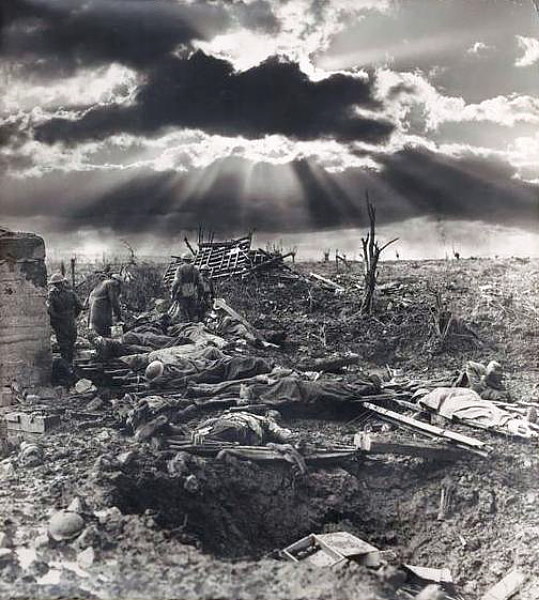
The day following 1st Passchendaele.
In 1917, the 14th (Light) Division – to which Lance-Corpl.
Harrowell’s battalion was attached – formed part of X Corps, 2nd
Army. In June, X Corps took part in the Battle of Messines
and then in the 3rd Battle of Ypres, which included 1st
Passchendaele (12th October 1917) and 2nd Passchendaele (26th
October-10th November). The capture of the Passchendaele
Ridge took over 8 weeks to achieve at the immense cost to both
sides of between 200,000 and 400,000 casualties (military
historians continue to debate the exact figures). The
great tragedy for the British and Imperial forces who fought for
the few miles from Ypres to the Passchendaele Ridge, is that
five months later almost all of the ground gained at such
terrible cost was recaptured by the German Army during its April
1918 offensive.
Judging by the date of his death and the known involvement of
the 14th (Light) Division at that time, it seems likely that
Lance-Corpl. Harrowell was killed in fighting or in artillery
barrage that took place between the two main battles of
Passchendaele. This from the Bucks Herald, 10th November 1917:
“ROLL OF HONOUR.
– We regret to announce that Mr. Charles Harrowell, of
Langdon-street, has been notified by the War Office that his
son, Lance-Corpl. James Harrowell, of the King’s Royal Rifles,
was killed in action on October 22. An old Volunteer and
later a Territorial, Lance Corpl. Harrowell did some years’
service, and only retired a few months prior to the war on
taking up a partnership with his brother at Chesham, where they
carried on an improving business as builders and contractors.
The deceased was called up in May, 1916, and nine weeks later
went to France, where he saw service until he met his death last
month.
He was formerly a foreman bricklayer in the employ
of Mr. Jesse Mead, of Chesham, and was an active member of the
Chesham Trade and Labour Council. The news of his death
has been received with profound regret by his many friends, and
the deepest sympathy is felt with his wife and parents,
especially as this is the second loss sustained by the family,
his brother Charles Harrowell, Bedford Regiment, having been
killed at Hill 60 in April, 1916 [1915].
Lance-Corpl. Harrowell was 33 [32]
years of age, and married Miss Johnson, of New Mill.”
From the Parish Magazine:
“Husband of Caroline Harrowell of
Tring, Herts.
James Harrowell, Lance Corporal, 9th Bn. K.R.R.C. was killed in
France on October 22nd. He was for many years a member of
the Old Volunteer Corps, and afterwards in the Hertfordshire
Territorial Regiment leaving with the rank of Lance Corporal at
the end of his engagement. He often won cups for shooting,
and twice held the bugle, presented to the best shot in the
Corps. The National Rifle Association also awarded their
badge for Skilled Shooting.
He joined the Army, finally in May 1916, and was sent to France
in August 1916 and never returned to this country. Those
who knew him best, speak of him in the highest terms. His
Lieutenant writing to his wife, says: ‘Your husband was in my
platoon and throughout my acquaintance with him, I had a fine
sense of his many and excellent qualities, both as a soldier and
as a man. He was most deservedly popular with all his
comrades and I feel the platoon has sustained an irreparable
loss through his decease. I trust it will be of some
consolation in your grief, to think he died as every Englishman
is proud to do, in these days of trial.’”
In 1939, James’ widow Caroline (born 1882) was living with her
unmarried sister Emily (born 1884) at 40 Wingrave Road, Tring.
She died in 1974.

The Tyne Cot Memorial, on which Lance-Corpl. Harrowell is
commemorated, is one of four memorials to the missing in Belgian
Flanders that cover the area known as the Ypres Salient.
The Salient was formed during the First Battle of Ypres in
October and November 1914, when a small British Expeditionary
Force [Note] succeeded in securing the town before the onset of winter,
pushing the German forces back to the Passchendaele Ridge.
The Second Battle of Ypres began in April 1915 when the Germans
released poison gas into the Allied lines north of Ypres.
This was the first time gas had been used by either side and the
violence of the attack forced an Allied withdrawal and a
shortening of the line of defence.
There was little more significant activity on this front until
1917, when in the Third Battle of Ypres an offensive was mounted
by Commonwealth forces to divert German attention from a
weakened French front further south. The initial attempt
in June to dislodge the Germans from the Messines Ridge was a
complete success, but the main assault north-eastward, which
began at the end of July, quickly became a doggèd struggle
against determined opposition and the rapidly deteriorating
weather. The campaign finally came to a close in November
with the capture of Passchendaele.
The Tyne Cot Memorial now bears the names of almost 35,000
officers and men whose graves are not known. A further
11,961 Commonwealth servicemen are buried or commemorated in
Tyne Cot Cemetery, 8,373 of whom are unidentified.
――――♦――――
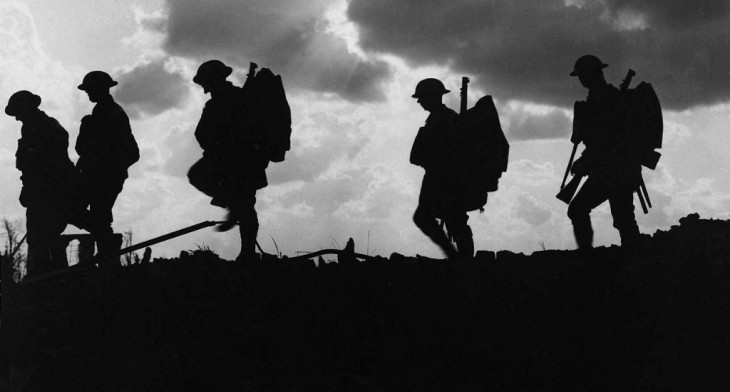
Men of the 8th Battalion, East Yorkshire
Regiment, going up to the line near Frezenberg
during the Battle of
Broodseinde, 1917.
Photo by Ernest Brooks.
JOACHIM CHARLES HARTERT
Lieutenant (Temp), 8th East Yorkshire Regiment.
Born in Tring, educated at Berkhamsted School and Oxford.
Son of Dr. Ernst and Claudia Hartert of ‘Bellevue’, Park Road,
Tring.
Killed in action on the 28th October 1916, aged 22.
Buried in Courcelles-Au-Bois Communal Cemetery Extension, France, grave ref. A12.
|
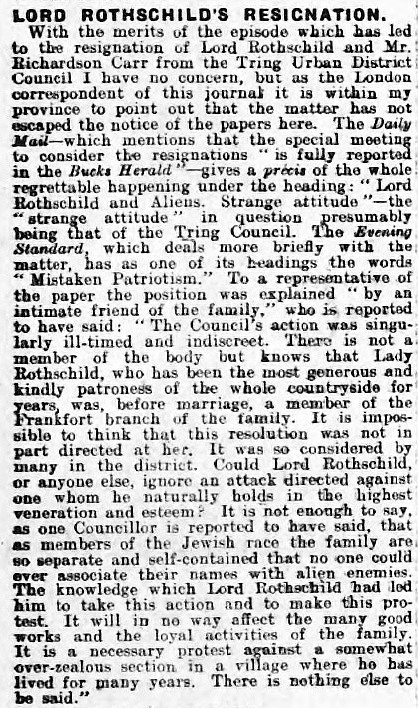 |
|
Buck Herald 24th
June 1916. |
Charles’ father Ernst Hartert, together with Karl Jordan, were
employed by Lord Rothschild as joint Curators of the Tring Natural
History Museum. Both, German by birth, were criticised by certain
elements of the town’s people of Tring due, no doubt, to the great
number of British losses sustained in the war. There was even
resentment felt again Lord Rothschild, a great local benefactor
during his lifetime (see Bucks herald article). Although there
was opposition to the addition of Joachim Charles Hartert to the
roll of honour and the war memorial, this was overcome, but Charles’
the full name does not appear on his grave stone, the roll of
honour book and the war memorial. It does appear in
Commonwealth war Grave Commission records.
The 8th (Service) Battalion [Note]
was formed at Beverley on the 22nd September 1914 as part of K3, [Note]
62nd Brigade in the 21st Division [Note]),
initially being based at Tring (Halton Park [Note]).
In September 1915 the battalion mobilised for war. Having
landed at Boulogne, it was soon engaged on the Western Front [Note] including the main action of the dreadful Battle of Loos. In
November 1915 the battalion transferred to the 8th Brigade in the 3rd
Division. The 3rd Division was among the first British
formations to move to France as part of the original British
Expeditionary Force [Note] and one of
the first into action. It remained on the Western Front
throughout the war taking part in most of the major actions
including, during 1916, The Actions of the Bluff and St Eloi
Craters, The Battle of Albert, The Battle of Bazentin, The Battle of
Delville Wood and The Battle of the Ancre.
Lieut. Hartert was killed by artillery fire on the 28th October
1916, his battalion then being engaged in the Battle of the Somme. [Note]
Although it isn’t clear on which part of the battlefield he lost his
life, it was probably in the vicinity of the River Ancre (also
suggested by the cemetery history below).
The following extract is from the War Diary, the 8th
Battalion being in the trenches of the SERRE Sector:
|
 |
|
Joachim Charles Hartert
(1893-1916) |
“1916
SERRE Sector
18th Oct to 31st Oct: Provided usual working &
carrying parties to trenches. On the 20th a practice attack was
again carried out over specially marked area, as a unit of the
Brigade. On the 23rd the practice attack was again carried out by
the Division. On the 27th. ‘A’, ‘B’ & ‘C’ Coys proceed to the
trenches in the SERRE Sector. ‘B Coy. was attached to the 1st
Gordon Highlanders & ‘A’ & ‘C’ Companies were attached to the 1st
Battn. Northumberland Fusiliers of the 76th Brigade – During a tour
lasting 48 hours, casualties numbering 2 officers & 8 other ranks
were sustained. In the 2 Officer Casualties (Captain C. P. Taylor
& Lieut. J. C. Hartert, killed in action, 28/10/16) the
Battalion lost two of its original Officers.
29th Oct: H.Q. & ‘D’ Company, left Billets at
BUS-LES-ARTOIS & proceeded to COURCELLES-AU-BOIS to Billets in Barns
and Houses. Here they were joined by ‘A’, ‘B’ & ‘C’ Coys. who
were relieved from the line.
COURCELLES
30th Oct: Usual working parties. A raid which had been
organised on the enemy trenches, & which was intended to take place
this night, was canelled owing to inclement weather & the sticky
state of the ground.
31st Oct: Working parties. Raiding Party again
proceeded to trenches and the raid was carried out. No prisoners
were taken and we suffered casualties of 1 officer and 10 O. Ranks
(Wounded).”
From the Bucks Herald, 11th November 1916:
“Lieut. J. C. Hartert: In Monday’s Roll of
Honour appeared the official announcement that Lieut. J Charles
Hartert, East Yorkshire Regiment, had been killed. The sad
news had reached Tring on the previously Wednesday night.
Lieut Hartert was the only child of Dr E. Hartert, curator of Lord
Rothschild’s Zoological Museum. He was educated at Berkhamsted
School, and is well remembered in cricketing circles here as a keen
and competent exponent of the national game. He was frequently
seen in the Tring Park Ground, where he not only played for his
school, but also assisted the local club, of which he was a member.
A young man of modest bearing and amiable disposition, and a keen
sportsman, he is very kindly remembered by all with whom he came in
contact.
He gained a commission, and was posted to the East Yorks. in the
early days of the war. At the time the 21st Division, of which
his regiment was a unit, was training in the district. He went
out to France with the Division, and only a few weeks ago he was
home on leave. Now he has made the supreme sacrifice.”
From an unknown source:
“Charles Joachim Hartert Killed Oct 28th
1916.
‘Soldiering together’, writes one of his
brother officers, ‘I got to know him extremely well. He was
always so keen and hard working. He was a most excellent
billeting officer.’
‘He was the only officer on July 14th,’
says his CO, ‘to get into the German trenches, and it was mainly
through the gallant way he held on and fought his way along the
trenches that we were enabled to win through. I forwarded his
name for an honour for this, and I hope it will materialise, but
there are so many recommended, and the rewards are few. His
captain was killed by the same shell,’ says Col. Way.
‘I have lost one of our oldest, and best
officers and one of my best friends. He was with the battalion
in all its many engagements from Loos onwards and has always
distinguished himself by his coolness and courage’ is the testimony
of Capt. Ball.
‘I cannot tell you how greatly your son is
missed here’ says his chaplain. ‘I always felt he had an
excellent fund of cheerfulness, when things were most trying (and we
had been through so much), and I know too, he valued the deeper
sources of hope. R.I.P.’”
From the Wadham College Gazette, 1916.
“Killed in action on October 28, Joachim
Charles Hartert, Lt. East Yorkshire Regt. Commoner of the
College 1912-4.
J. C. Hartert came up from Berkhamsted to Wadham in 1912, and played
for the College both at Association and at Cricket. He was
also a keen member of the O.T.C. He was a German by birth, and
combined the thoroughness and industry of our enemies with the
vigour and energy of his adopted country. He took a commission
immediately the war broke out, and had been at the front for more
than a year, having been slightly wounded last July. He was a
man of real character and was considered one of the best officers in
his battalion.” |
.jpg)
.jpg)
Letter from Dr. Ernest Hartert to a Mr. Wells.
|
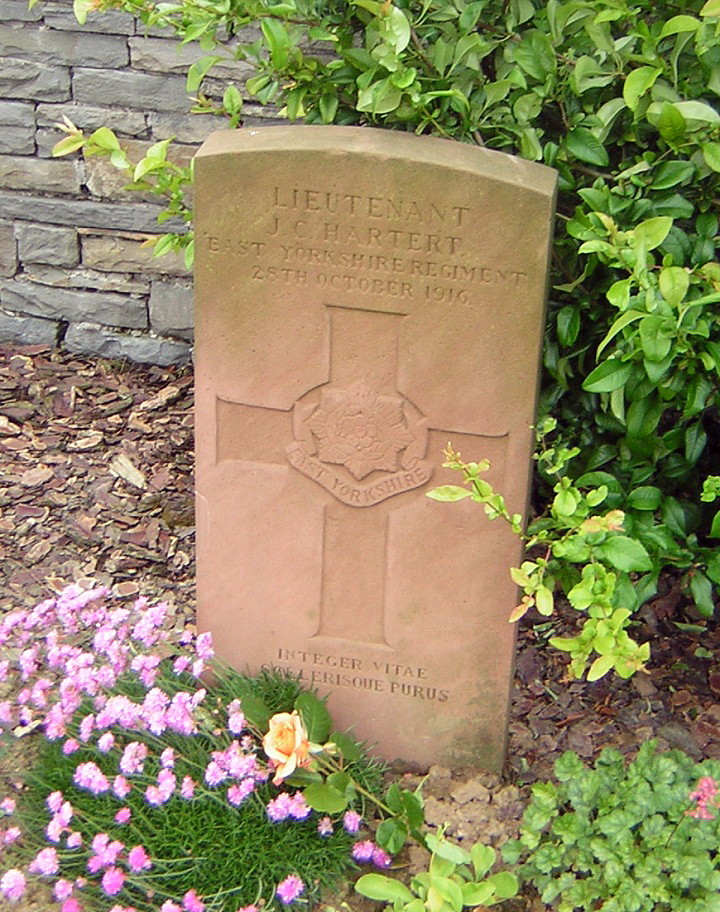
The Courcelles-Au-Bois Communal Cemetery Extension was opened in
October 1916 and used by field ambulances and fighting units
until March 1917, when the German Army withdrew from the Ancre.
It was used again in April 1918 during the German attack on
Amiens. The village was in German hands for some months,
but was retaken in August 1918. There are now 115 First
World War burials in the extension, including three brought in
from the communal cemetery in 1934. As with several other
cemeteries on the Somme, the headstones are made from red
sandstone.
――――♦――――
SIDNEY HAYSTAFF
Private, 87th Canadian Infantry Battalion, service no. 189993.
Killed in action on the 5th November 1918.
Buried in Valenciennes (St Roch) Communal Cemetery, France, grave ref. III.
A. 24.
During the early years of the 20th Century there being little work,
Lord Rothschild (Nathan Mayer Rothschild, 1st Baron Rothschild) helped
finance the emigration to Canada of a number of young men from the town.
It is likely that Sidney Haystaff was among them. When war broke out,
some joined the Canadian Expeditionary Force (CEF) and returned to
Europe to engage in some of the bloodiest conflicts on the Western Front, [Note] among which the Battle of Vimy Ridge (9th-12th April 1917) is the best known
of those in which Canadian forces played the leading role.
The 87th (Canadian Grenadier Guards) Battalion was a unit of the CEF.
Based in Montreal, Quebec, the unit began recruiting in September
1915 in Montreal, in the surrounding locality and in mining
districts elsewhere in the province. After sailing to England
in April 1916, the battalion was stationed there until August when
it crossed
to France, and for the duration of the war served in the 11th
Infantry Brigade, 4th Canadian Infantry Division. [Note] The Division
fought in many of the major actions of the war, including, during 1918,
The Battle of Amiens and actions around Damery, The Battle of
Drocourt-Queant (a phase of the Second Battles of Arras), The Battle of the
Canal du Nord and the capture of Bourlon Wood (a phase of the Battles of the
Hindenburg Line), The Battle of Valenciennes and the capture of Mont Houy,
and The Battle of the Sambre and the passage of the (river) Grand Honelle, a
sub-tributary of the River Scheldt in the vicinity of Valenciennes.
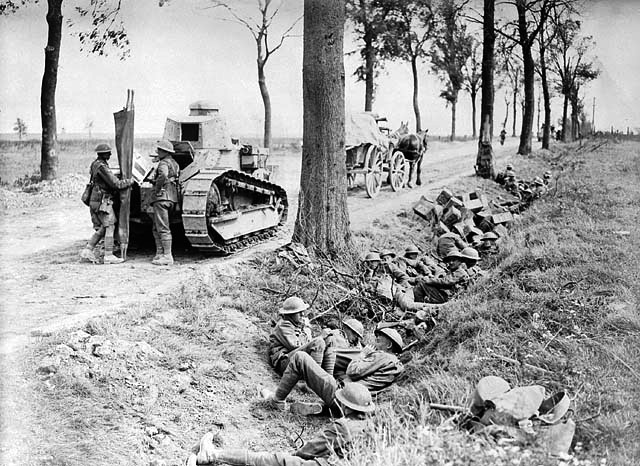
Canadian troops shelter in a ditch on the Arras-Cambrai
road, 1st September 1918.
Private Haystaff was killed in action on the 5th November, less than a week
before the Armistice. This period of the war (17th October–11th
November 1918) marked the final advance [Note] of the Allies in Picardy and was the
hardest-fought of the final offensive actions. The 1st, 3rd and 4th
Armies – which included the 87th Canadian Infantry Battalion – exploited
their success in breaking through the Hindenburg Line [Note] by pushing on across
the rivers Selle and Sambre, recapturing Valenciennes and finally liberating
Mons, where it had all begun for the BEF [Note] some four years earlier.
On the 5th November 1918 the 87th Canadian Infantry was at Estreux,
some 2 miles to the East of Valenciennes (the latter being the last French
city held by the Germans – it was captured by British and Canadian forces on
the 2nd November). The following extract is from the Battalion
War Diary, [Note] from which it must
be assumed that Private Haystaff is among the “8 O.R. killed” during
the tour, as recorded in the entry for the 6th November:
“ESTREUX
Nov. 5th: A conference of Company Commanders was
held at 0100 hours and Operation Order No. 146 was issued at 0300 hours.
The Battn. attacked with two companies of the 75th Battn. at 0530 hours and
by 0600 hours the Village of Rombies was reported cleared and Lieut. A. J.
Nicholson, Signalling Officer, was ordered to take Report Centre forward and
reconnoitre a Battn. H.Q. At 0900 hours Battn. H.Q. were established
at Rombies.
The enemy shelled Rombies fairly heavily during the day. The Adjutant
visited the Maire [Mayor] and
ascertained that there were 530 inhabitants. The Germans had taken
away all the live stock and most of the possessions, though they had bread
and potatoes and were not starving.
The Battn. was held up in front of Marchipoint [about 2 miles
north-east of Estreux] all day receiving fire from
both its flanks and its front, but the situation cleared towards evening and
Marchipoint was occupied about 1800 hours. Five persons belonging to
the 187th KIR [???] were taken.
Just before this orders had been received stating that the 102nd Battn.
would continue the operation through us in the morning and during the
evening arrangements were made with Major Ryan, who was commanding the 102nd
Battn. for the relief.
ROMBIES
Nov. 6th: Operations were continued during the night and ‘C’
Coy. established posts in the hamlet of MAISON ROUGE, having several
encounters with the enemy, who were there in some strength. Lieut. W.
H. Seath [???] established a post at
MAISON ROUGE about 0100 hours. He then took a patrol towards his right
to join up with ‘A’ Coy. A party of enemy estimated at 30 strong came
into the road [???] between him and his
post. After a quick reconnaissance he rushed the party, cutting his way
through and rejoining his post, which in the meantime had beaten off an
attack. He dispersed the enemy and inflicted casualties.
The 102nd Battn. went through the 87th Battn. at 0530 hours and we were
withdrawn to billets in ROMBIES. On the arrival of the 5th Brigade in
the afternoon, the Battalion moved back, marching through VALENCIENNES to
billets in BEUVRAGES, which we reached about 1930 hours.
Report on the operations by Major W. M. Kirckpatrick M.C., who commanded the
Battn. during the operations, is attached hereto as an appendix.
The following casualties were suffered during the tour: Lieuts. W. J.
Kavanagh, gassed; J. D. Cutting, wounded; A. Sutherland, wounded; J. L.
Bishop, wounded; H. F. Fogg, wounded; J. Baird, wounded. 8 O.R. killed, 26
O.R. wounded.
Material captured, 5 machine guns, 1 anti-tank rifle. Prisoners
captured, 7.”
.jpg)
.jpg)
.jpg)
From the Parish Magazine:
“Sidney Haystaff 87th Bn. Canadian Grenadier
Guards was killed in action on November 5th. Sidney had made
his home in Canada for the last fifteen years, he returned to fight
for his country in February of 1918. He was a member of our
church lads’ brigade in Mr Boswell’s days. He was a very
vigorous member for he took part in most of the famous displays of
these historic times and no doubt found that soldiering came
somewhat easier through the discipline he learn in our club rooms as
a boy. He sang in the choir at ‘the Little Church’, St Marthas.”
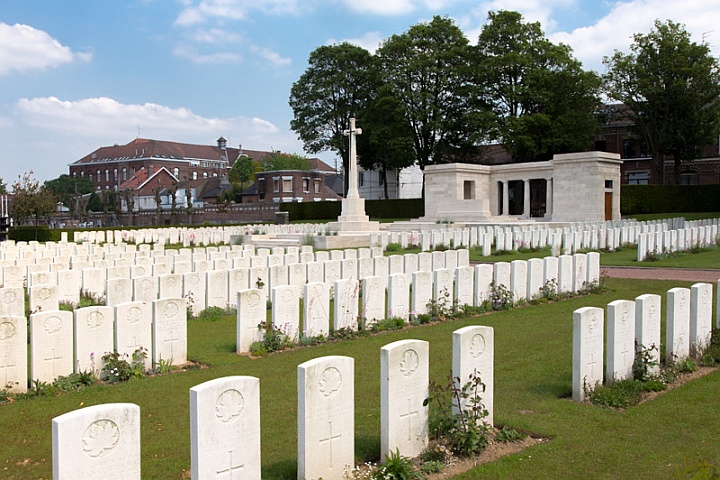
Valenciennes remained in German hands from the early days of the
First World War until 1st-2nd November 1918, when it was entered and
cleared by the Canadian Corps; 5,000 civilians were found in the
town.
Valenciennes (St Roch) Communal Cemetery now contains 885
Commonwealth burials and commemorations of the First World War, 37
of the burials being unidentified. Special memorials commemorate 19
casualties who died as prisoners of war, of whom nine are buried
here (Plot IV, Row A.) and ten at Le Quesnoy Communal Cemetery
Extension, none of whom could be individually identified; all are
therefore commemorated at both sites. Other special memorials
record the names of seven soldiers buried in other cemeteries whose
graves could not be found.
The cemetery also contains 34 burials from the Second World War, all
but one of them airmen.
――――♦――――
HAYWARD TO
PRATT |
|